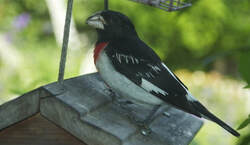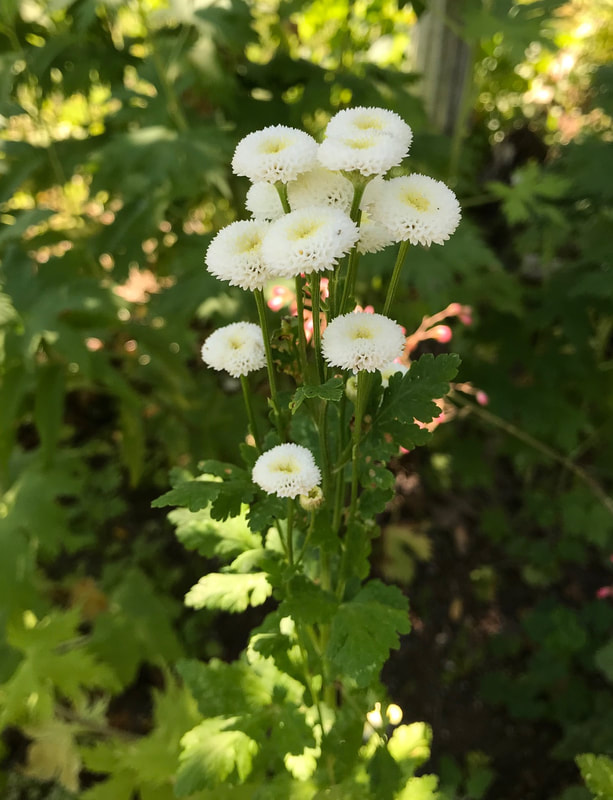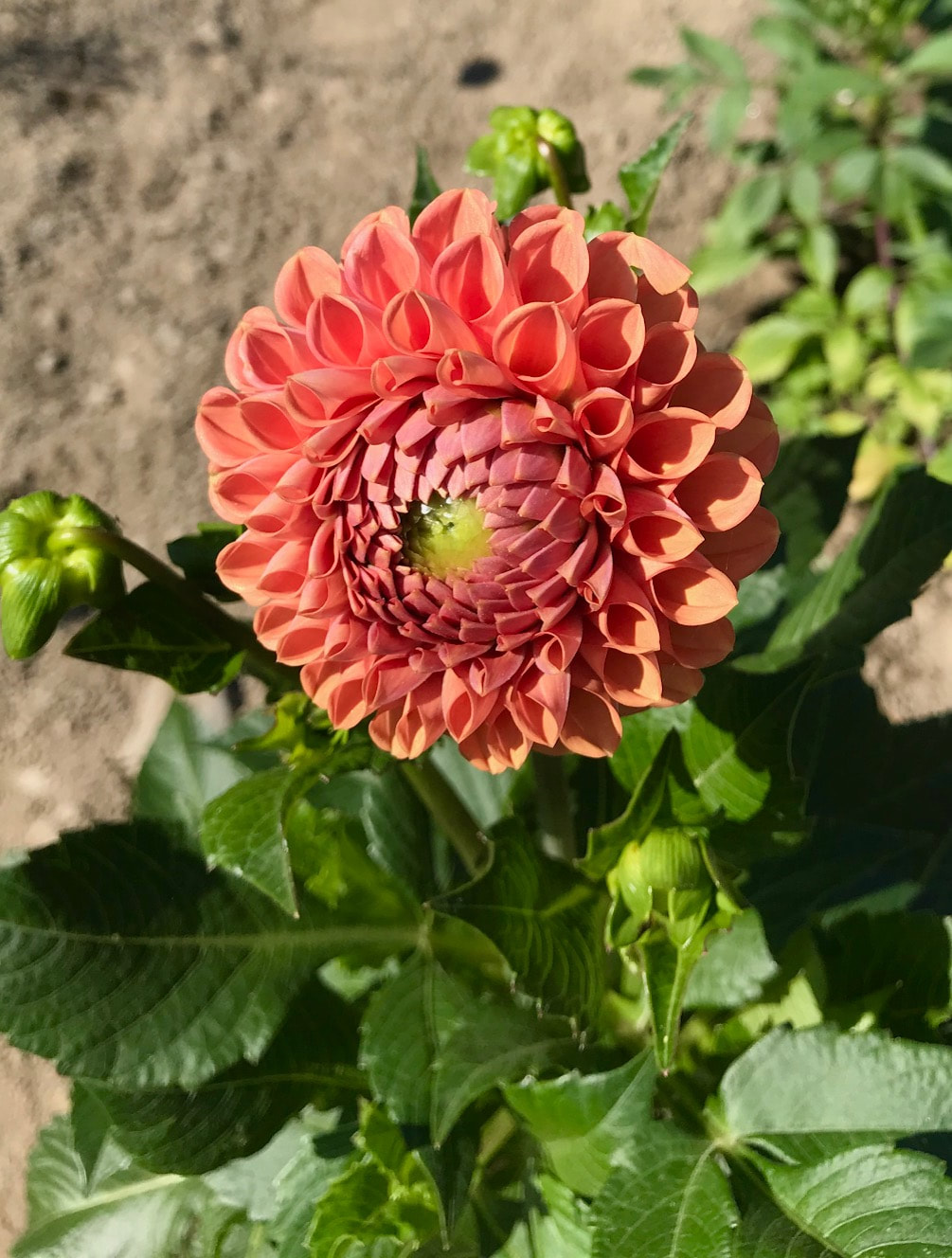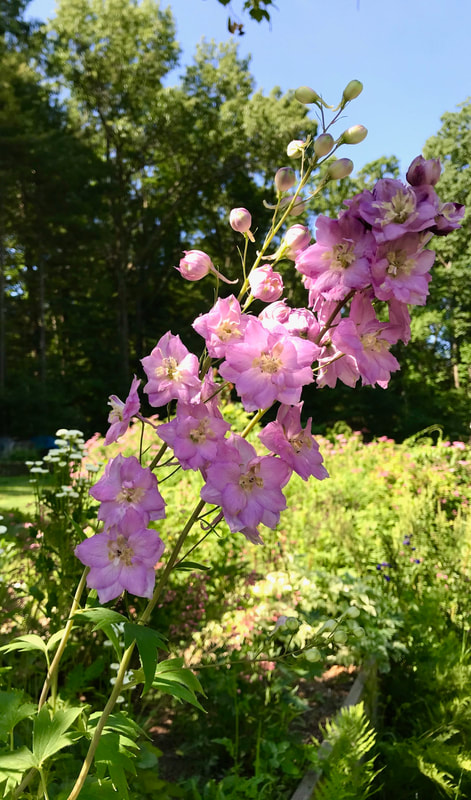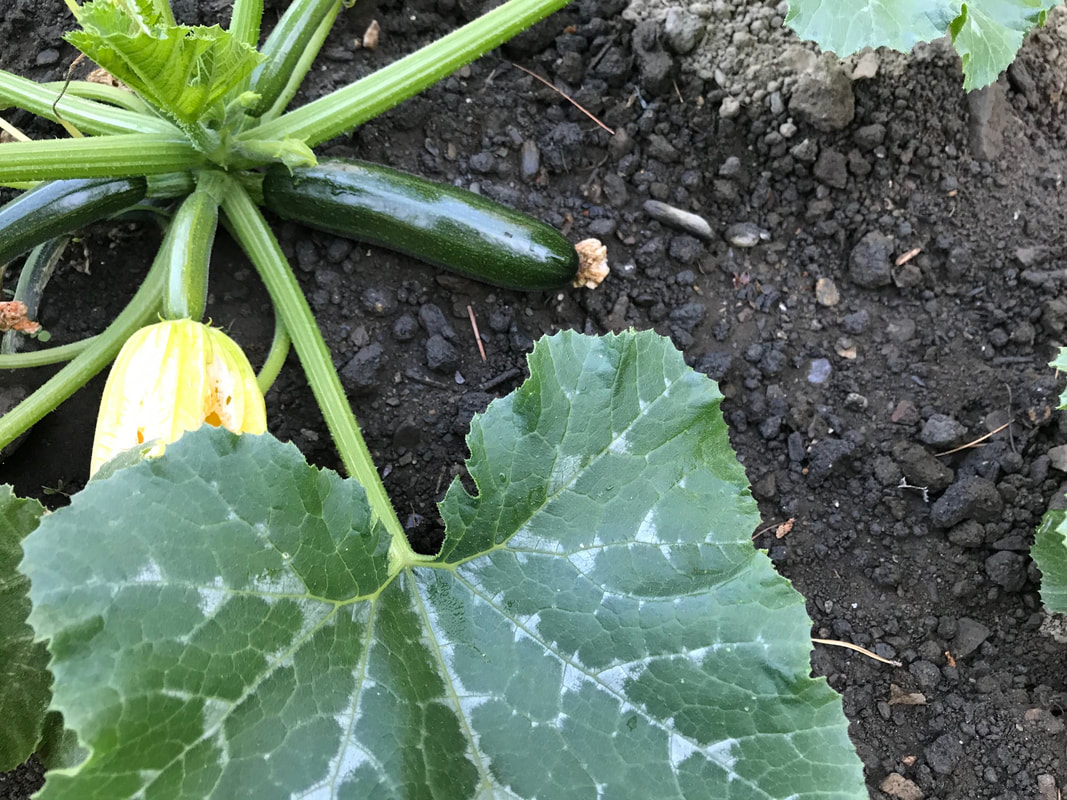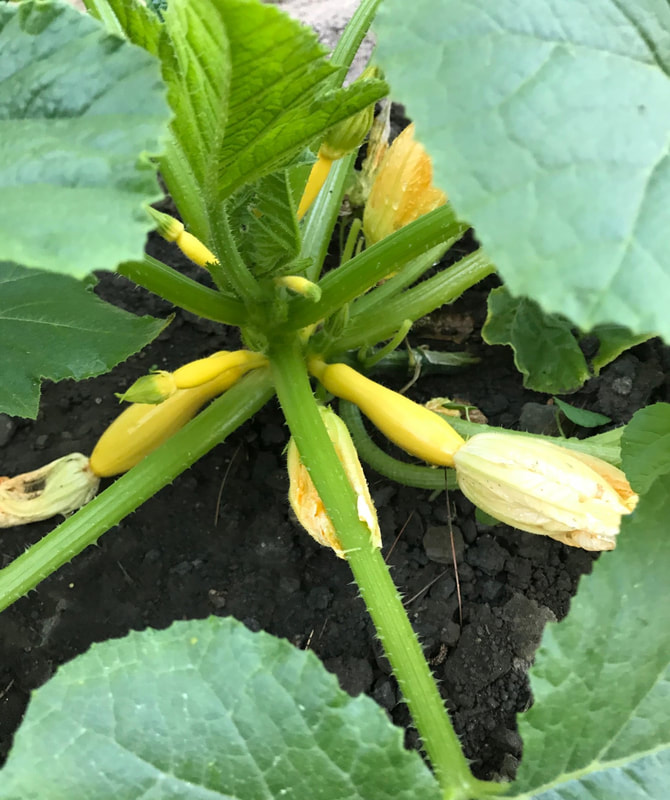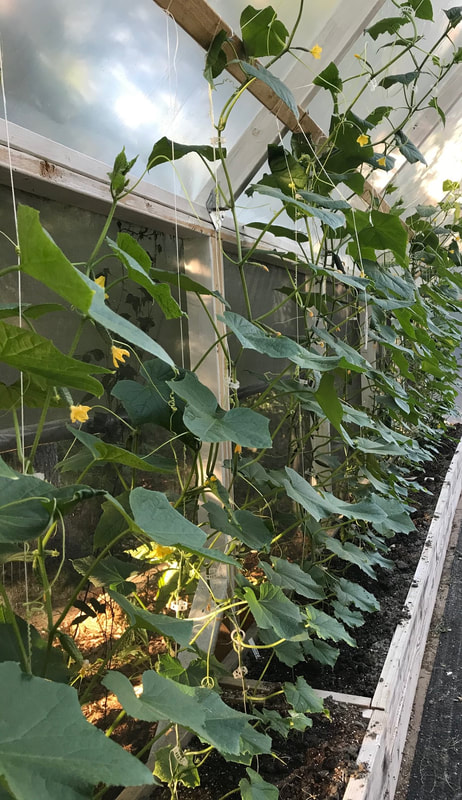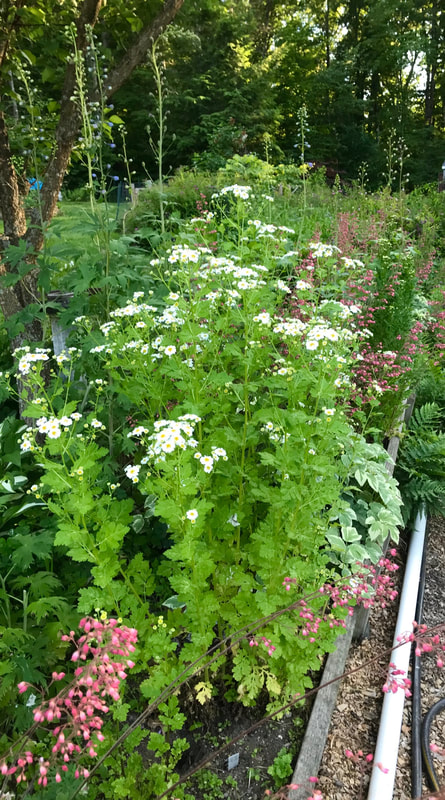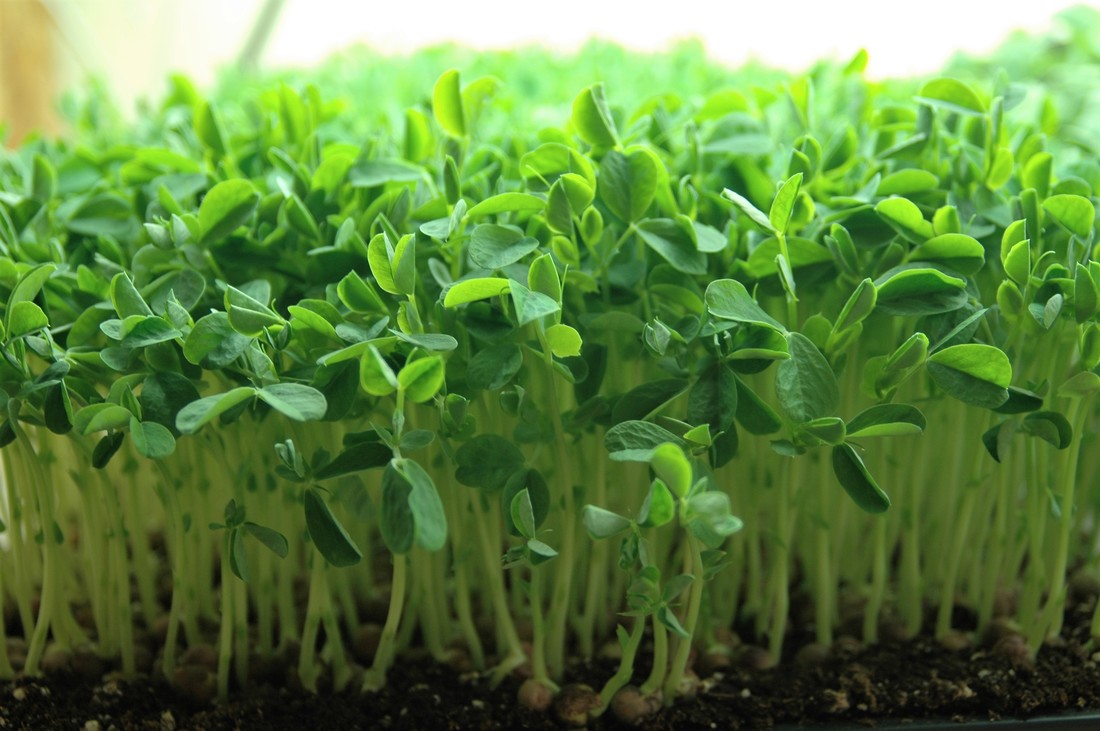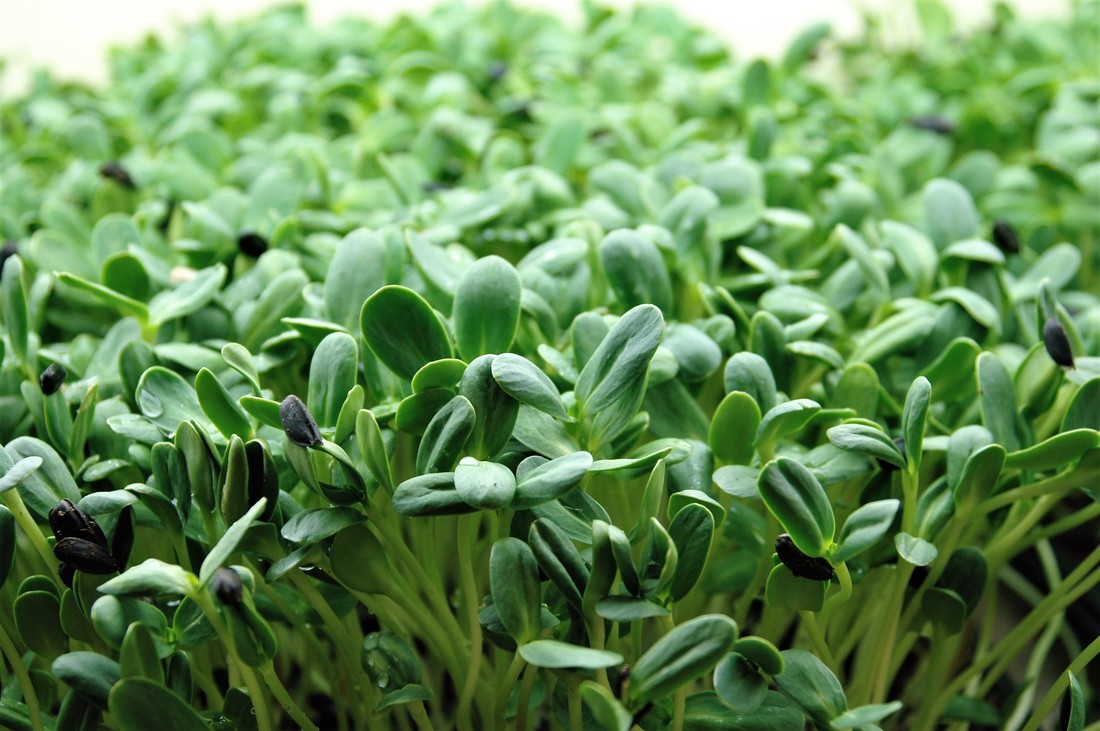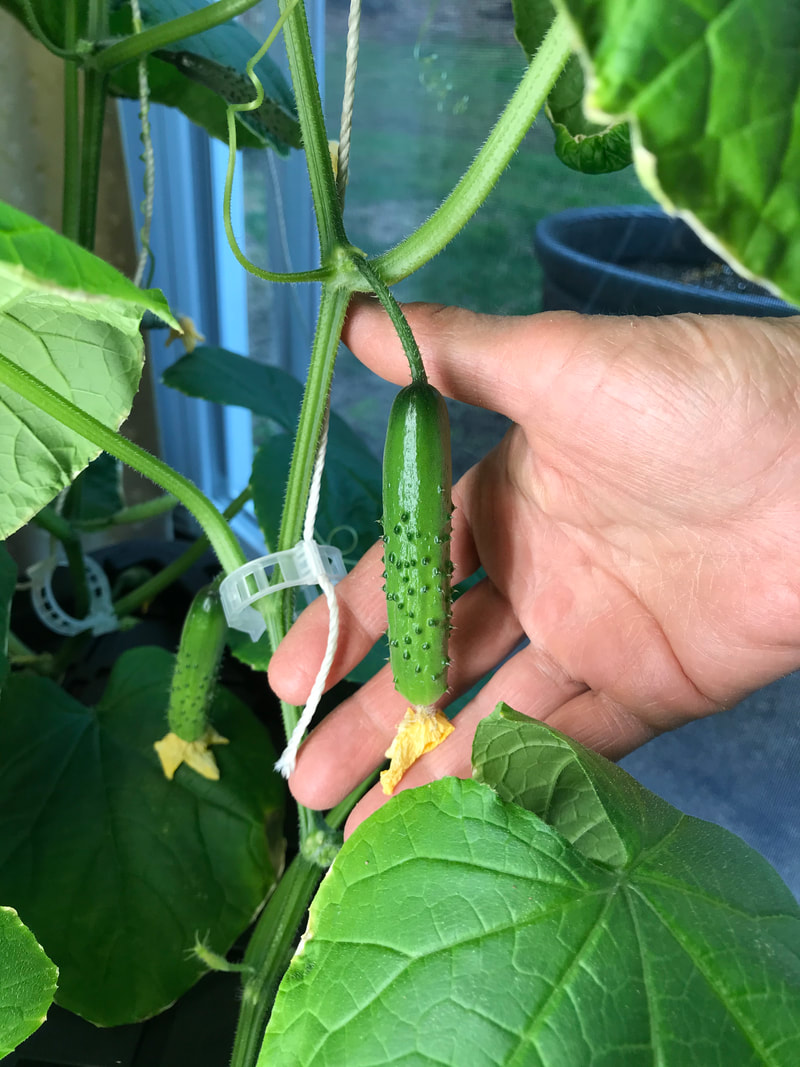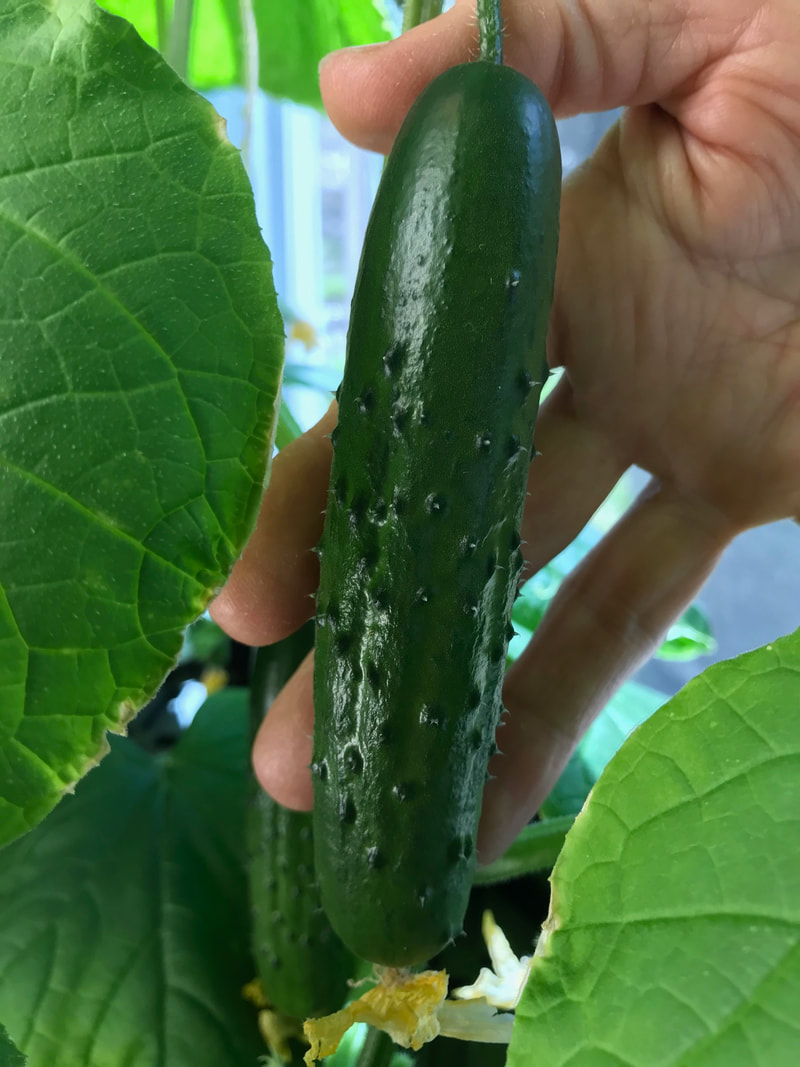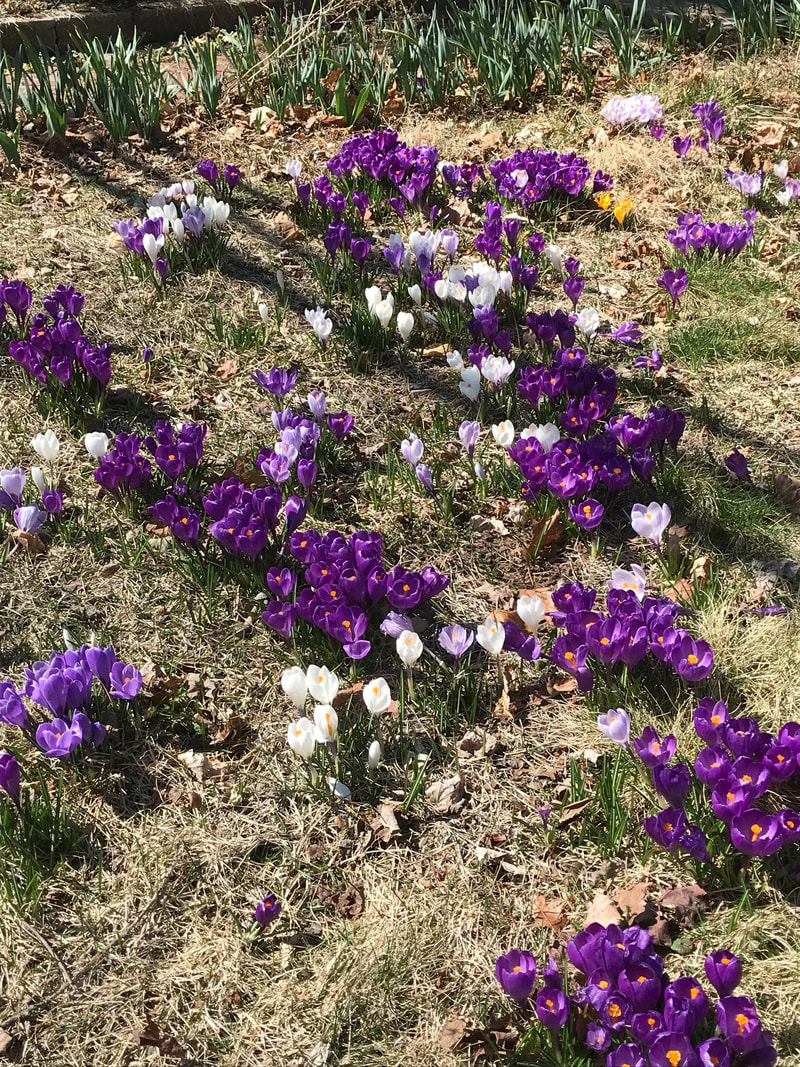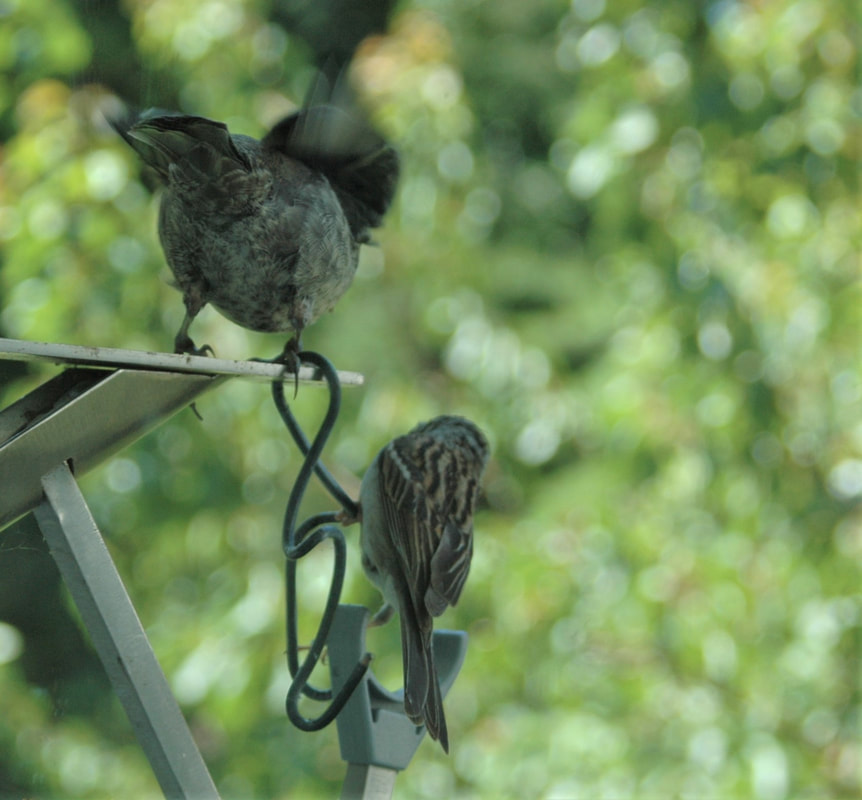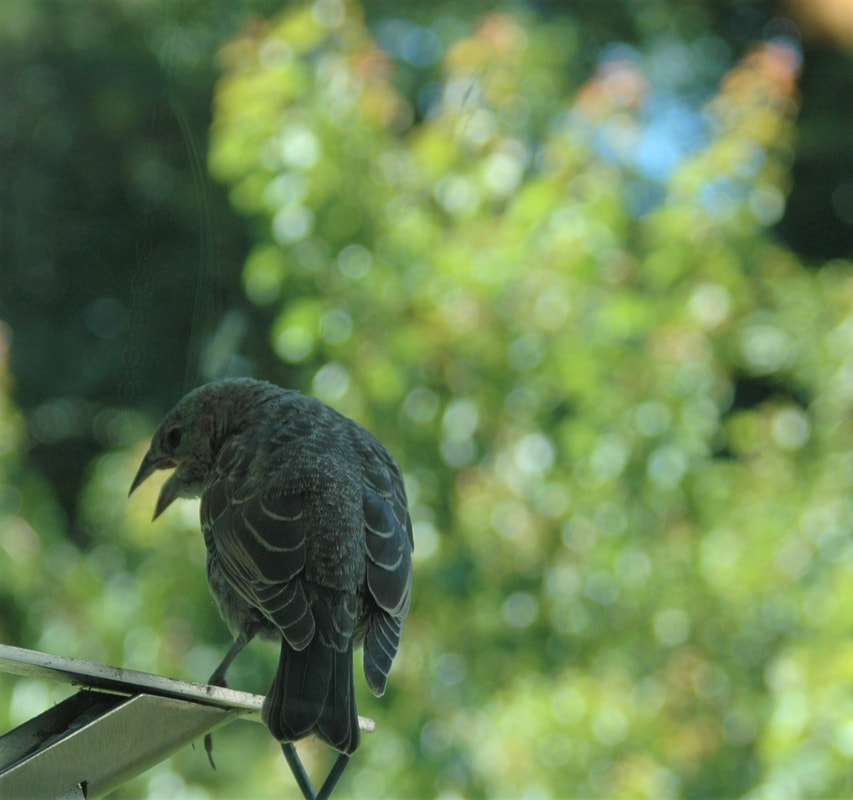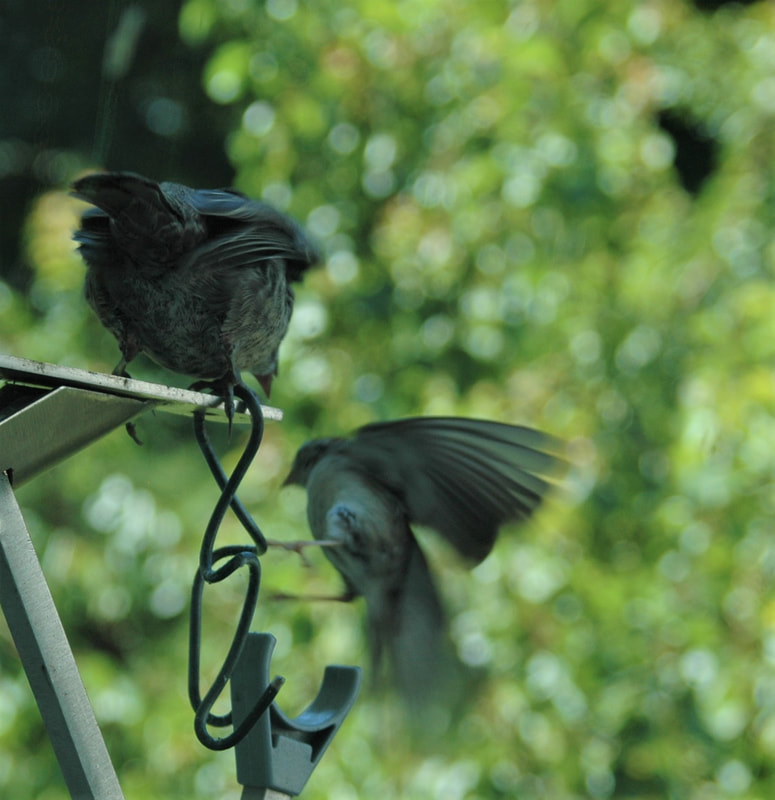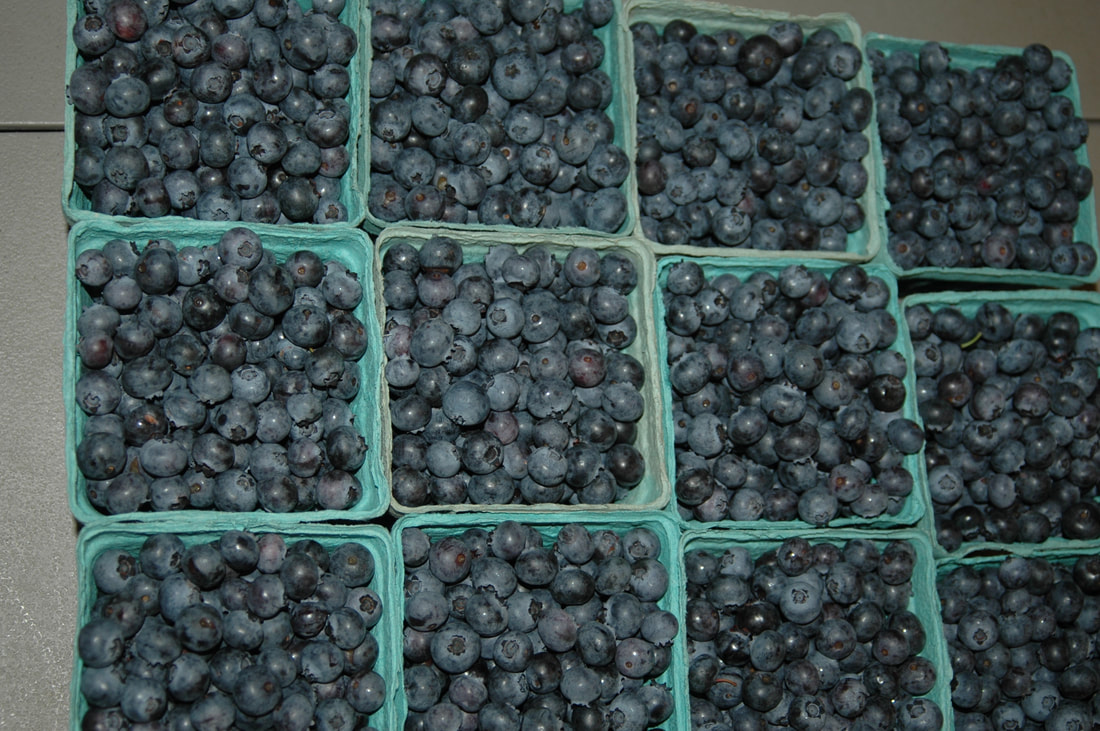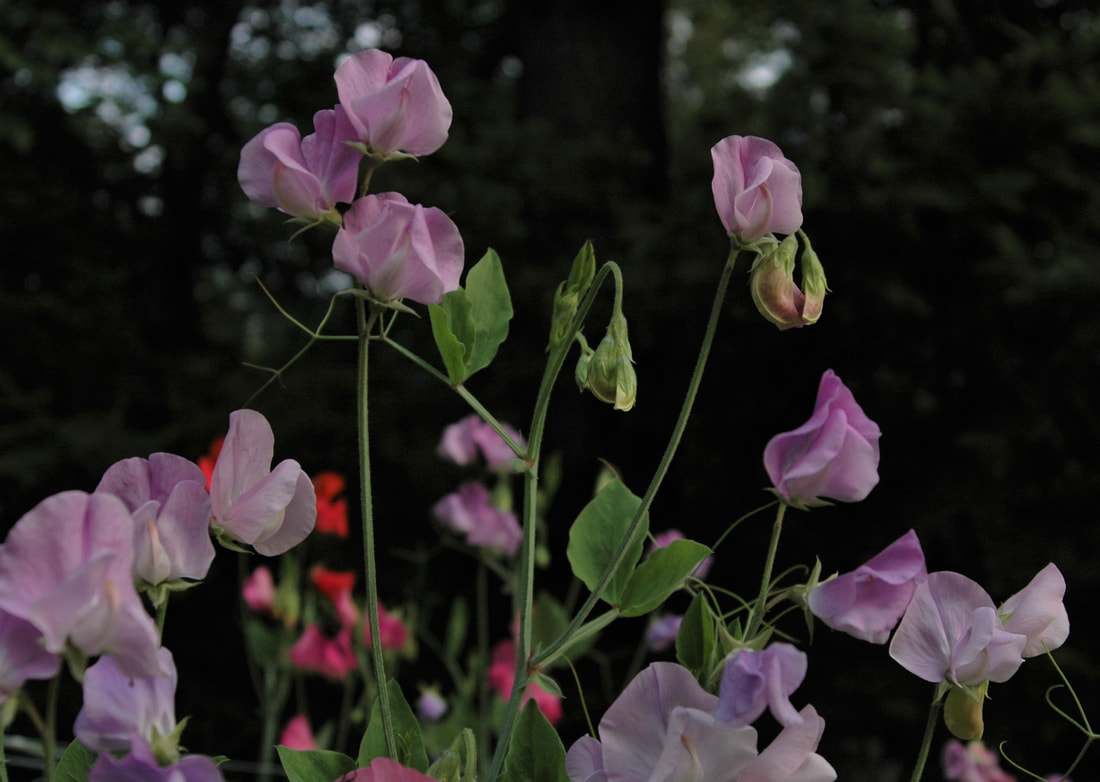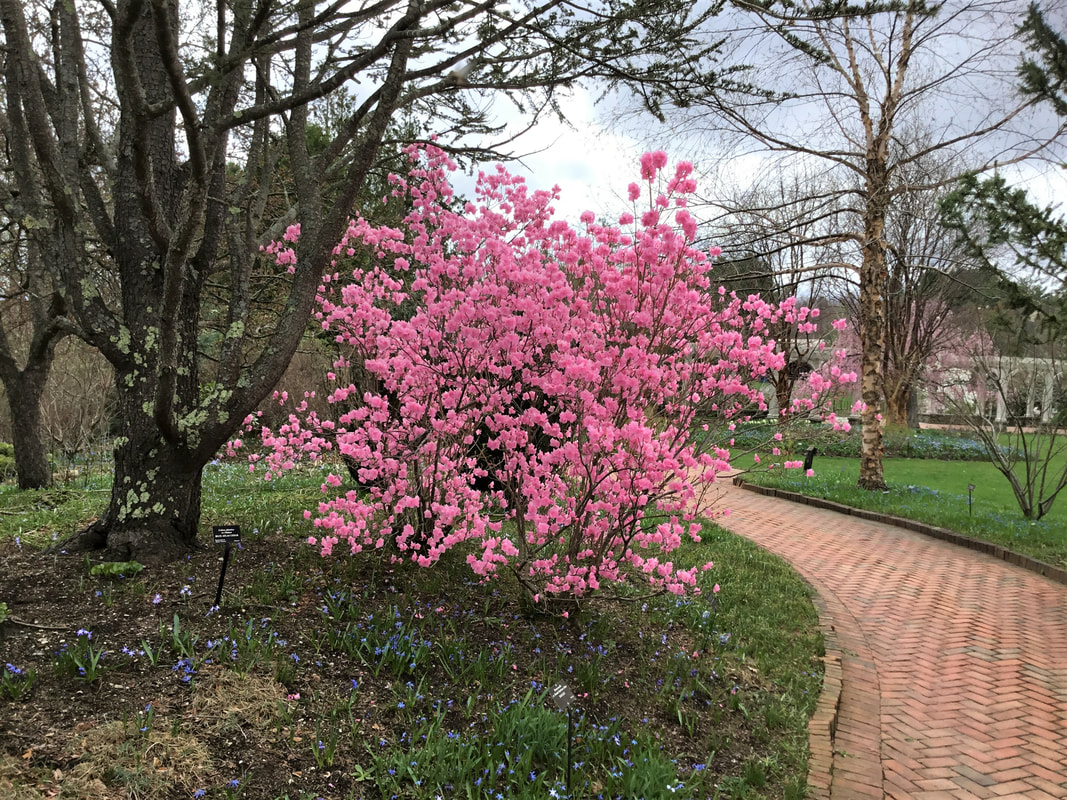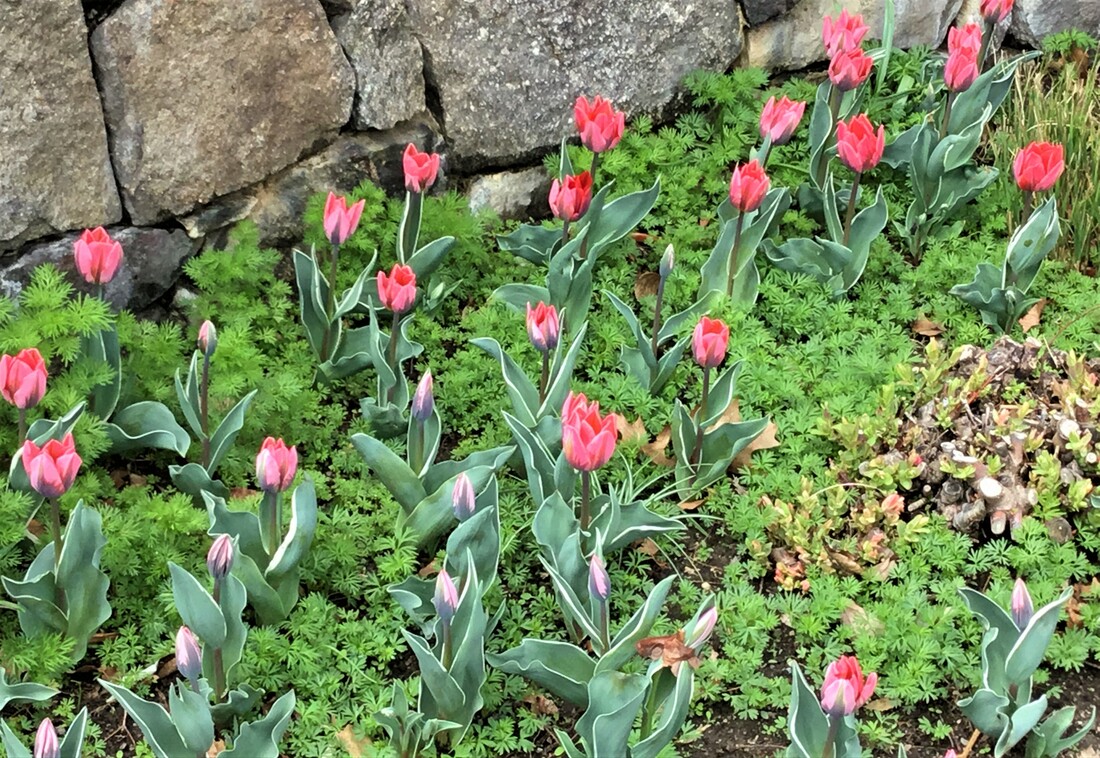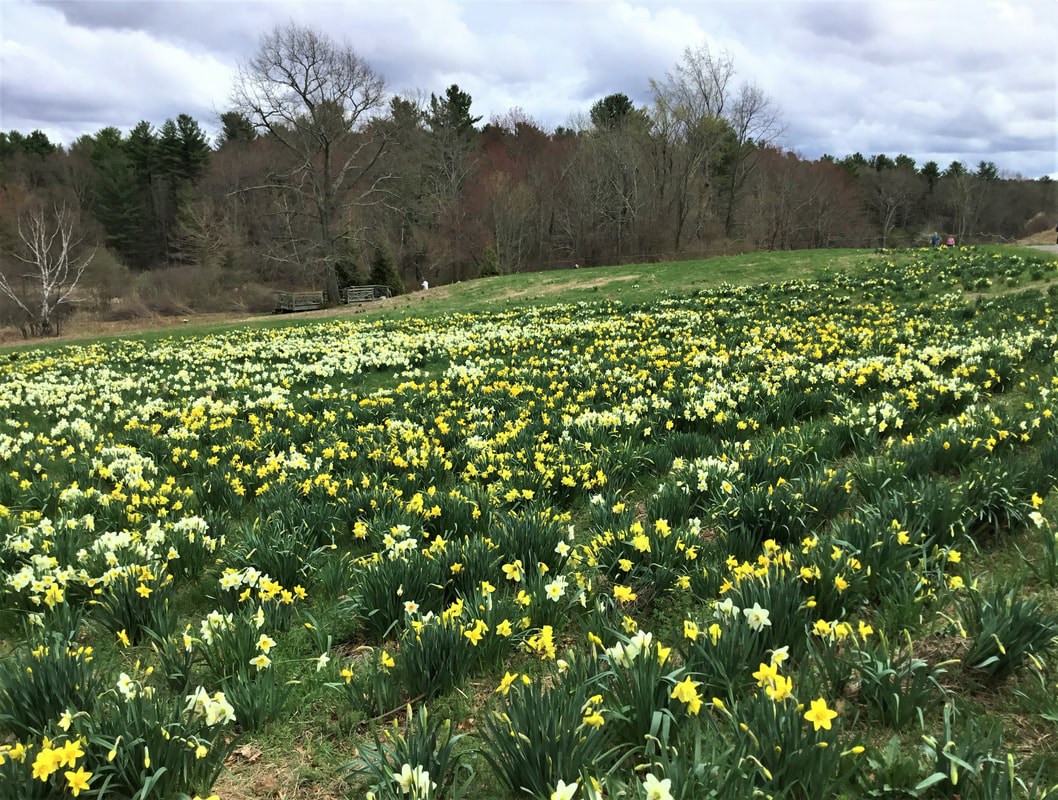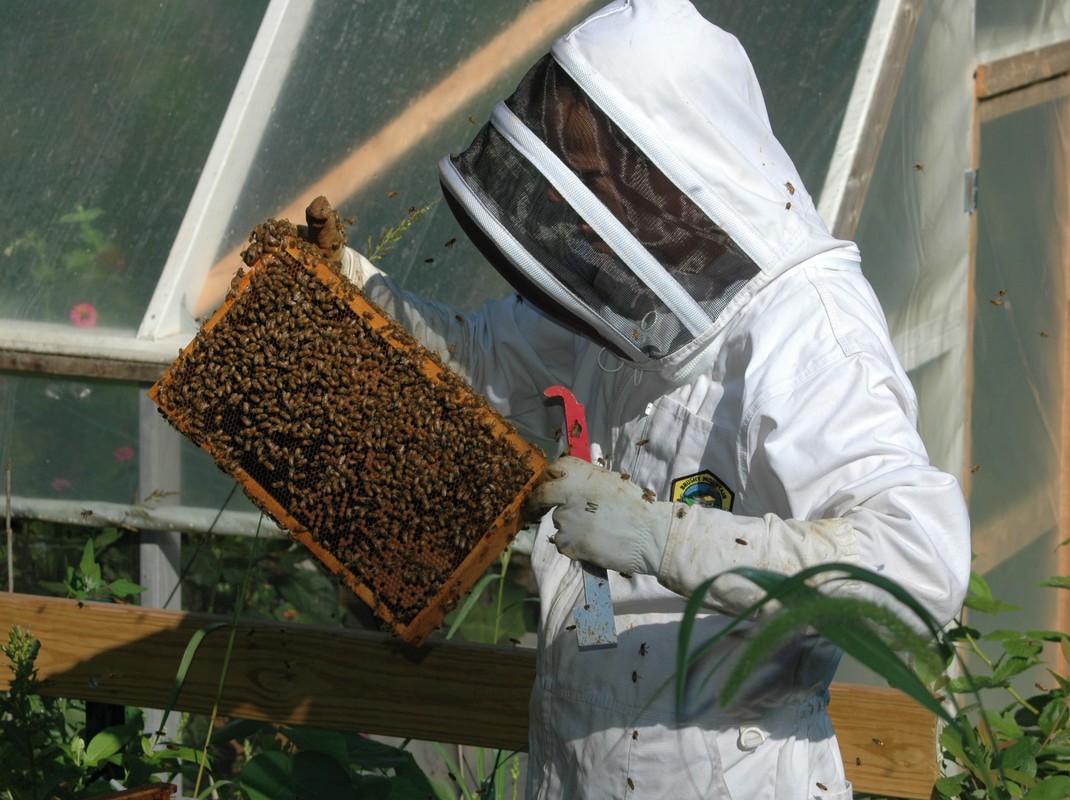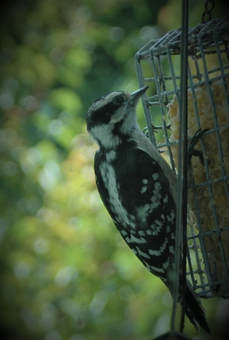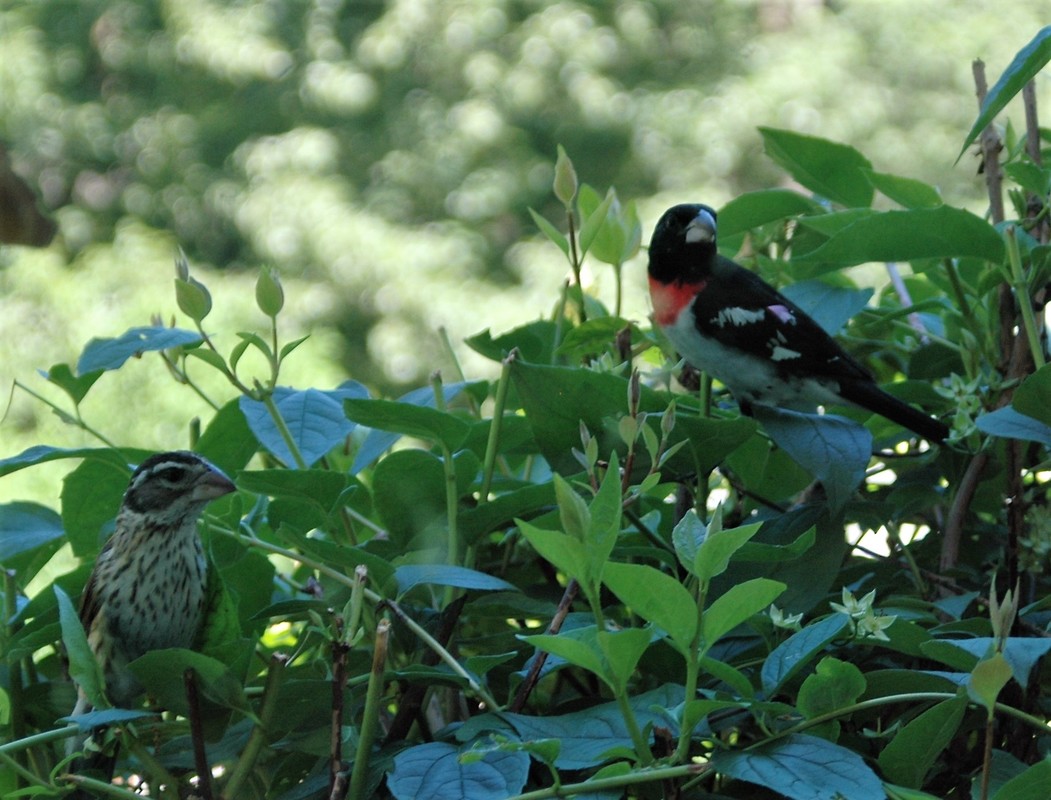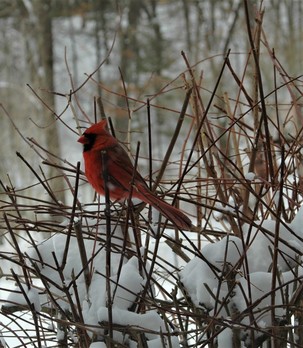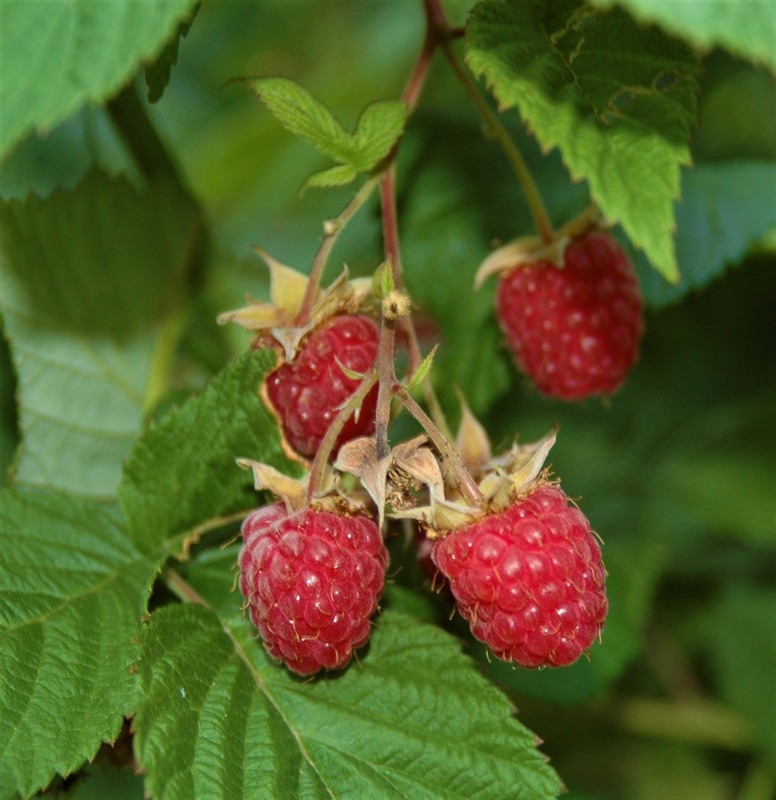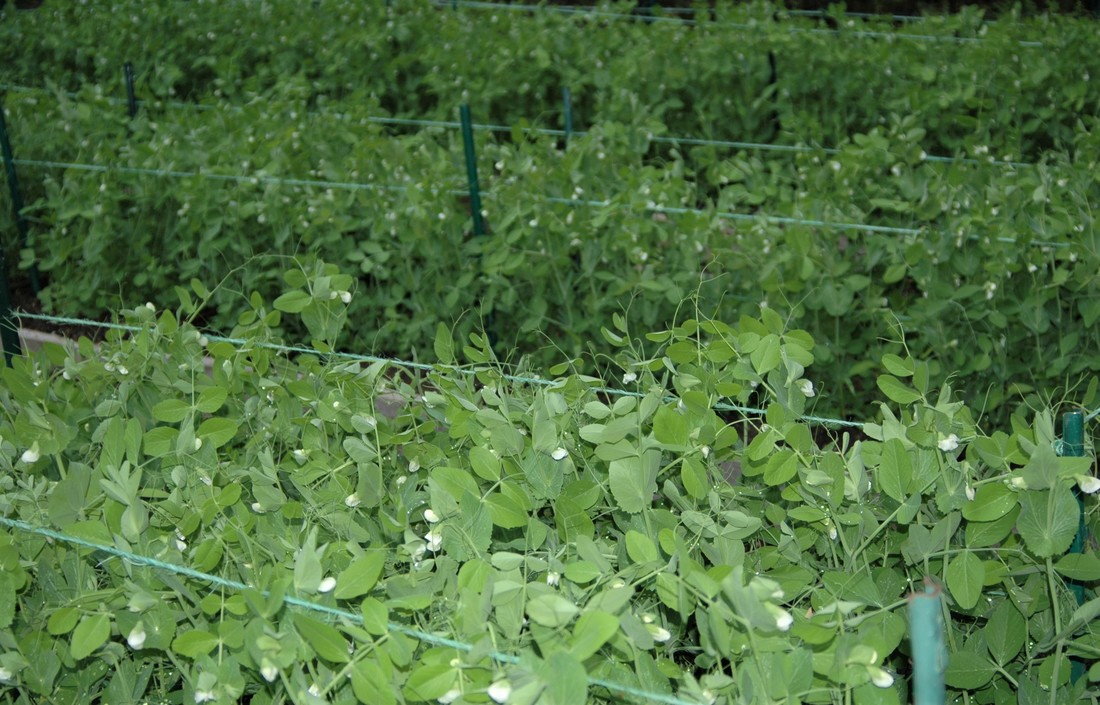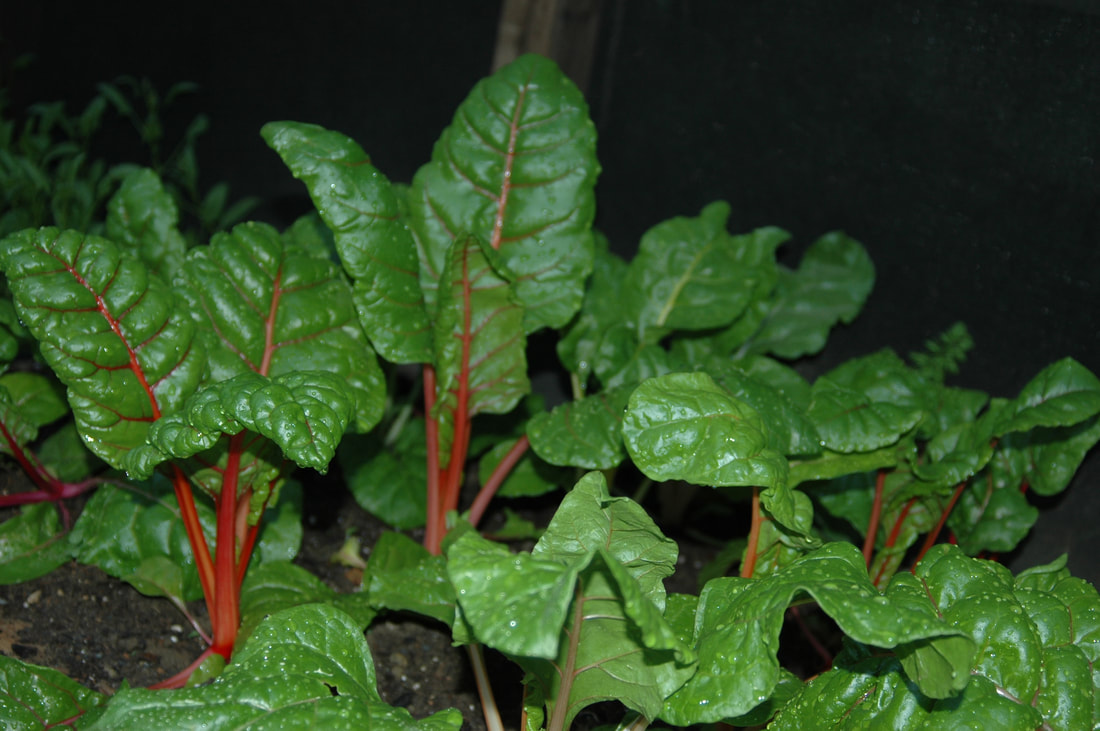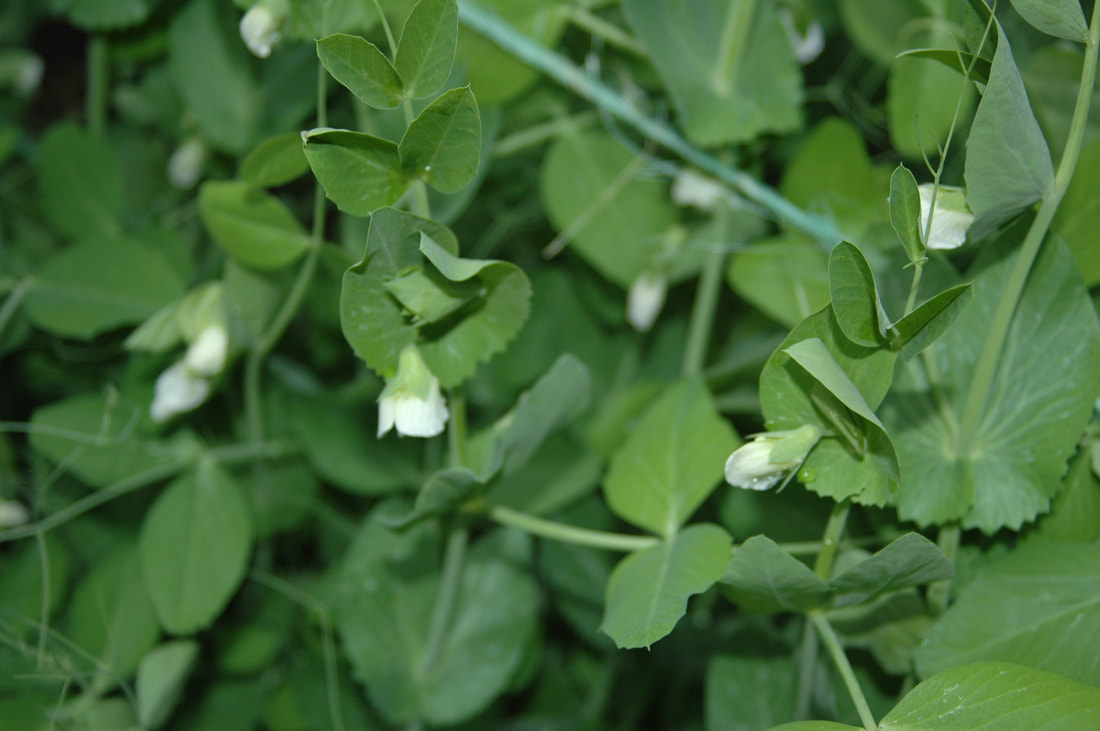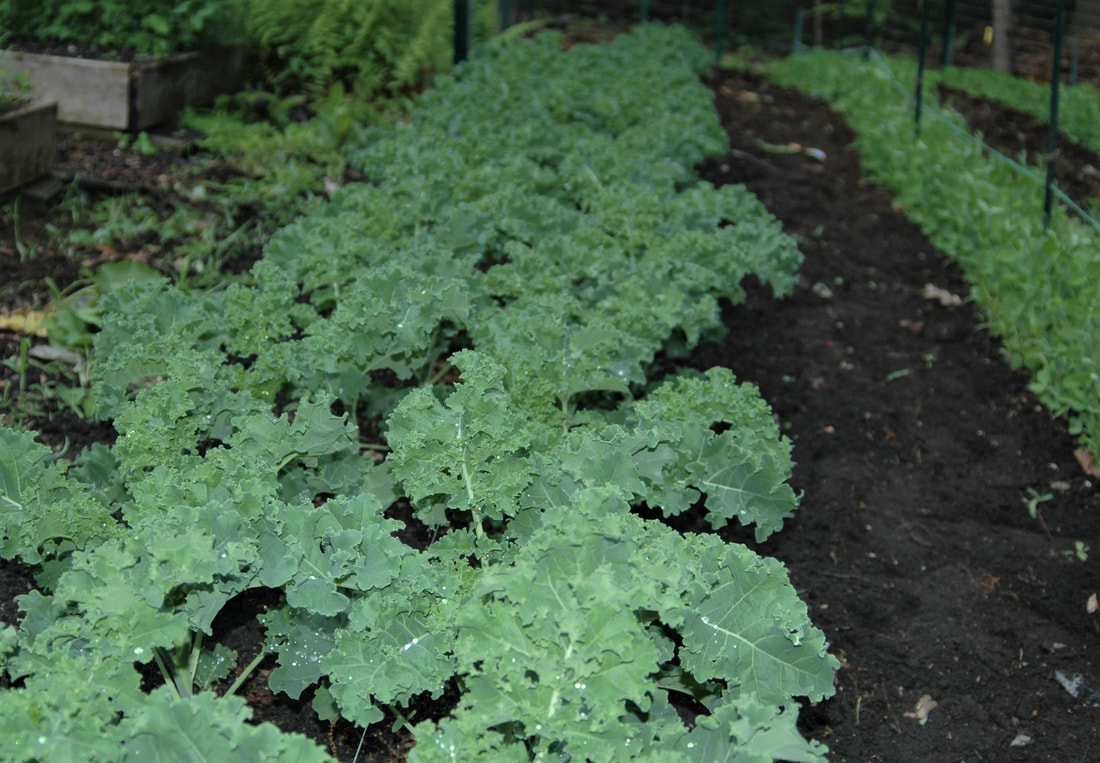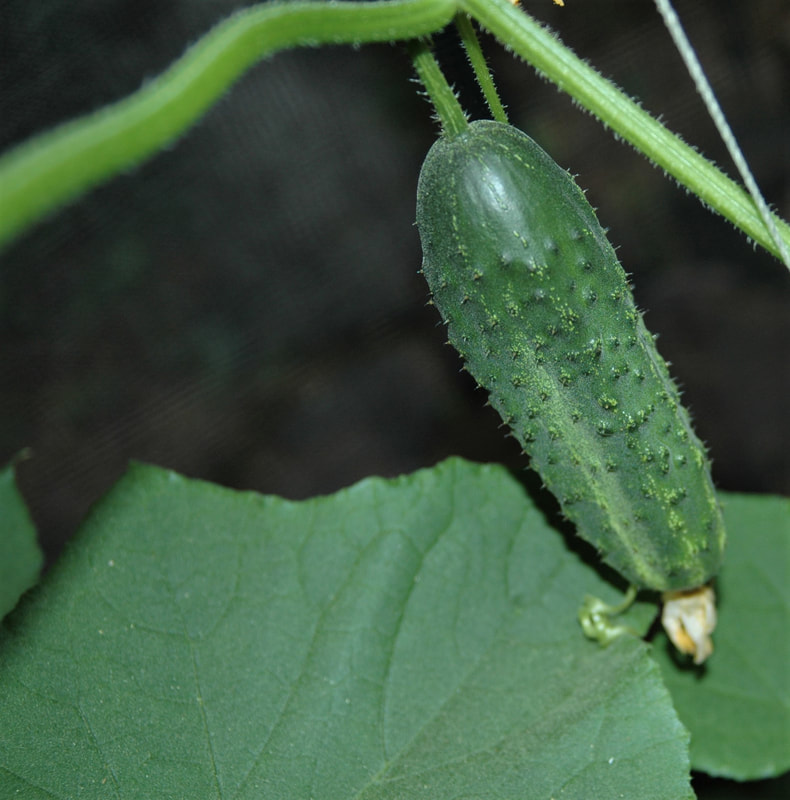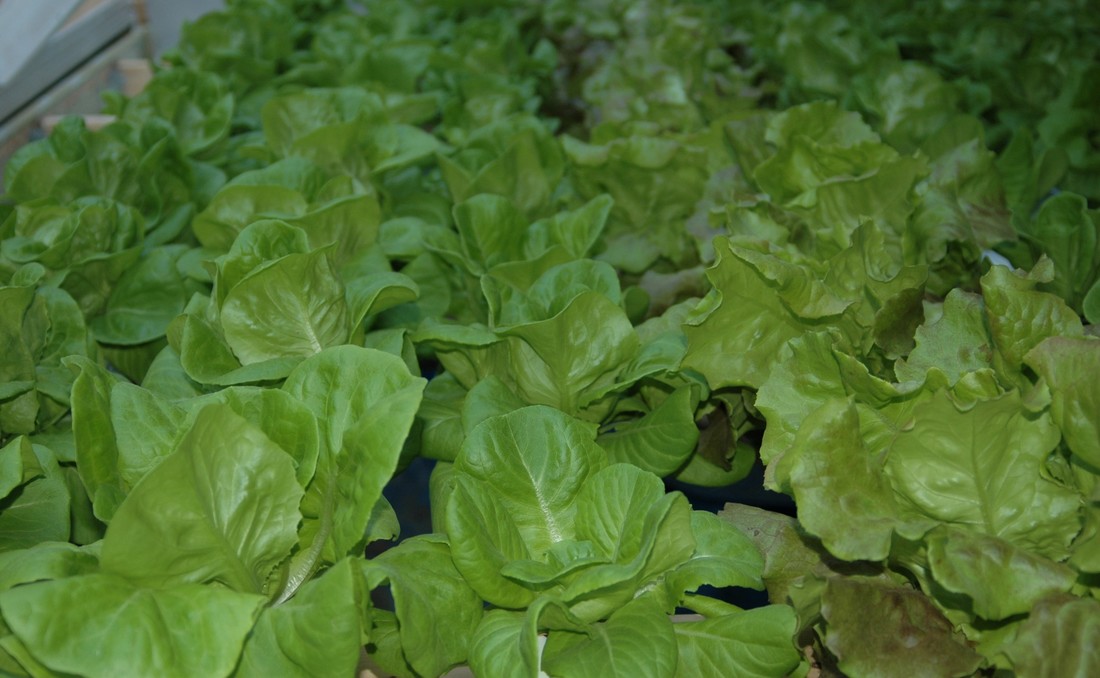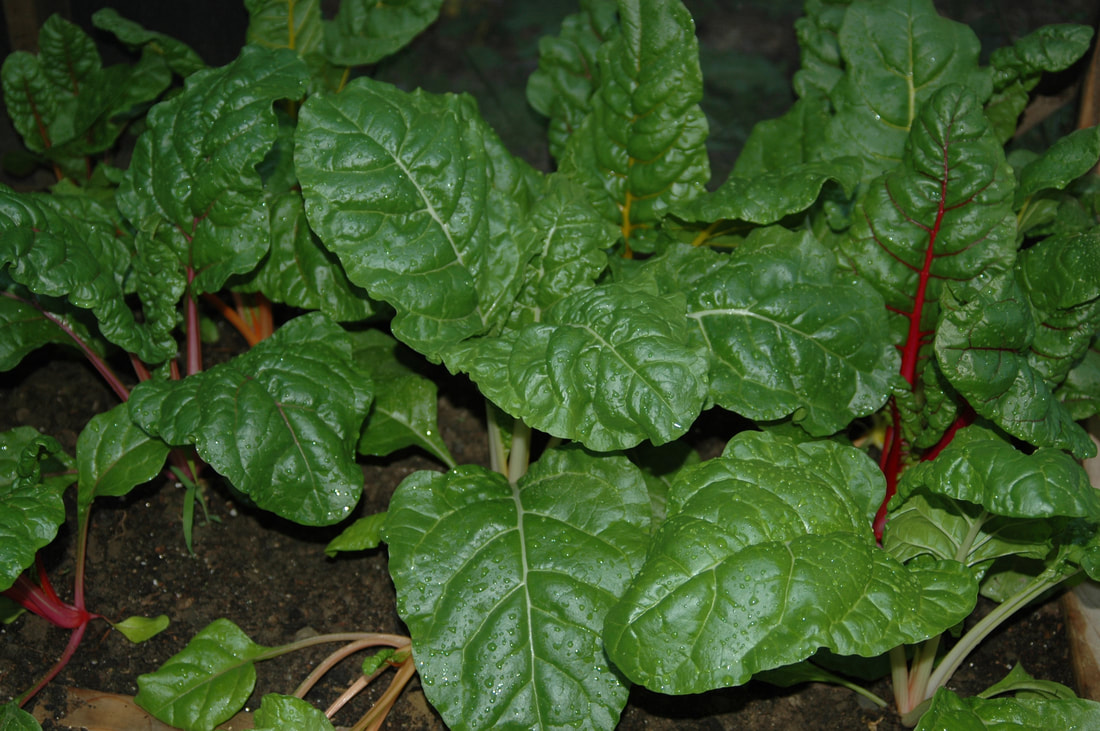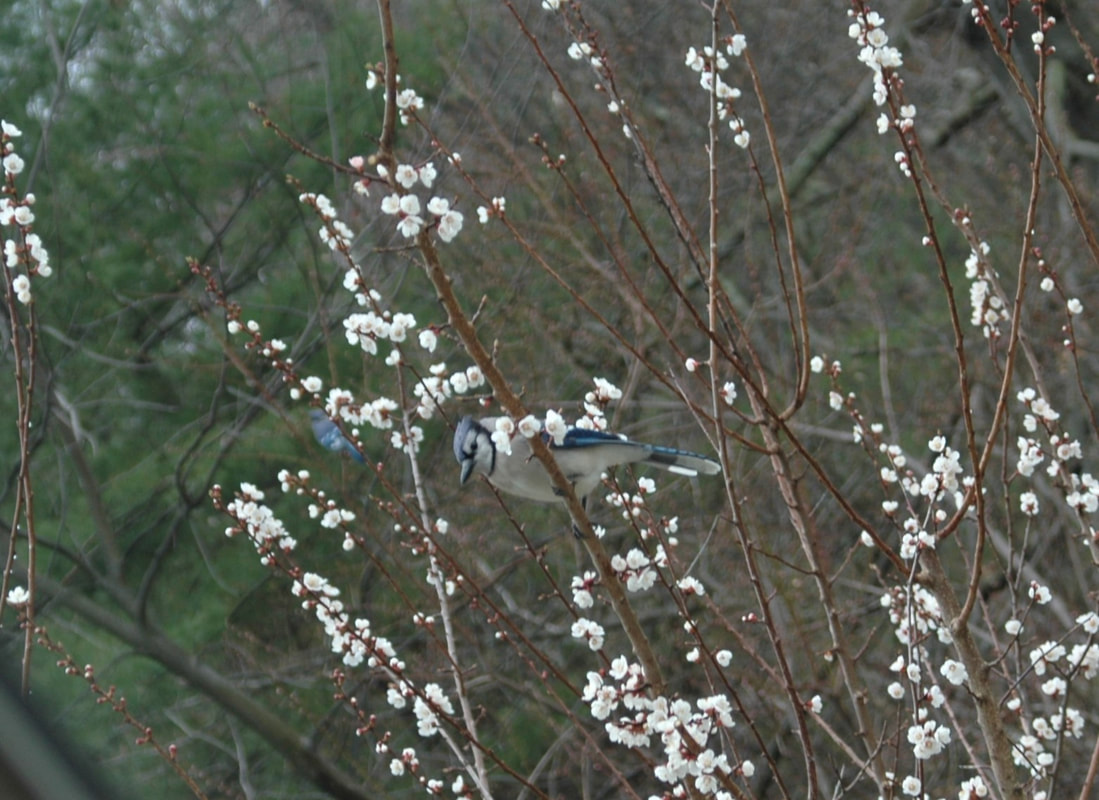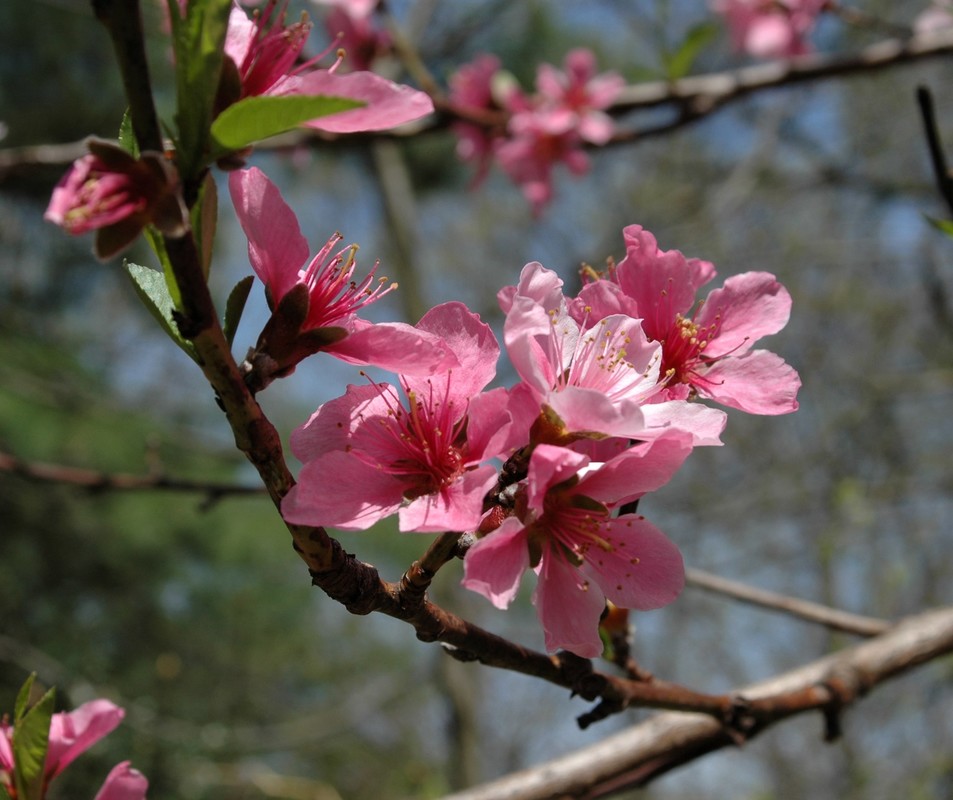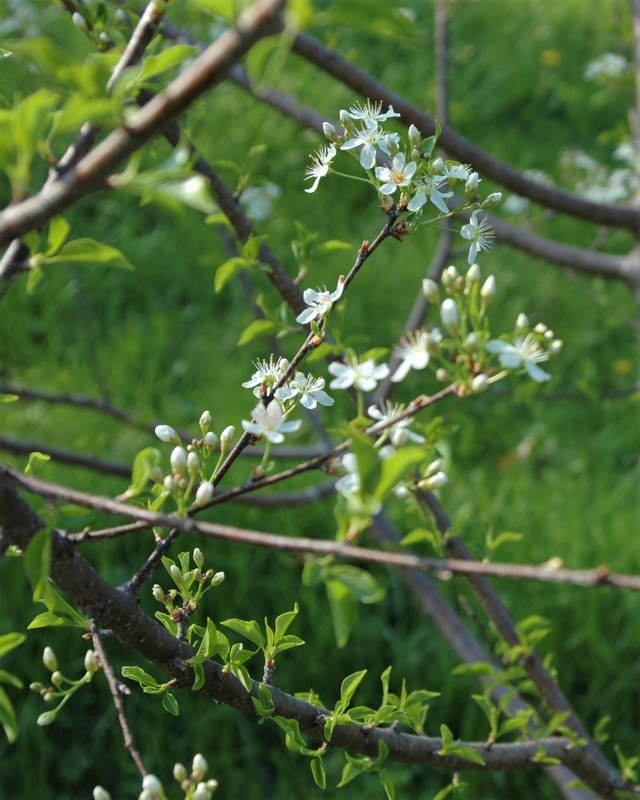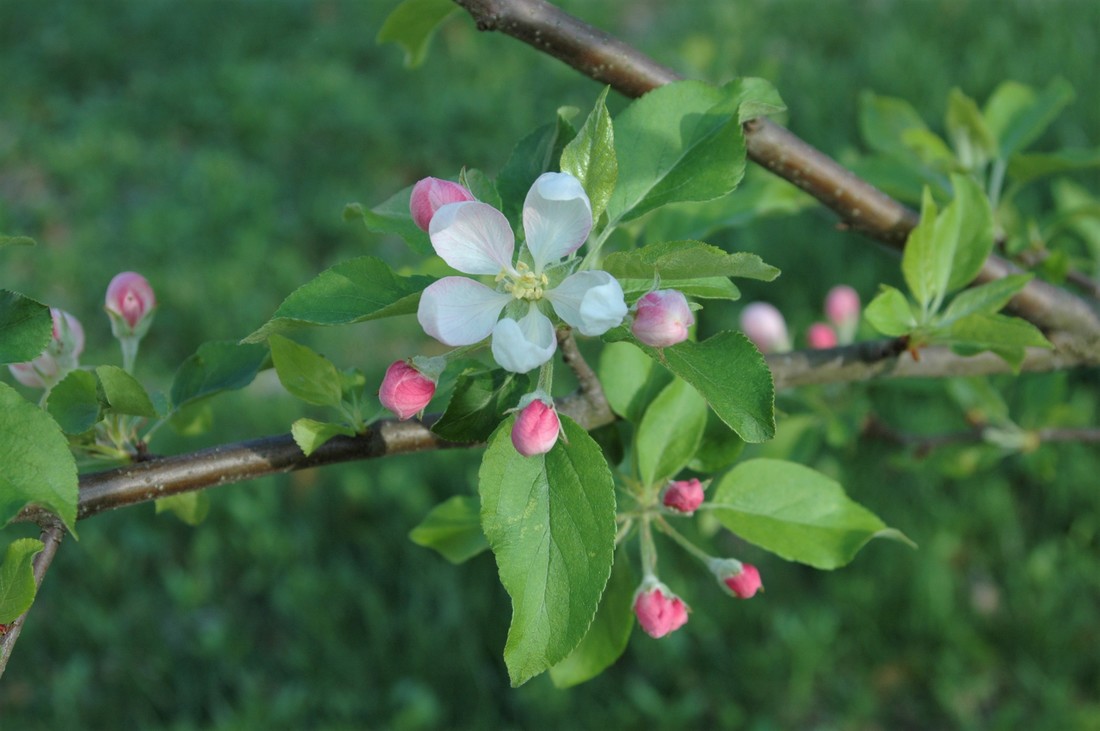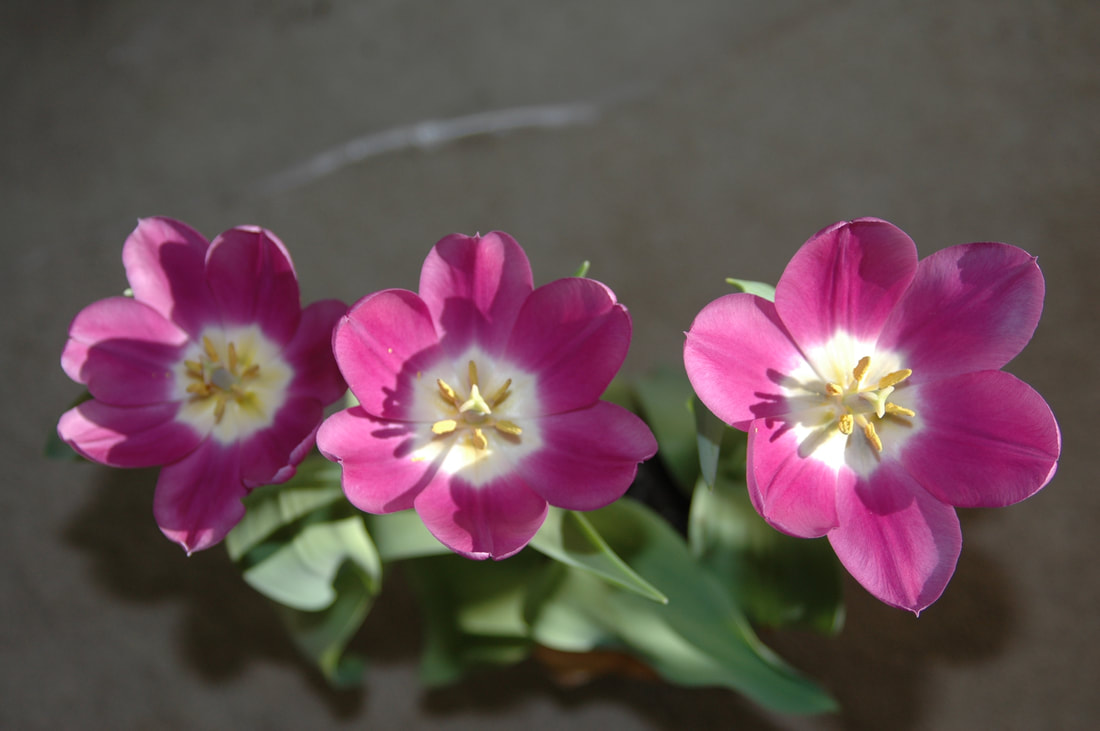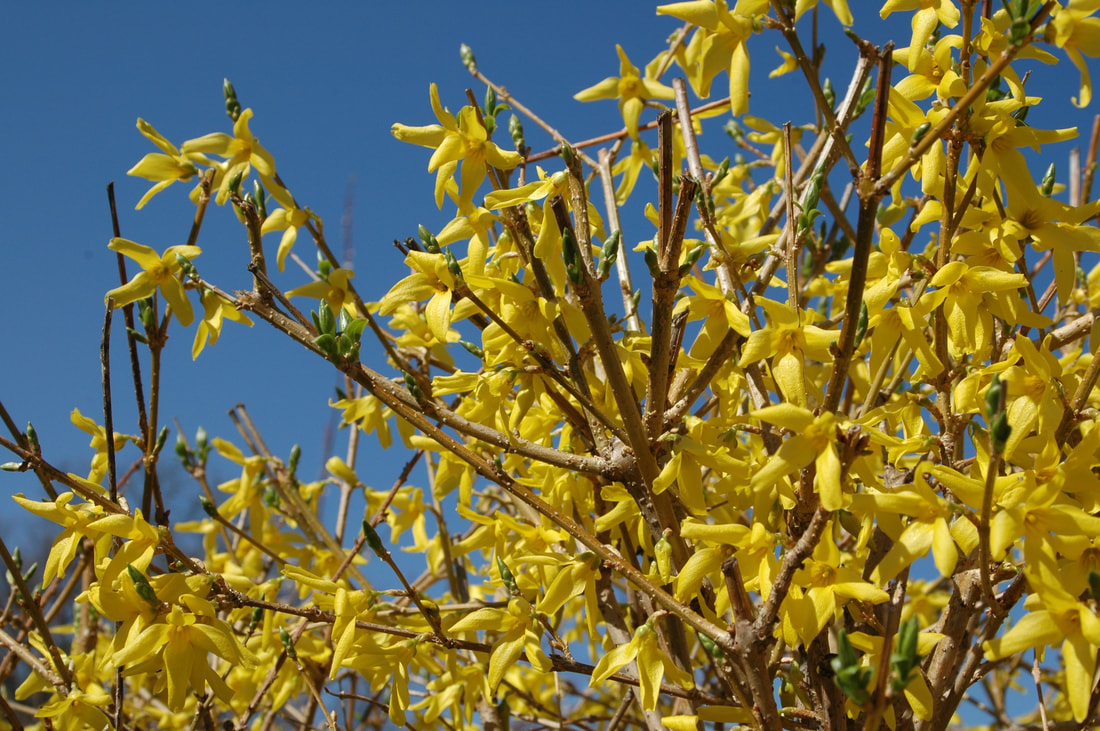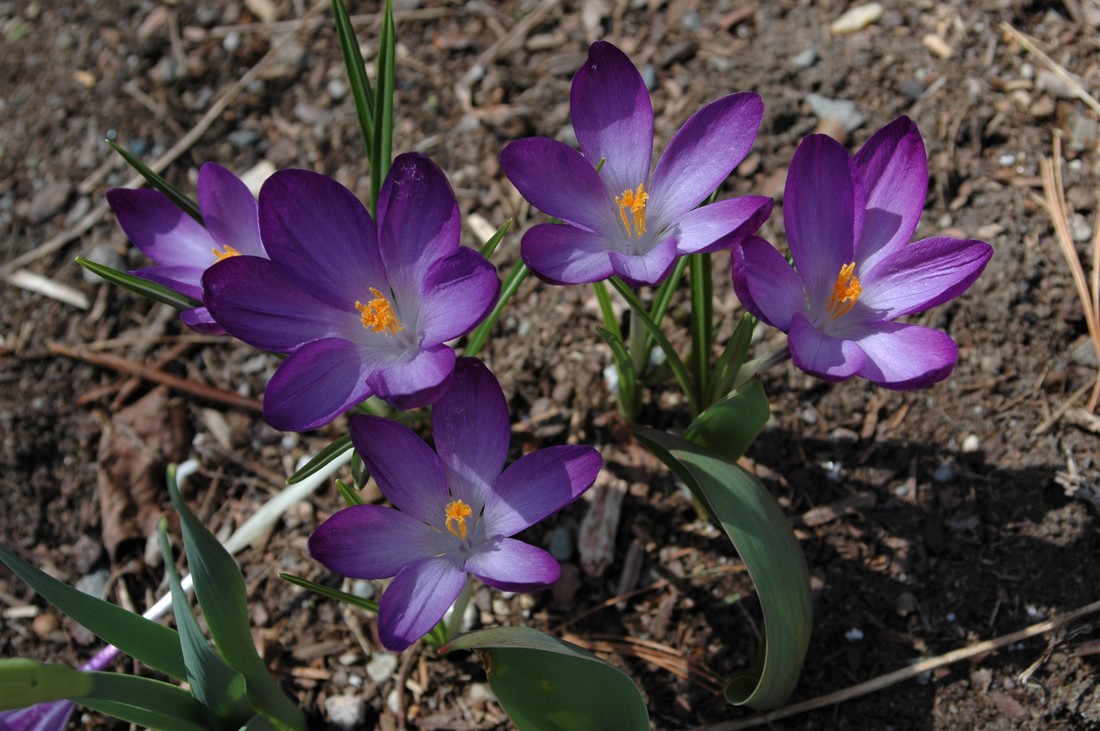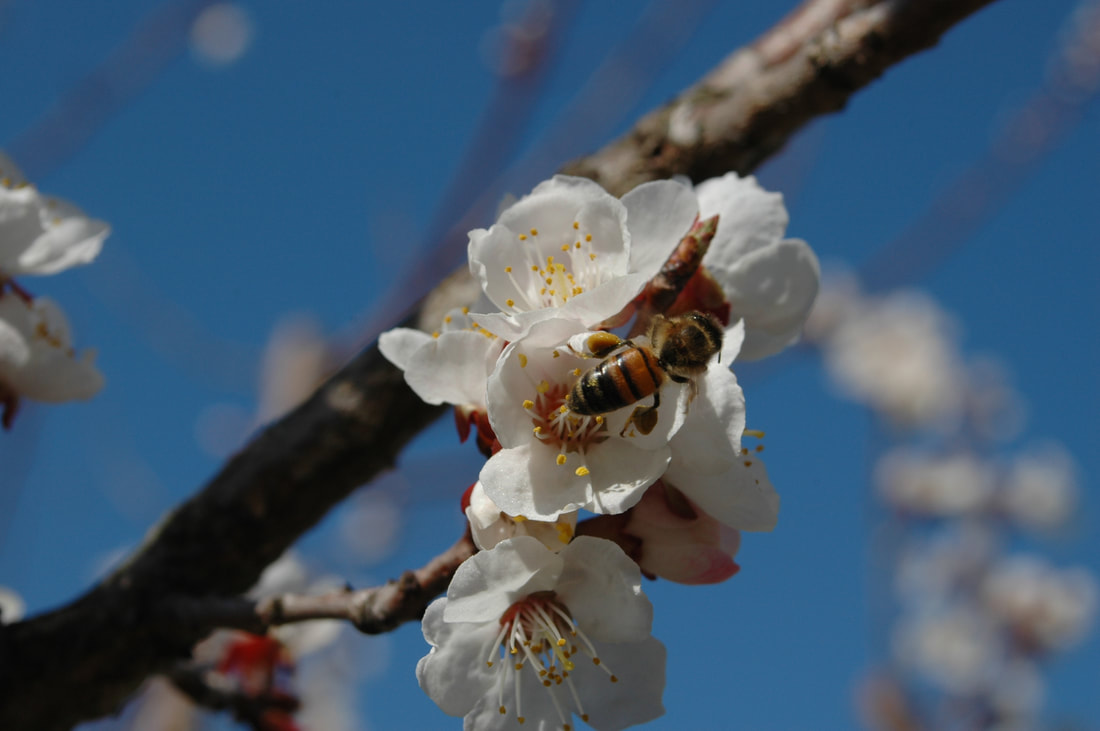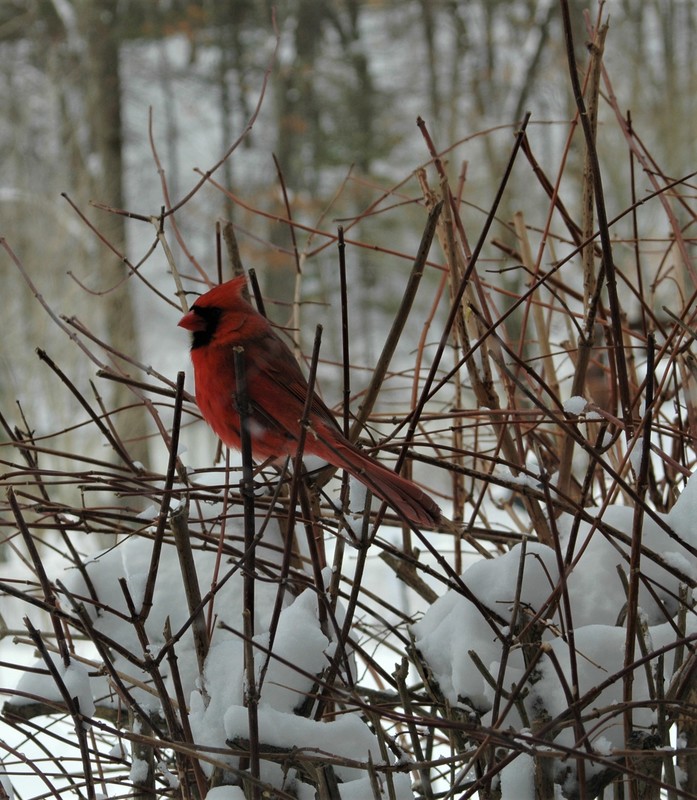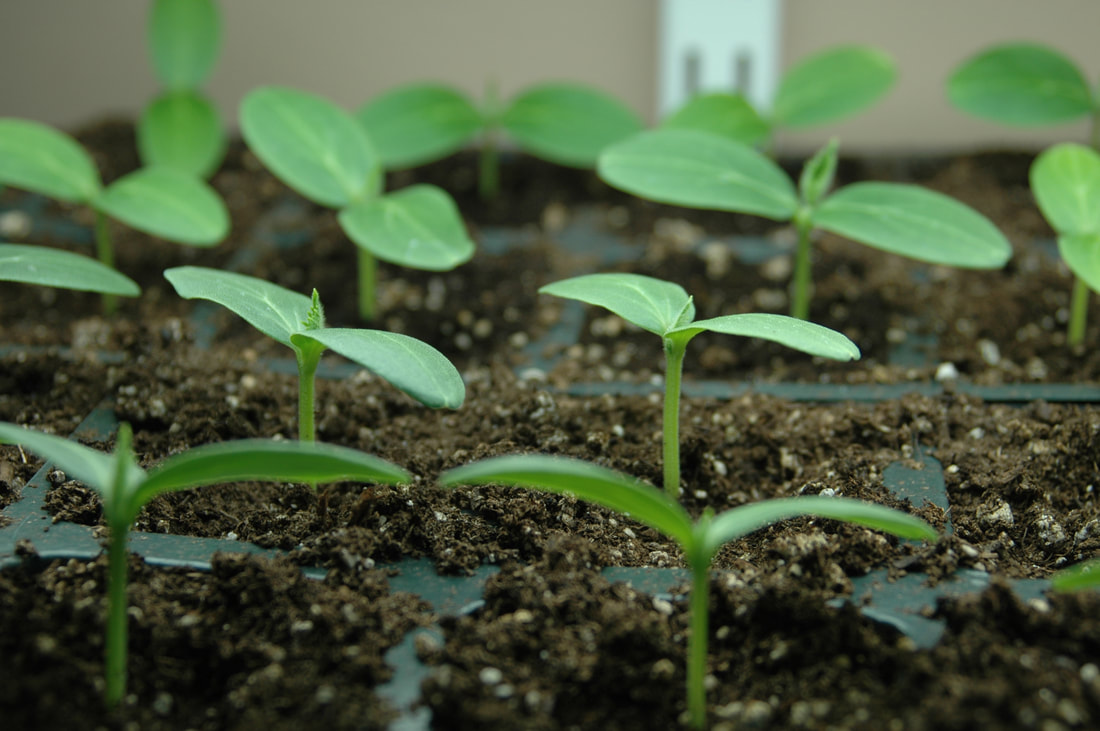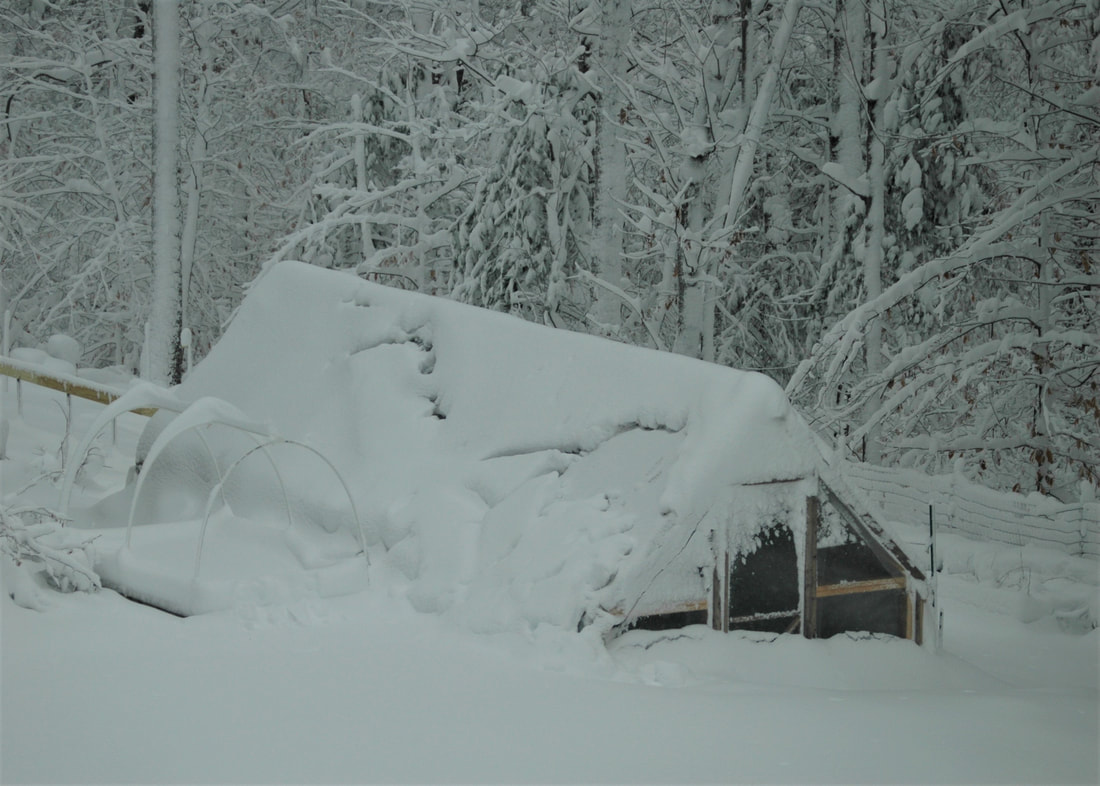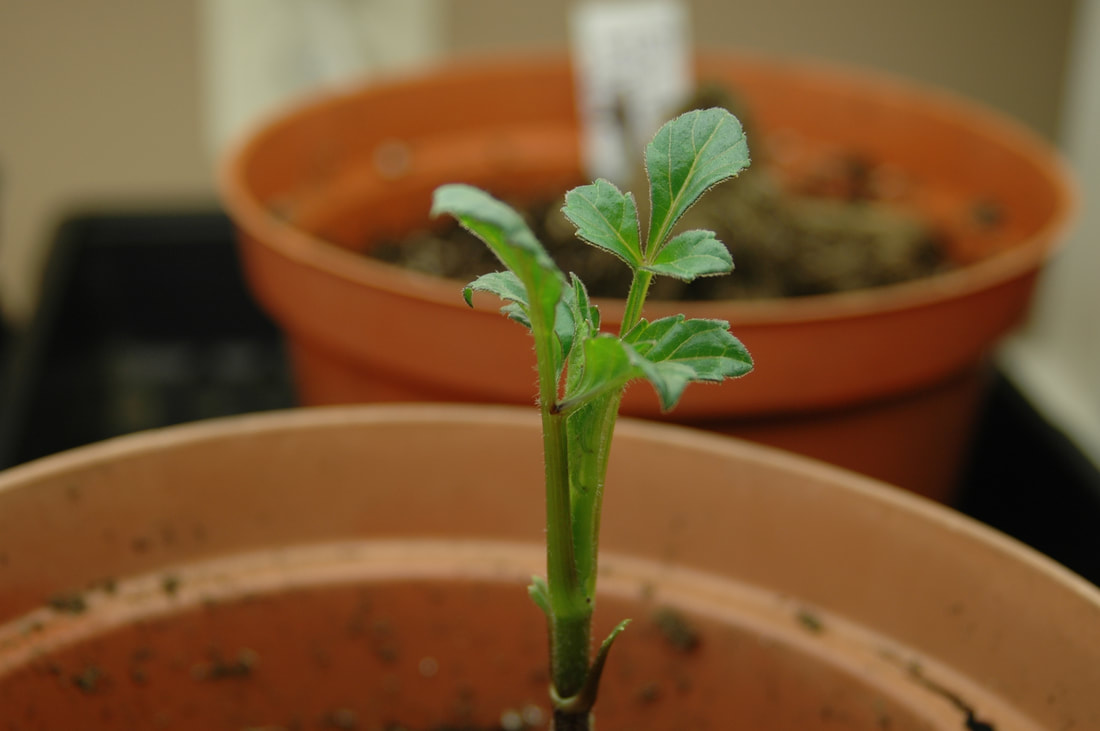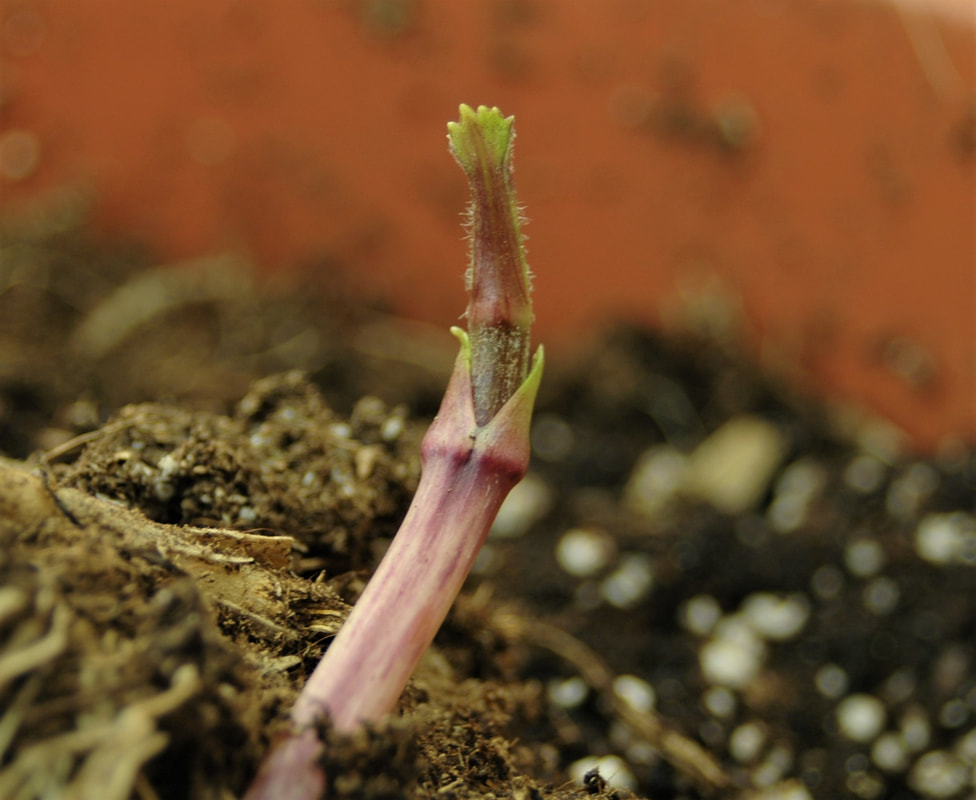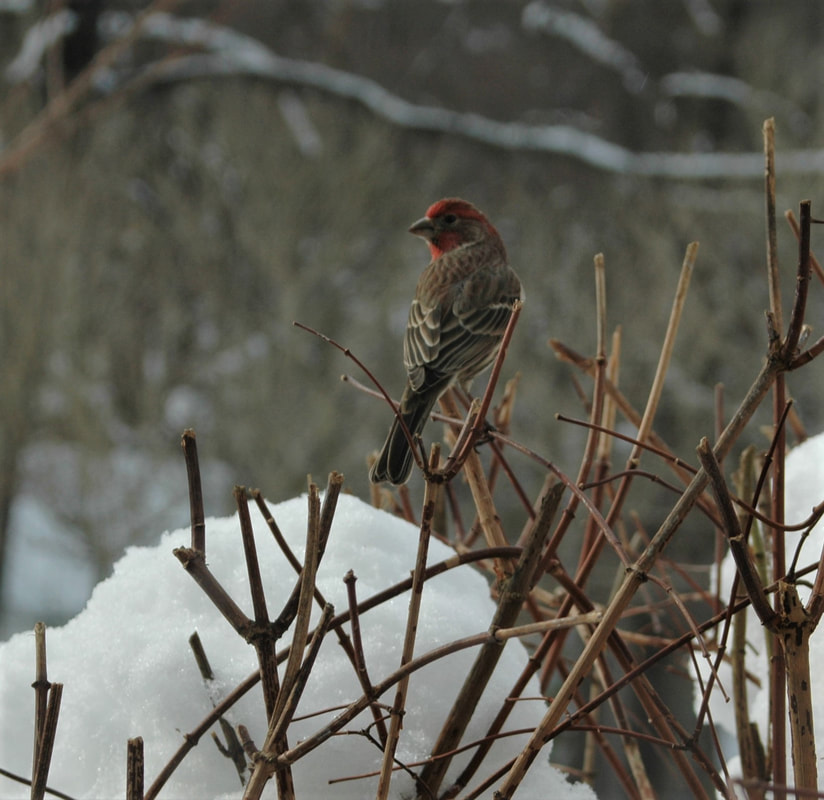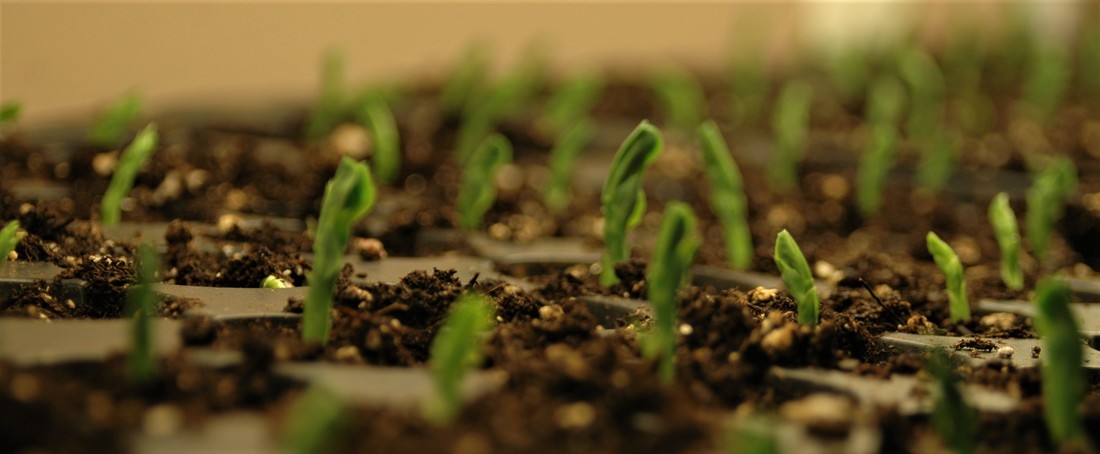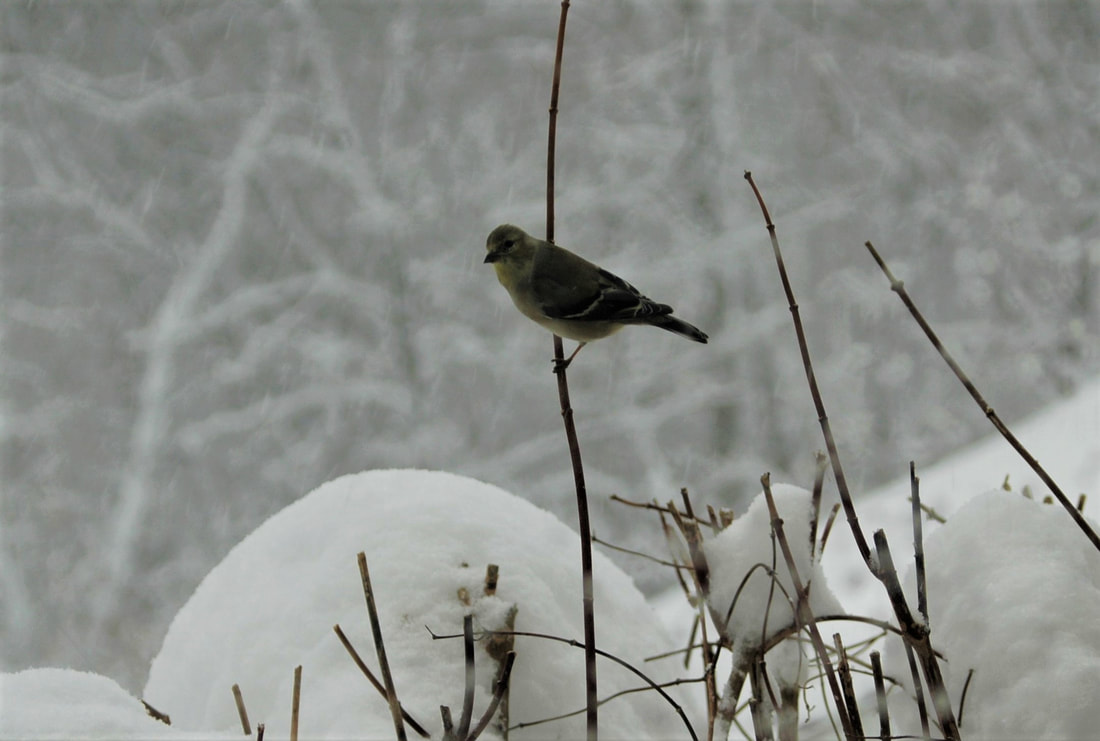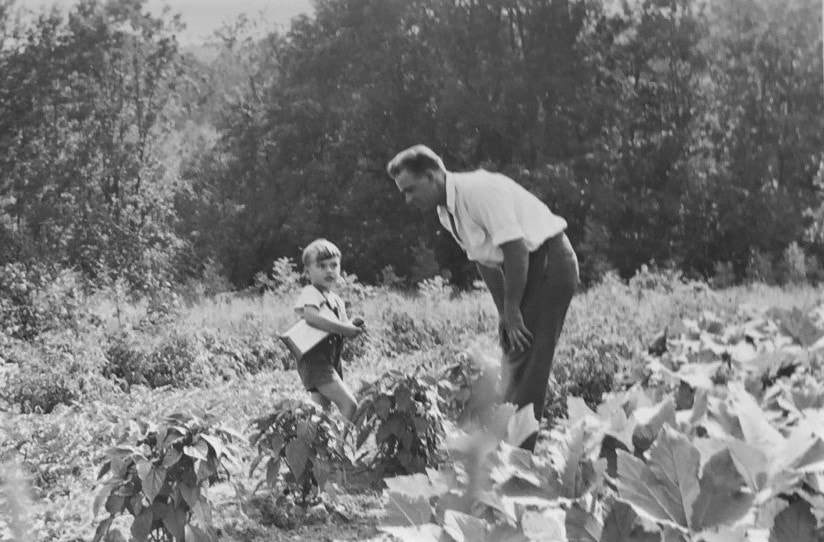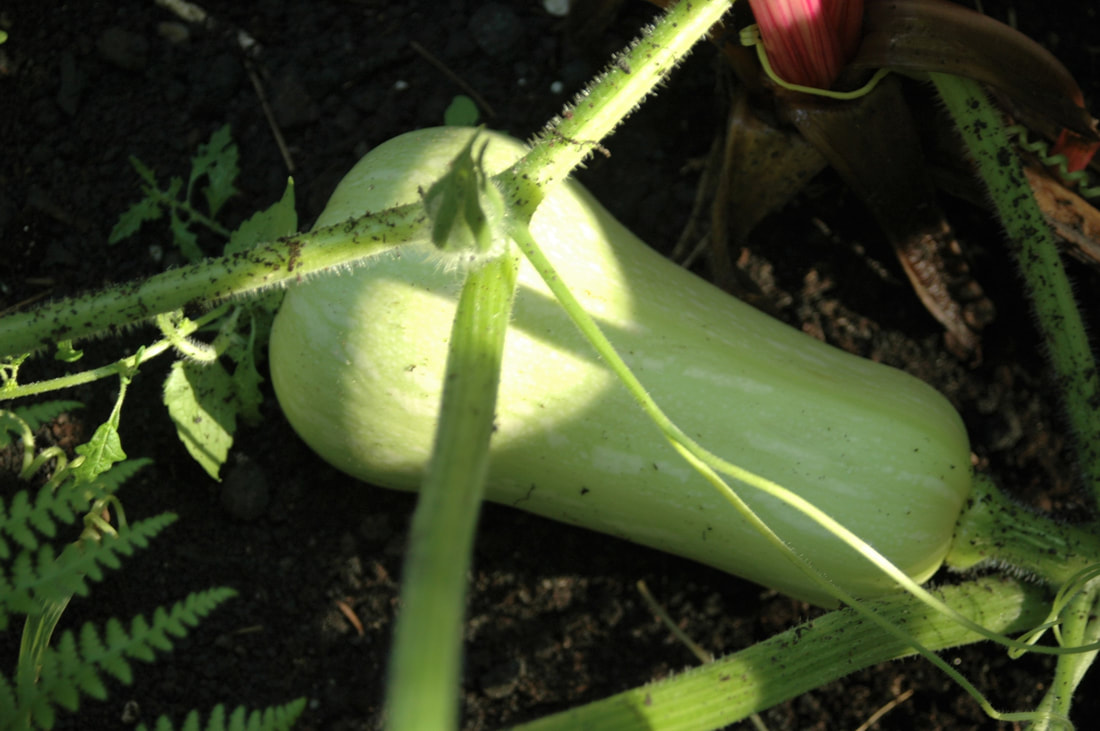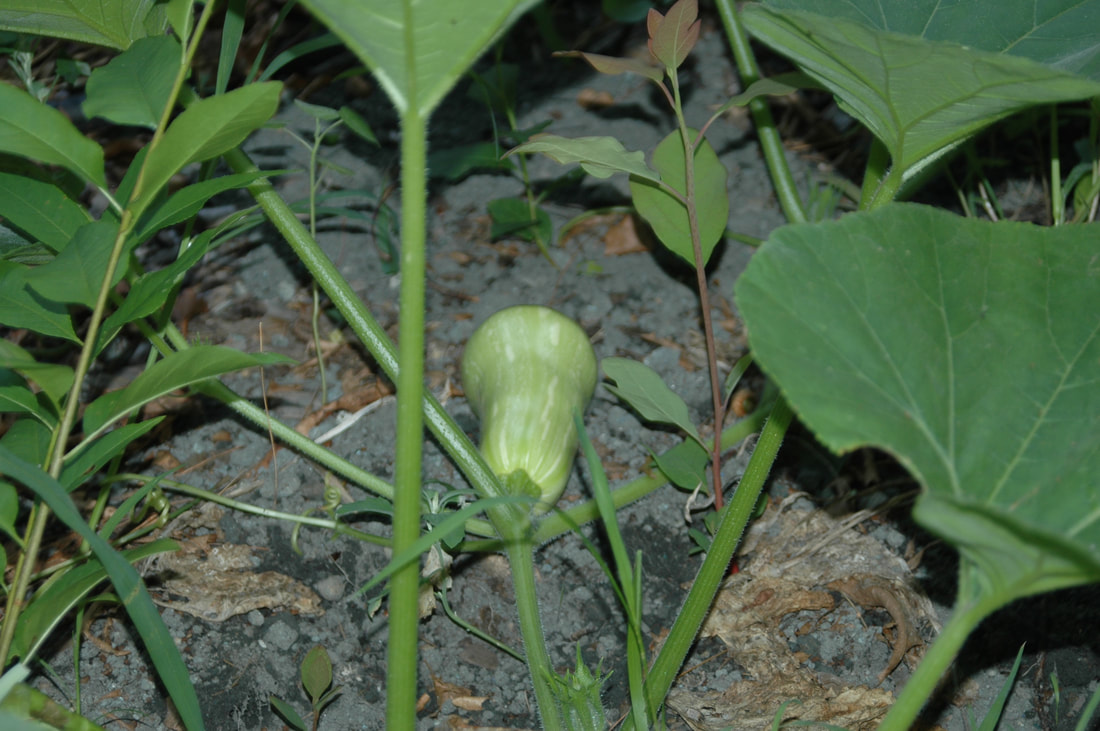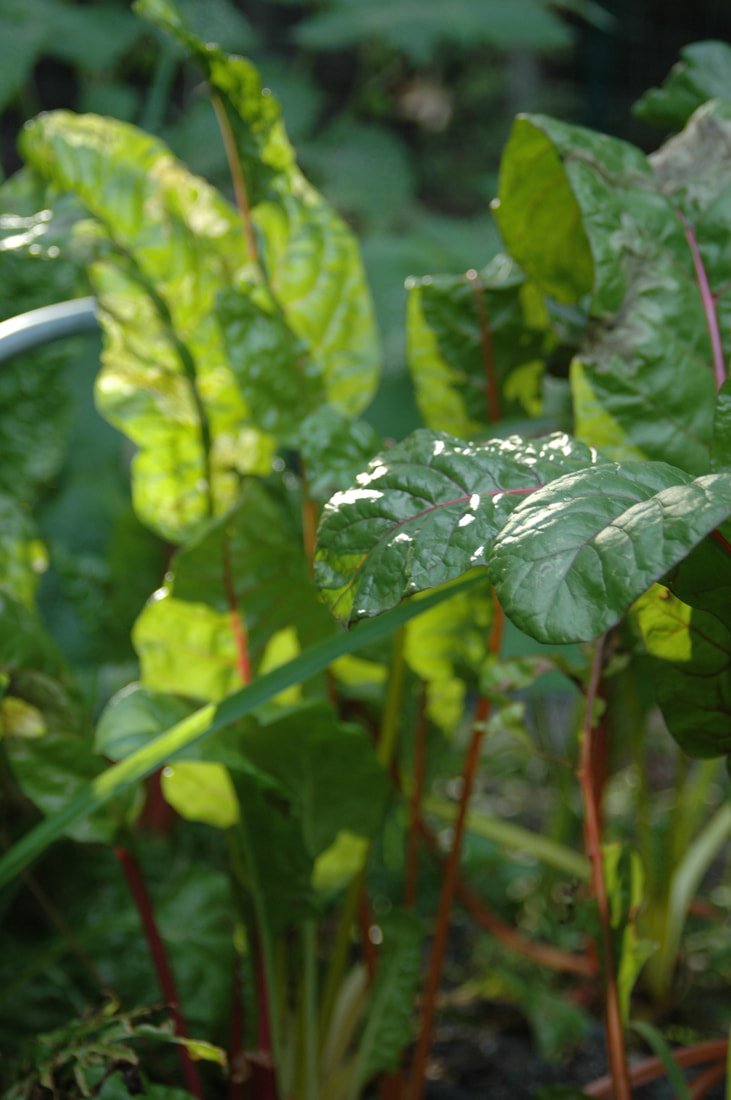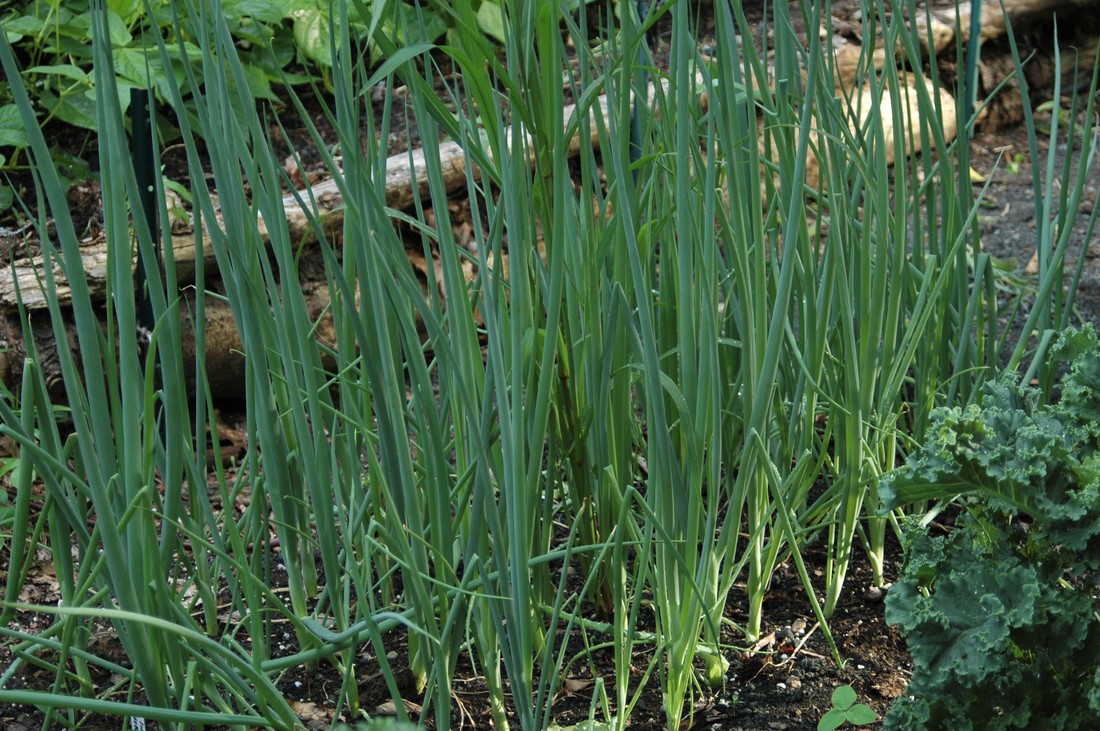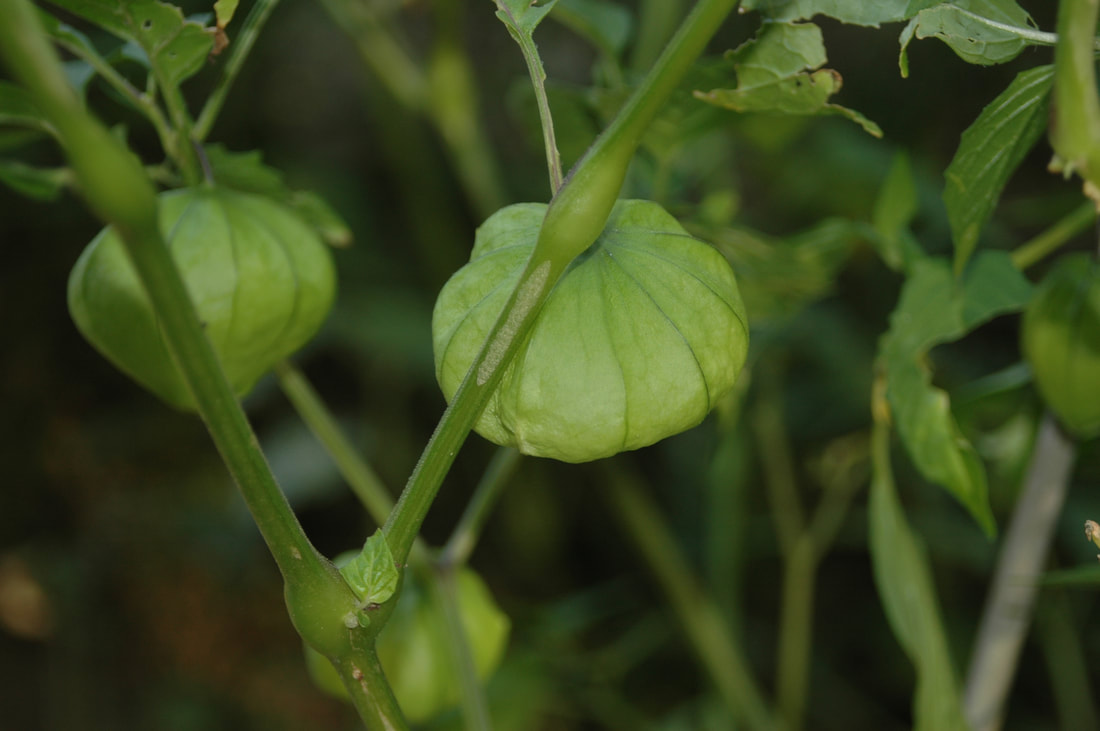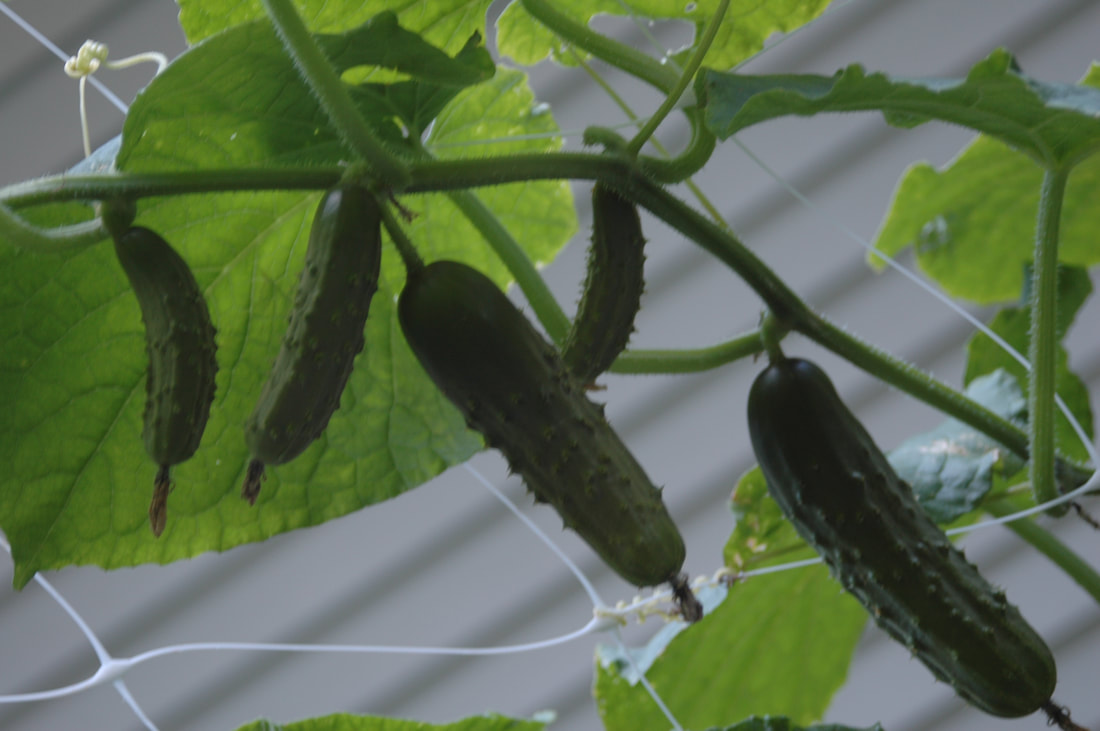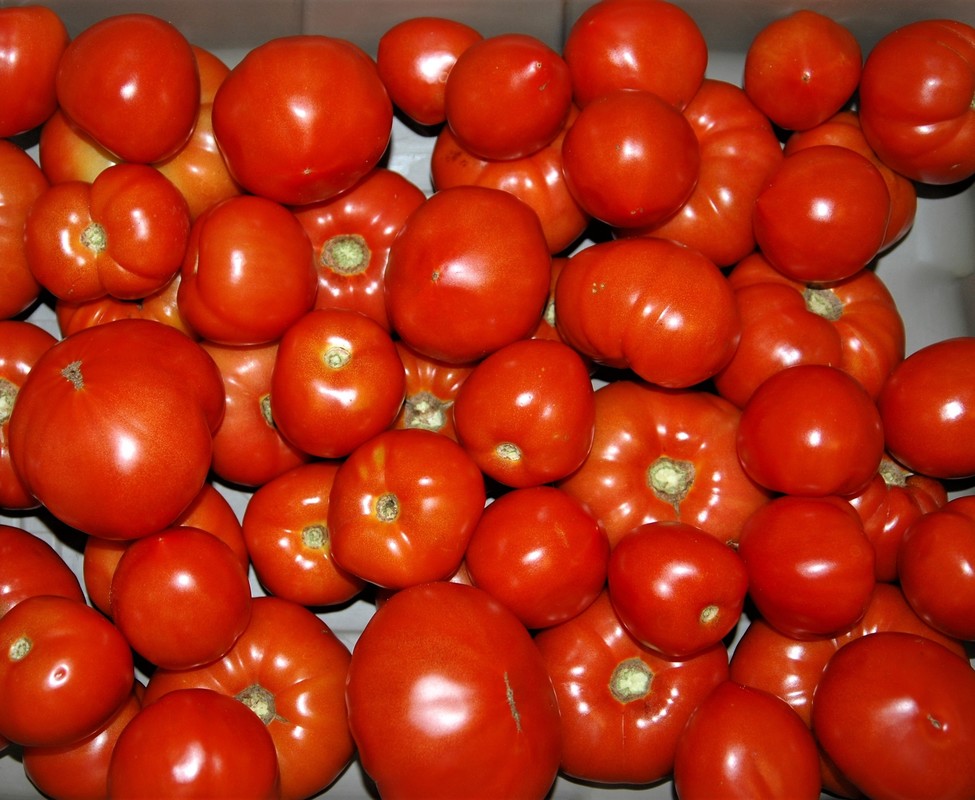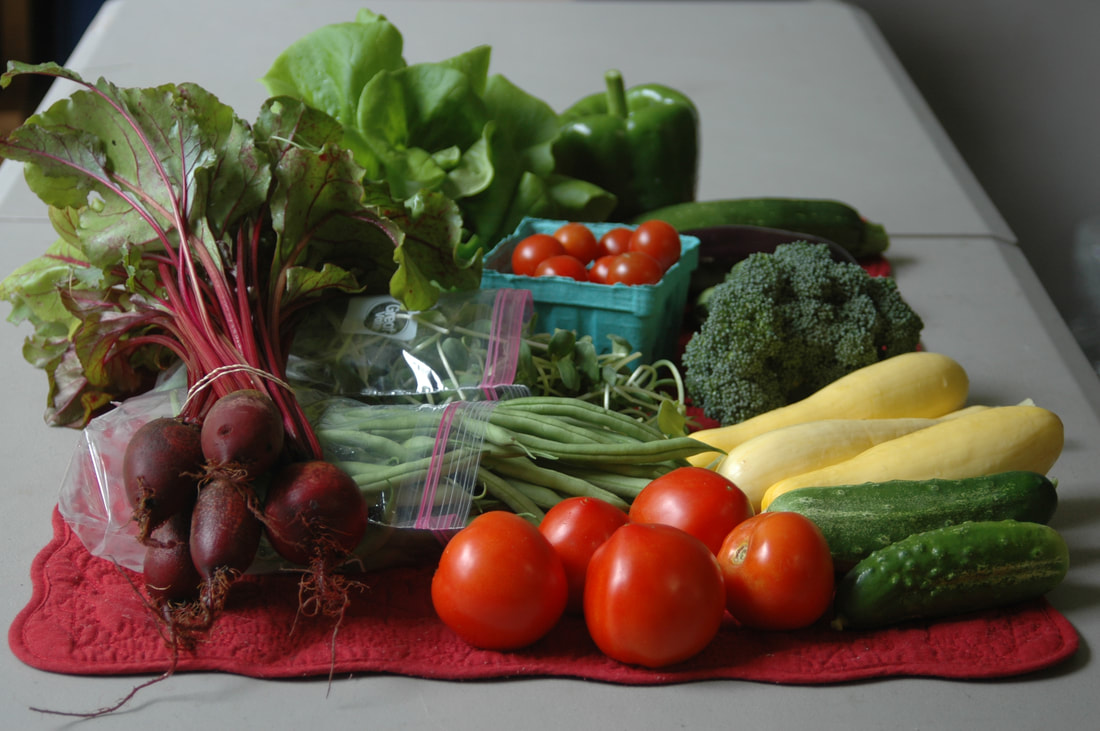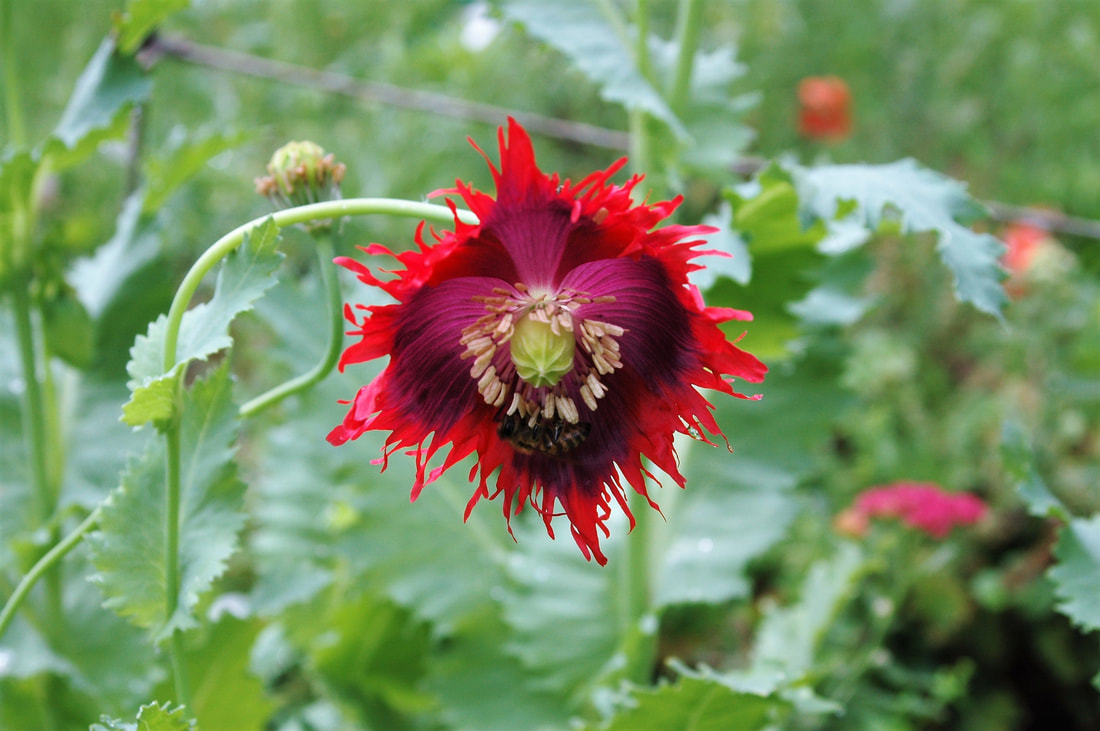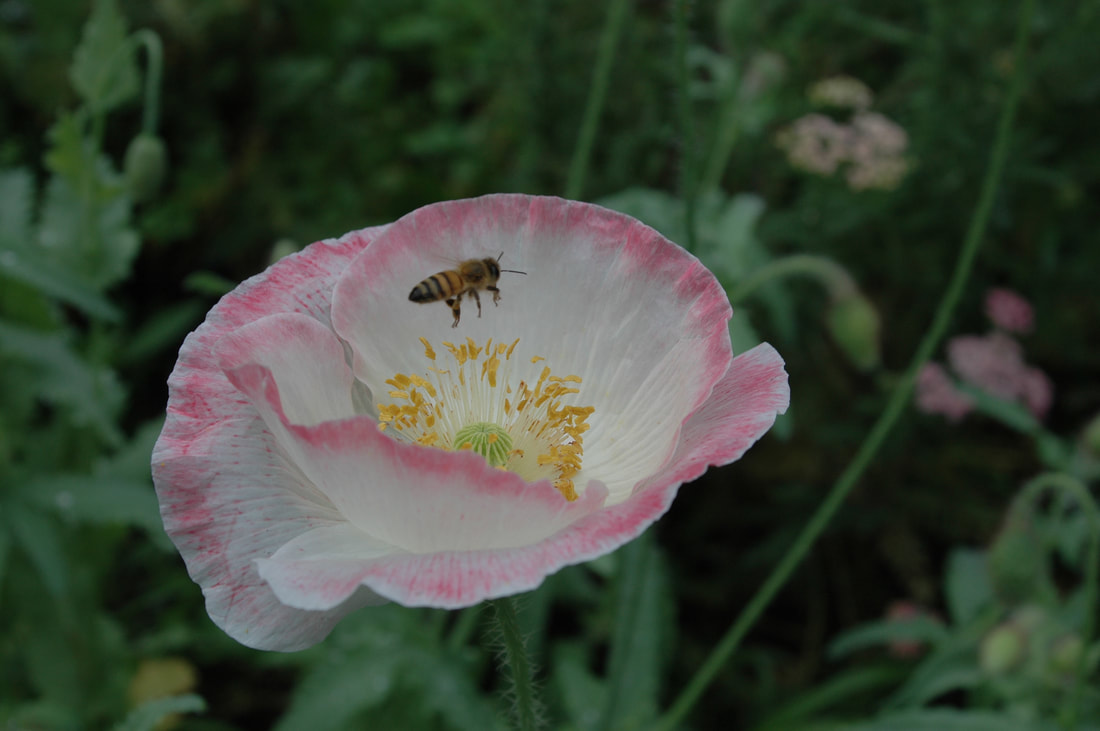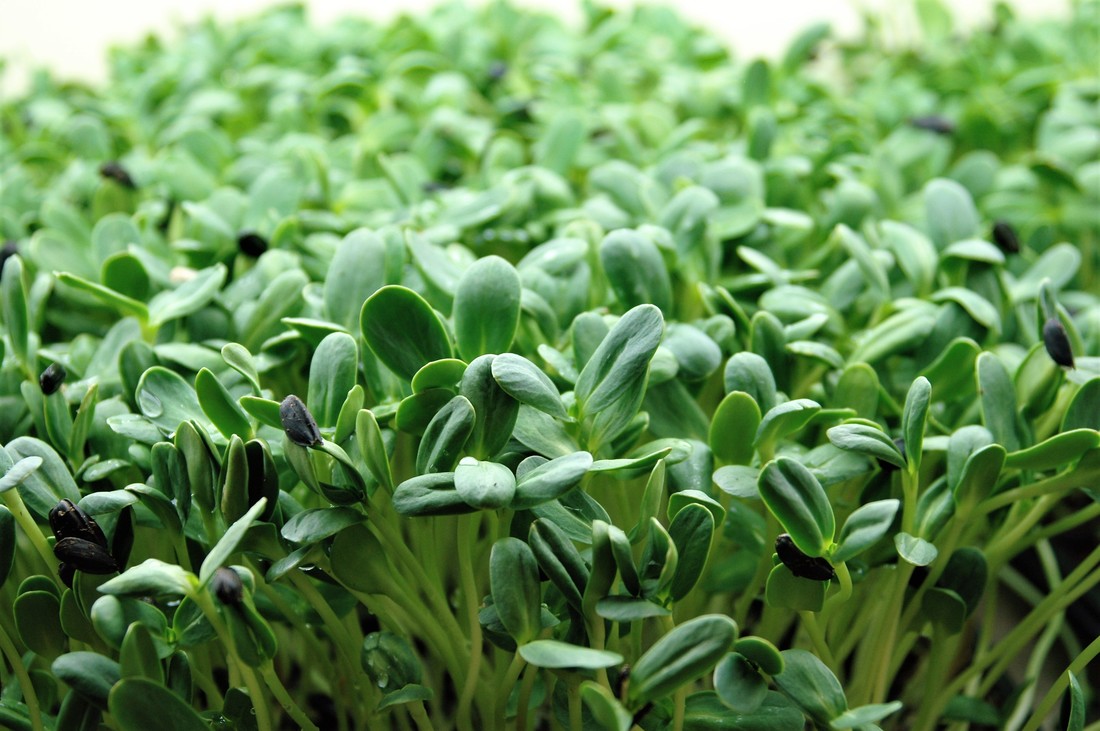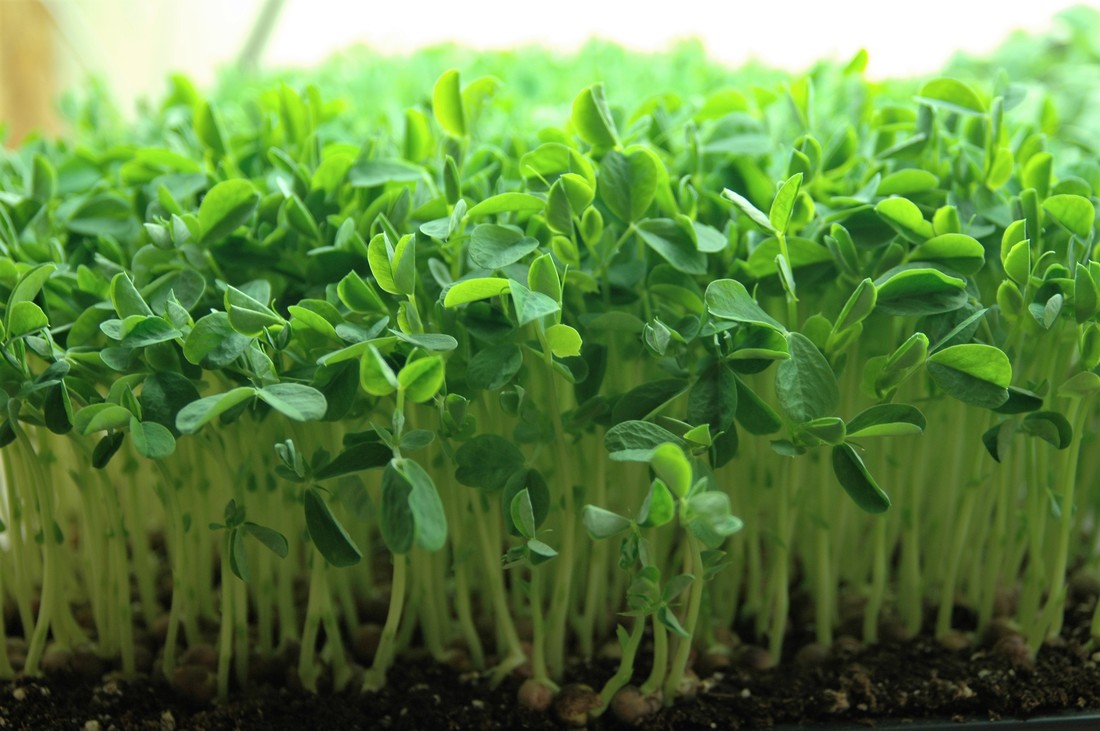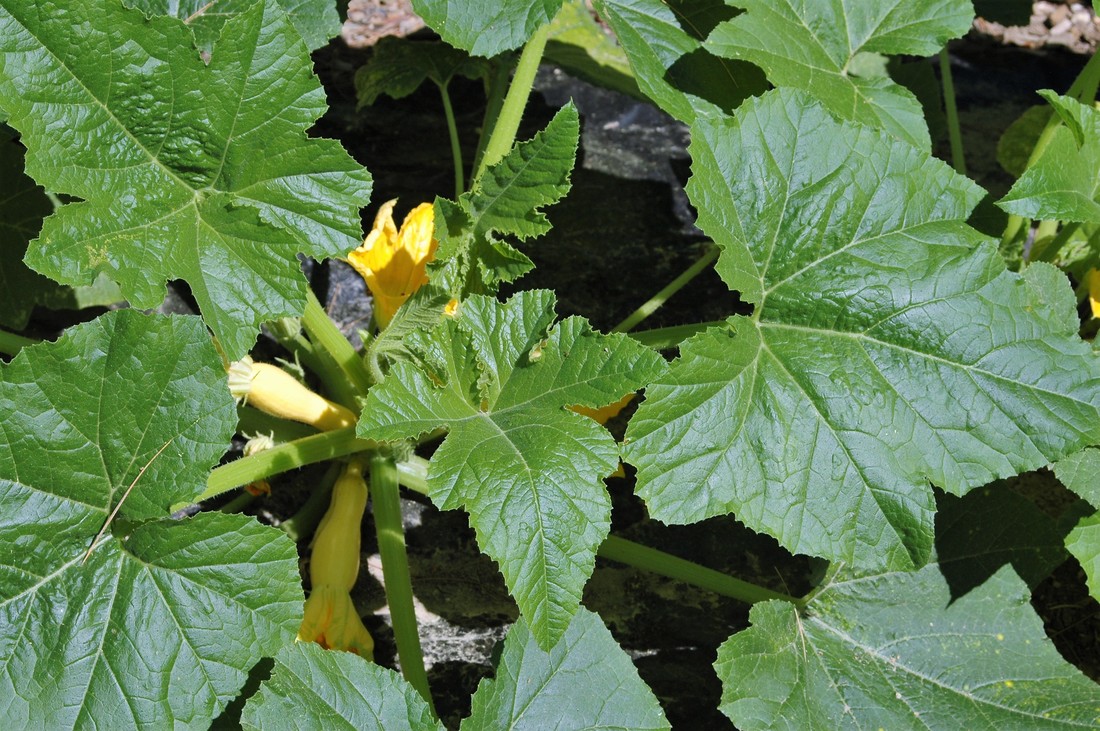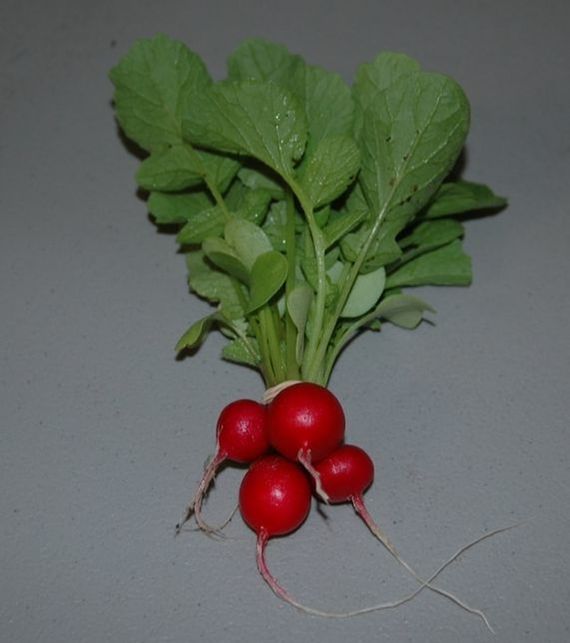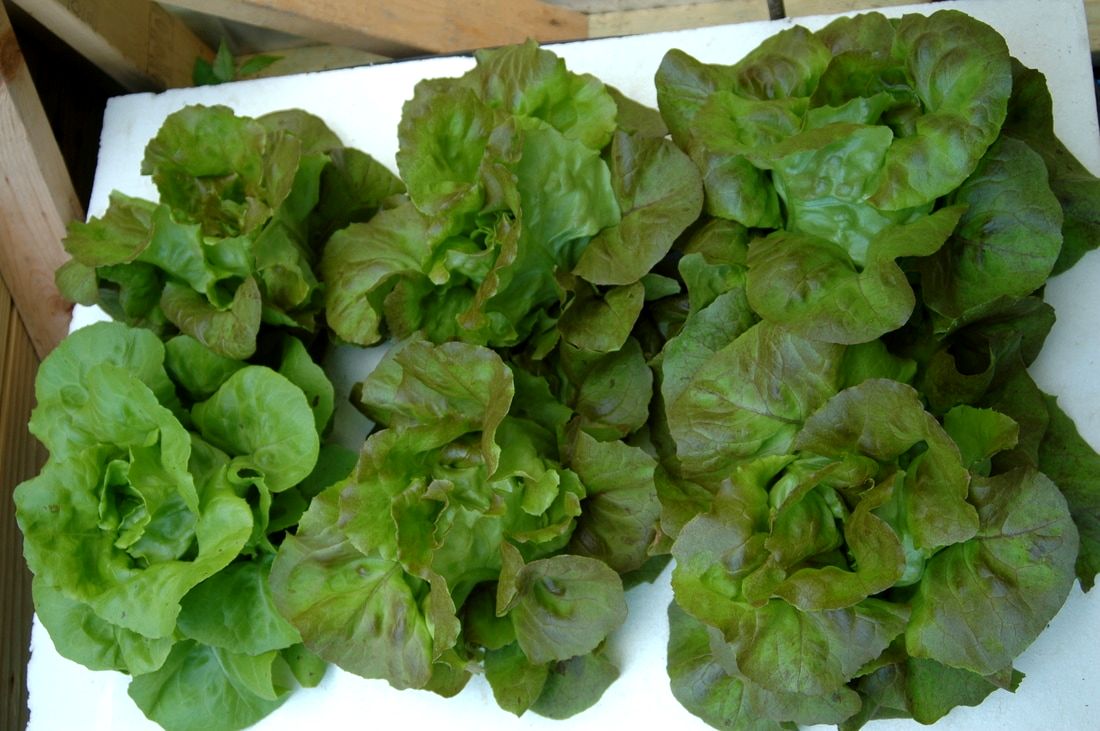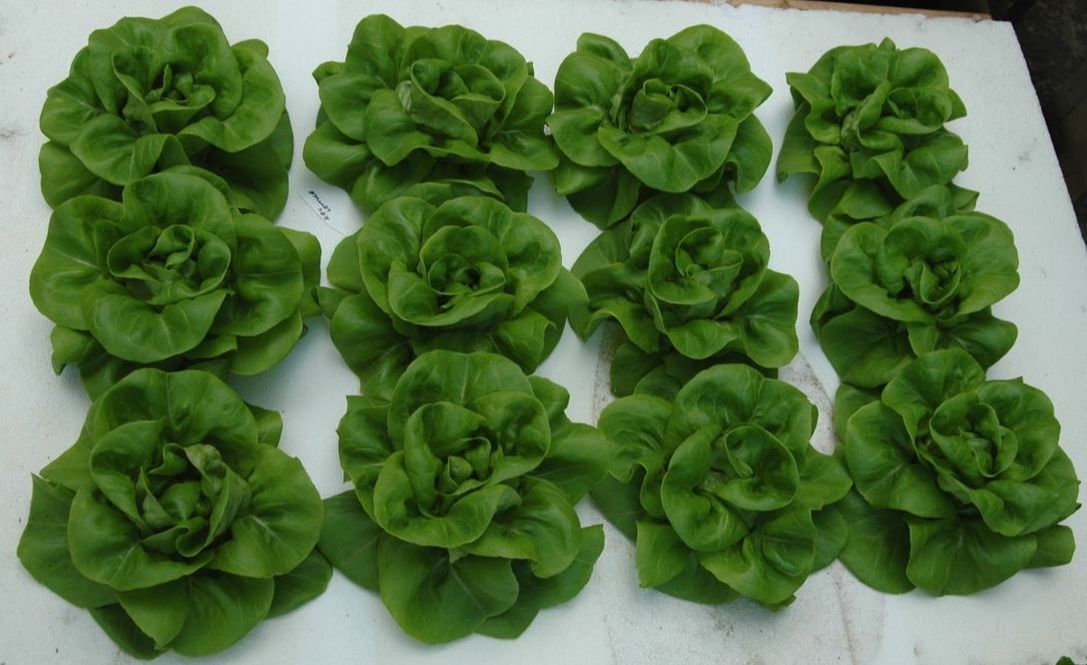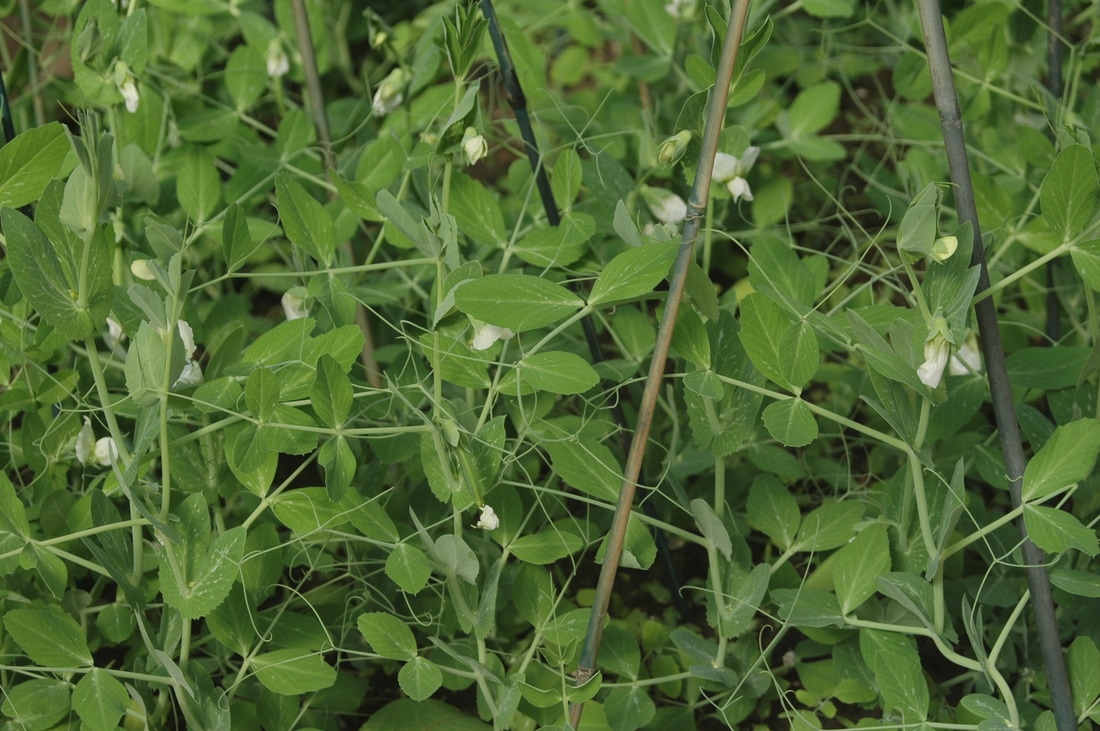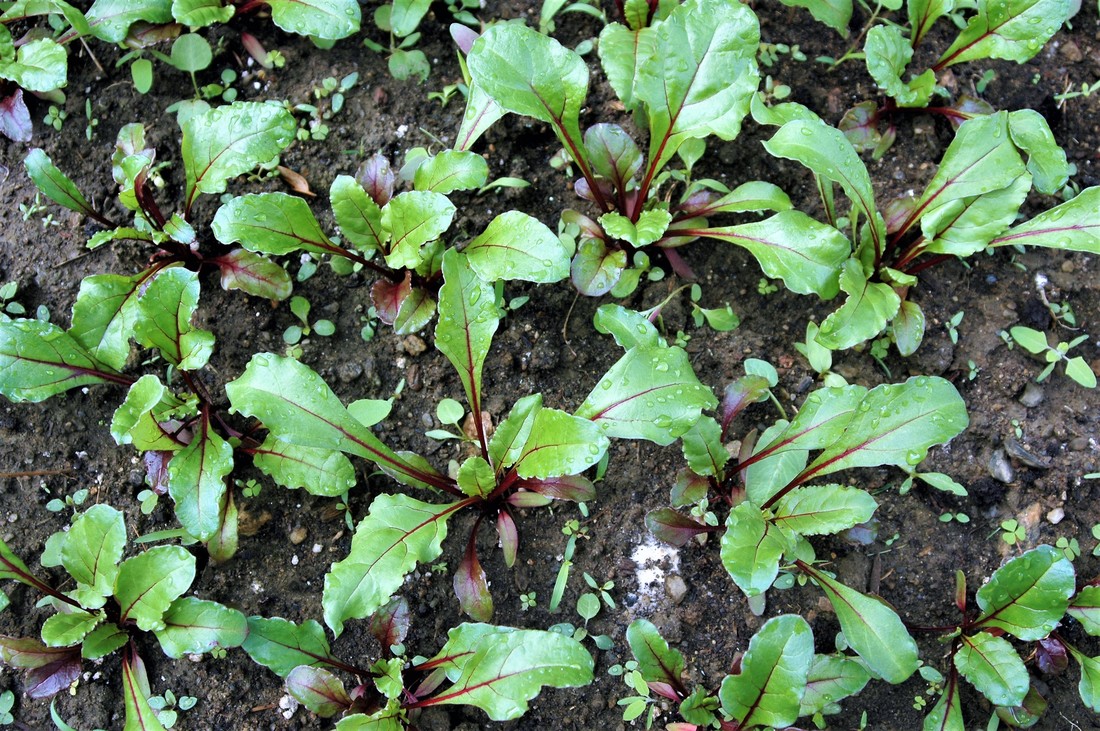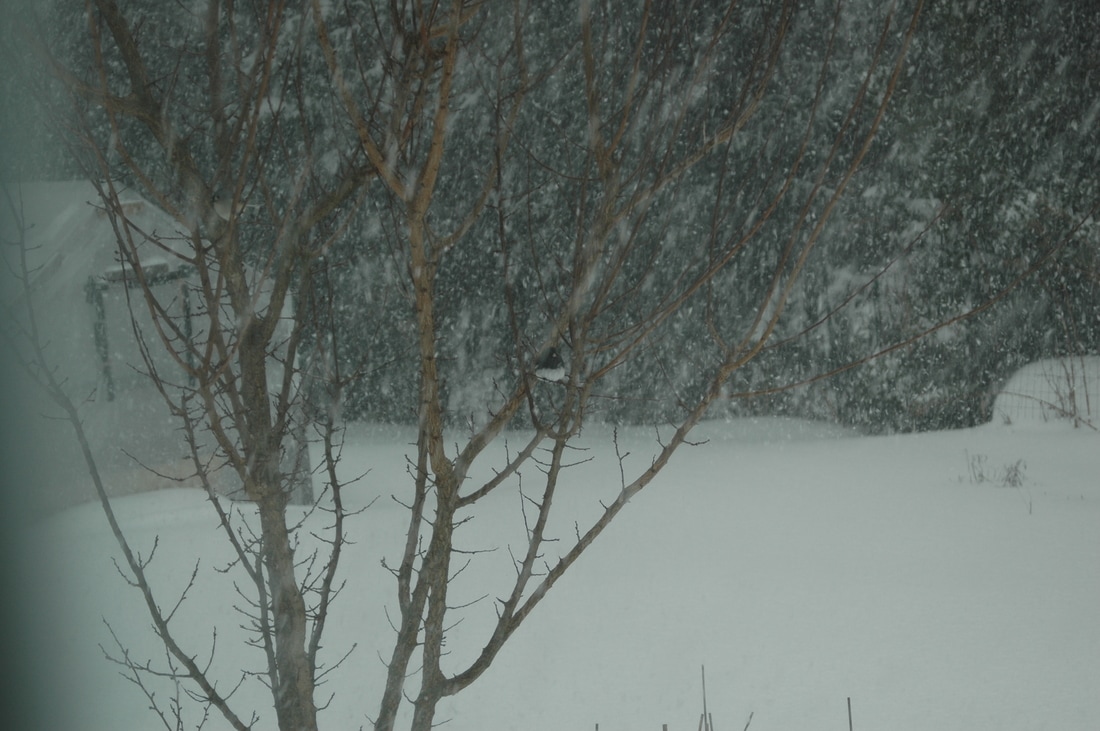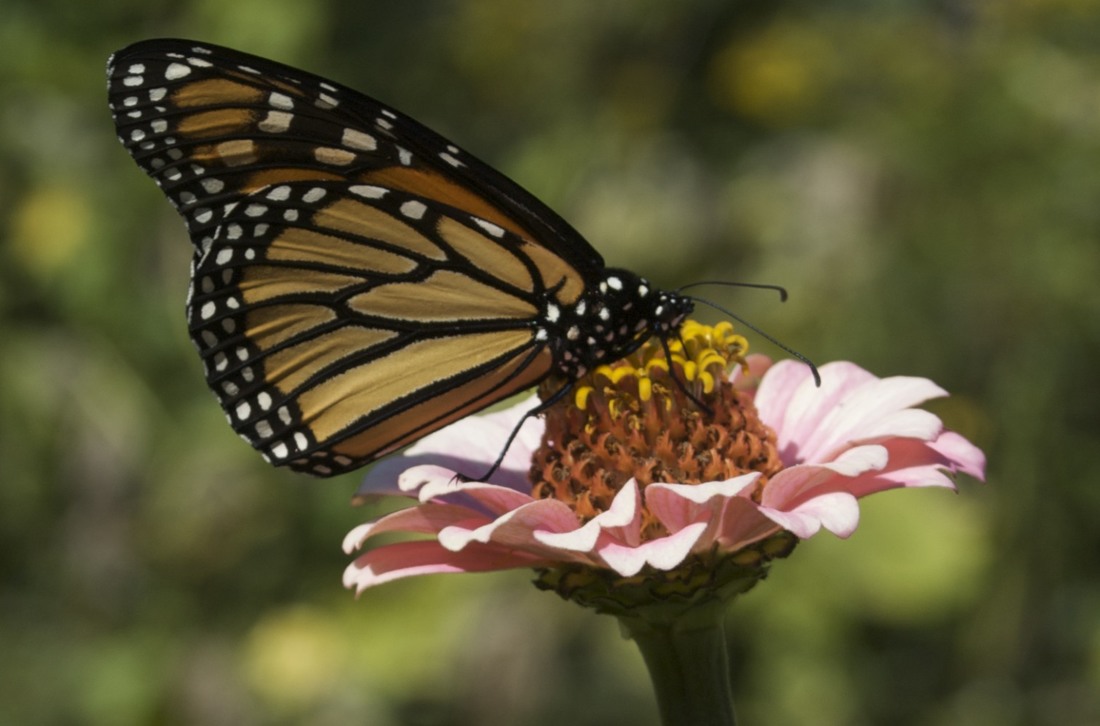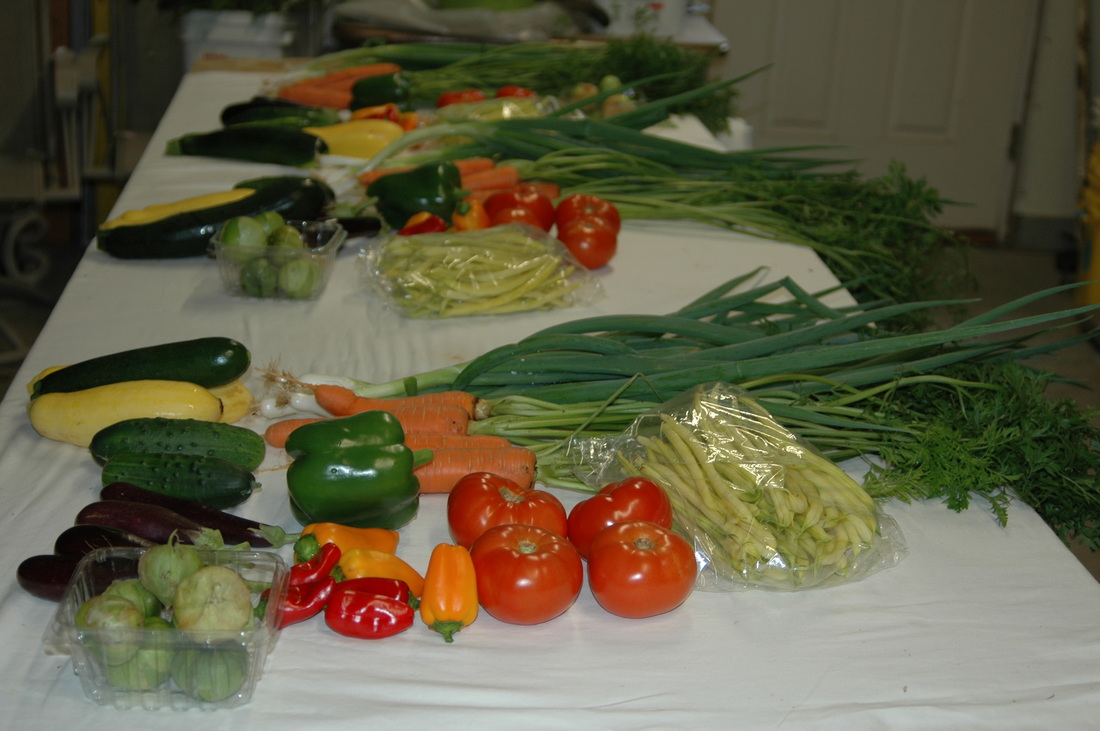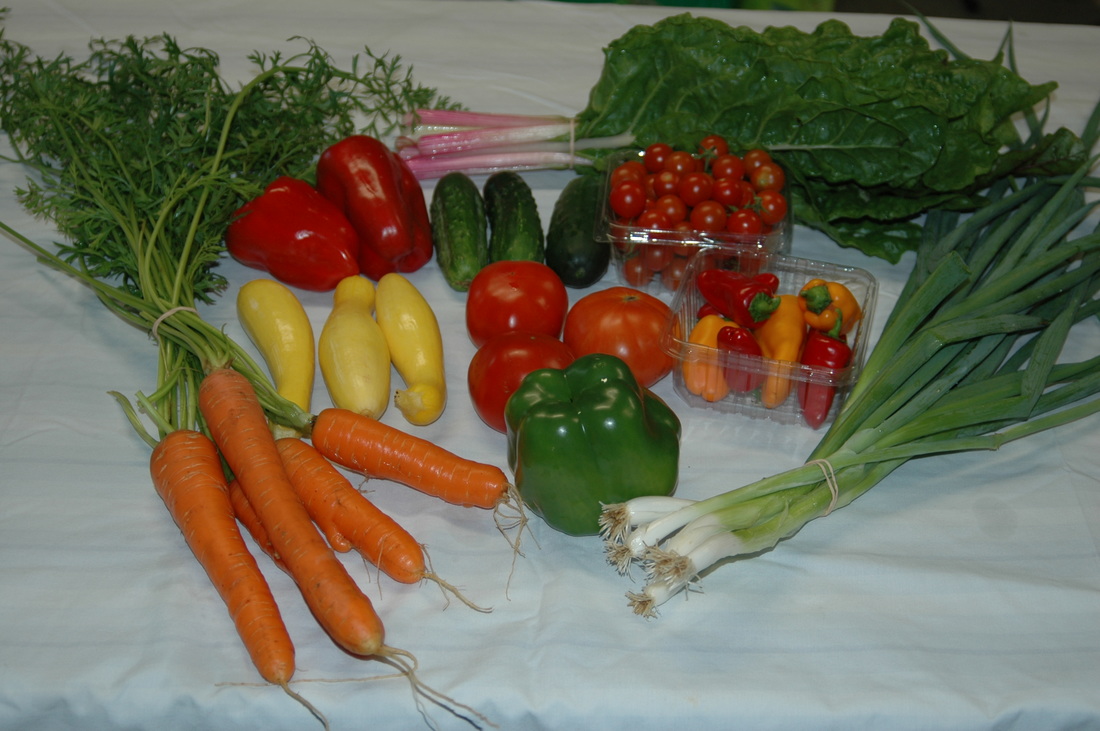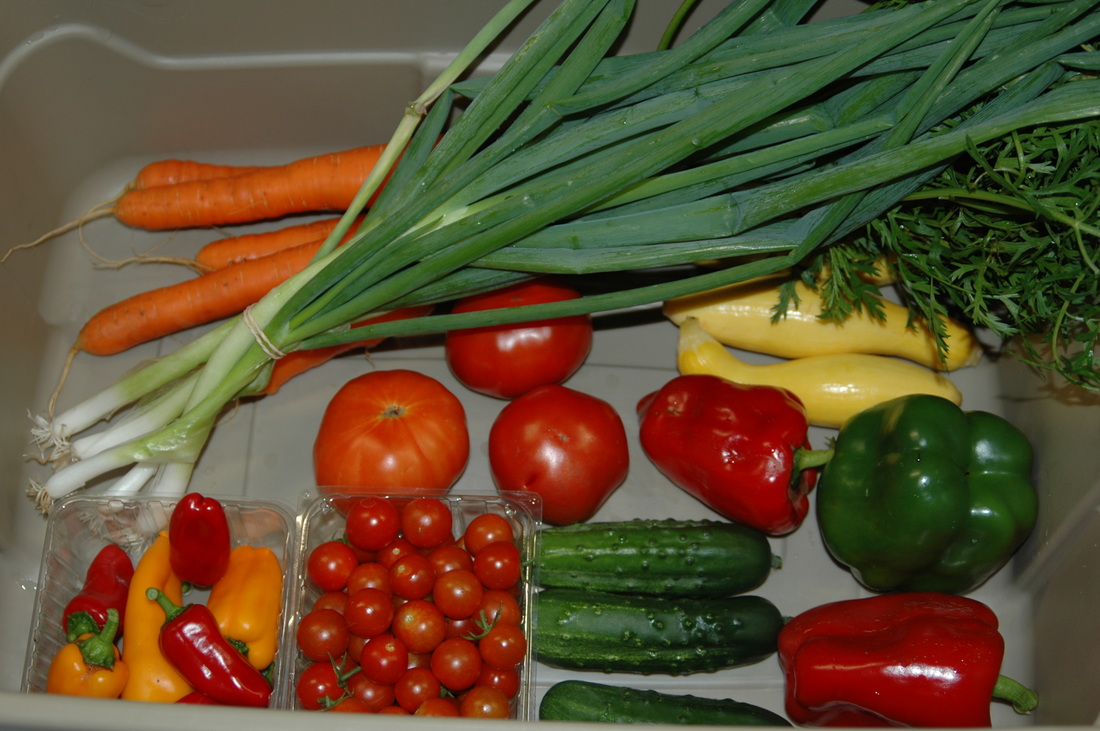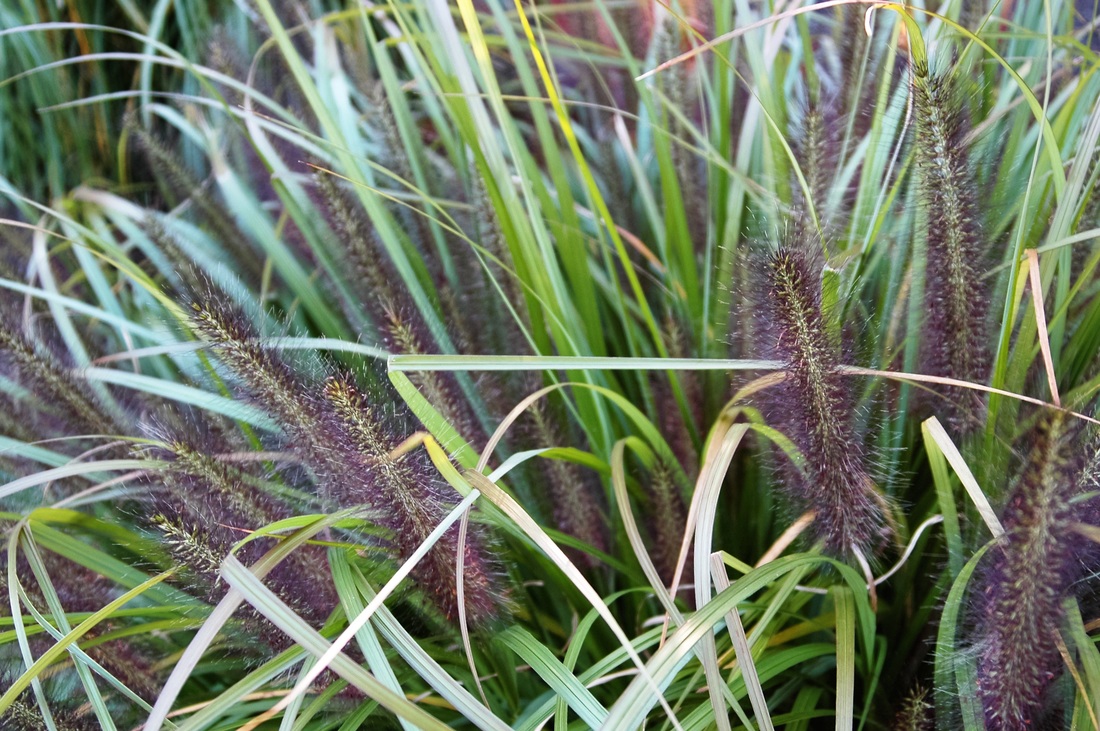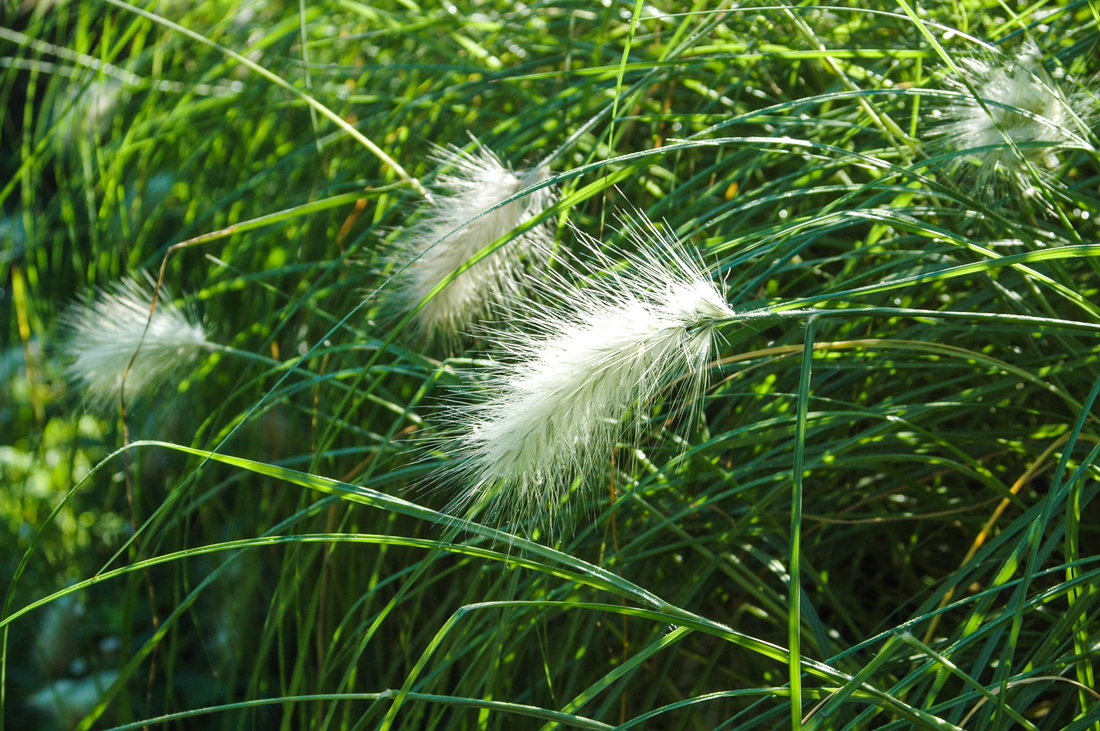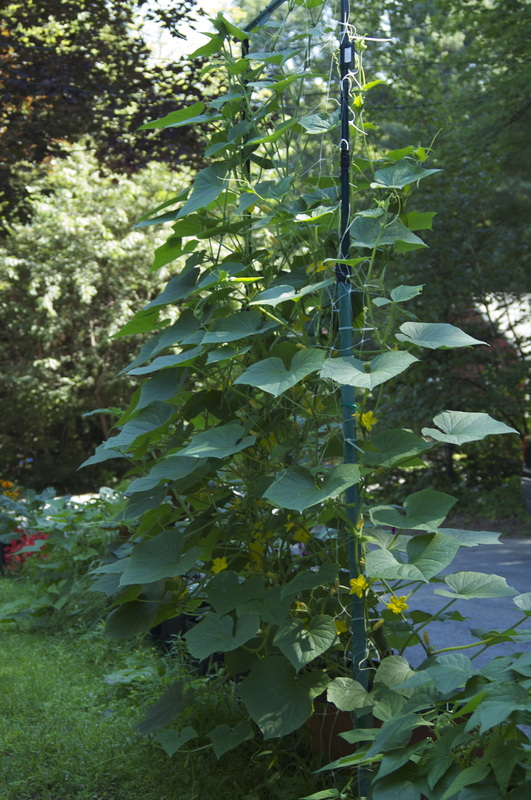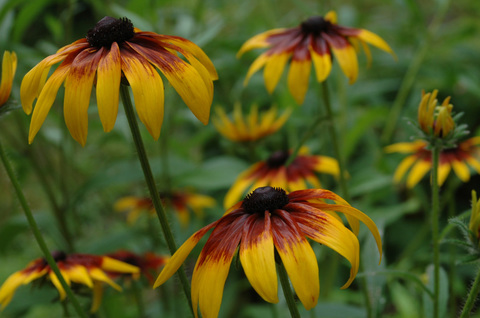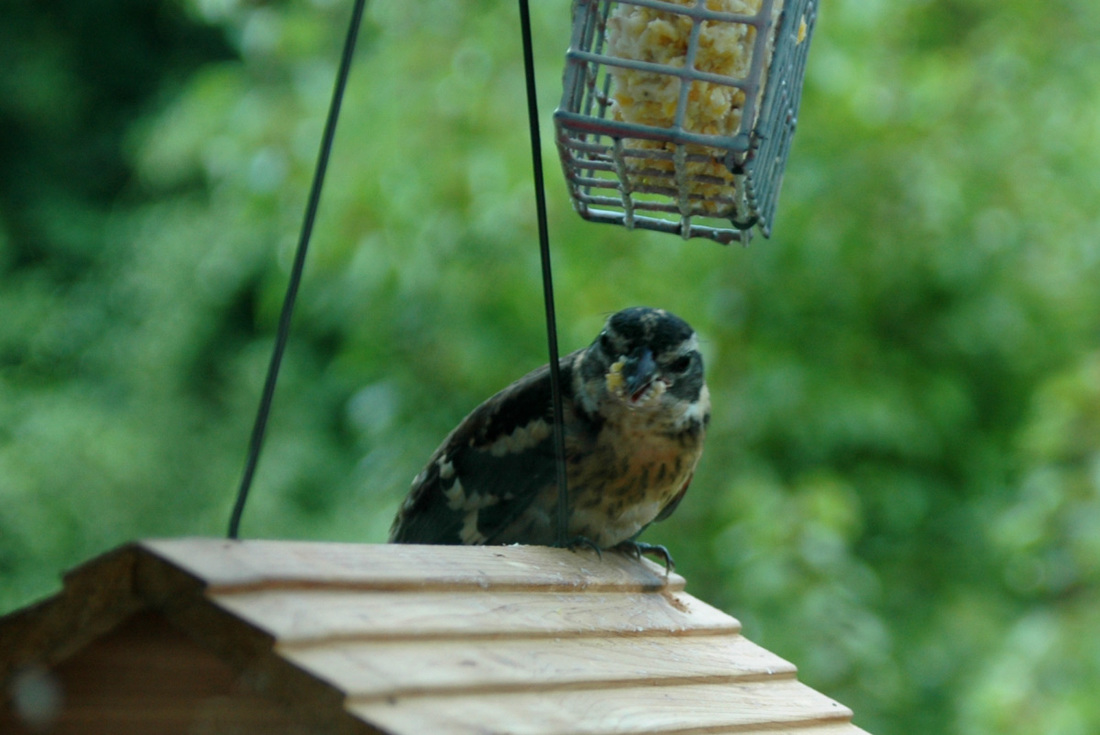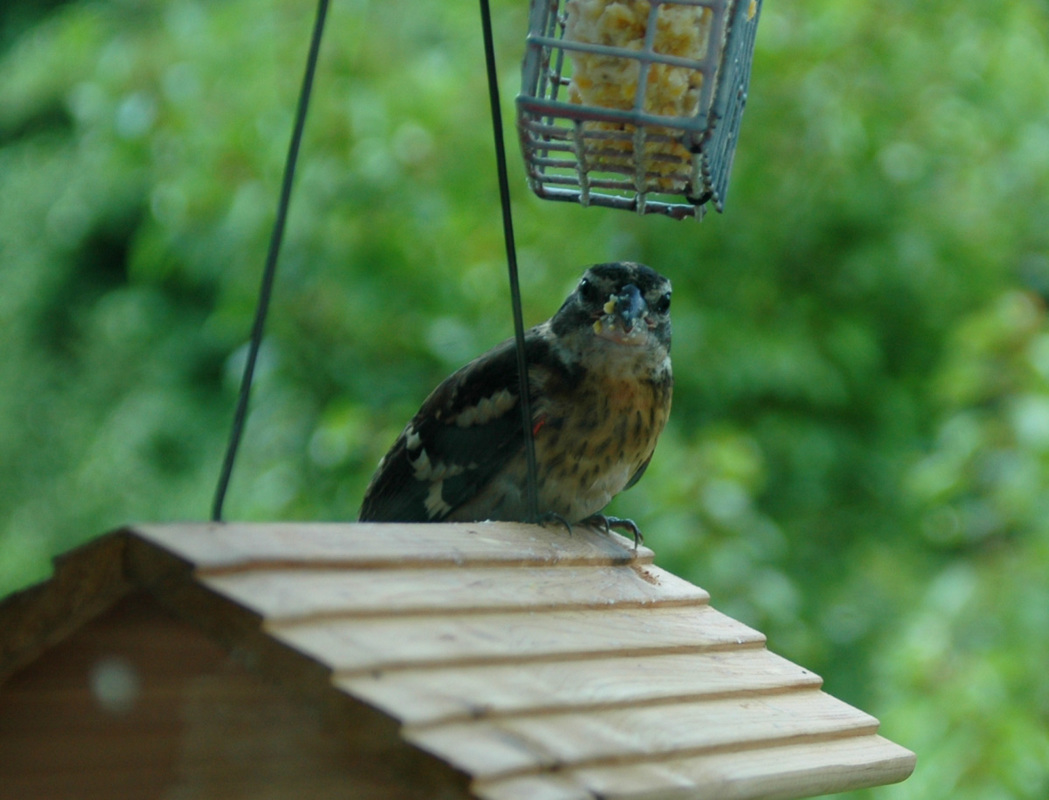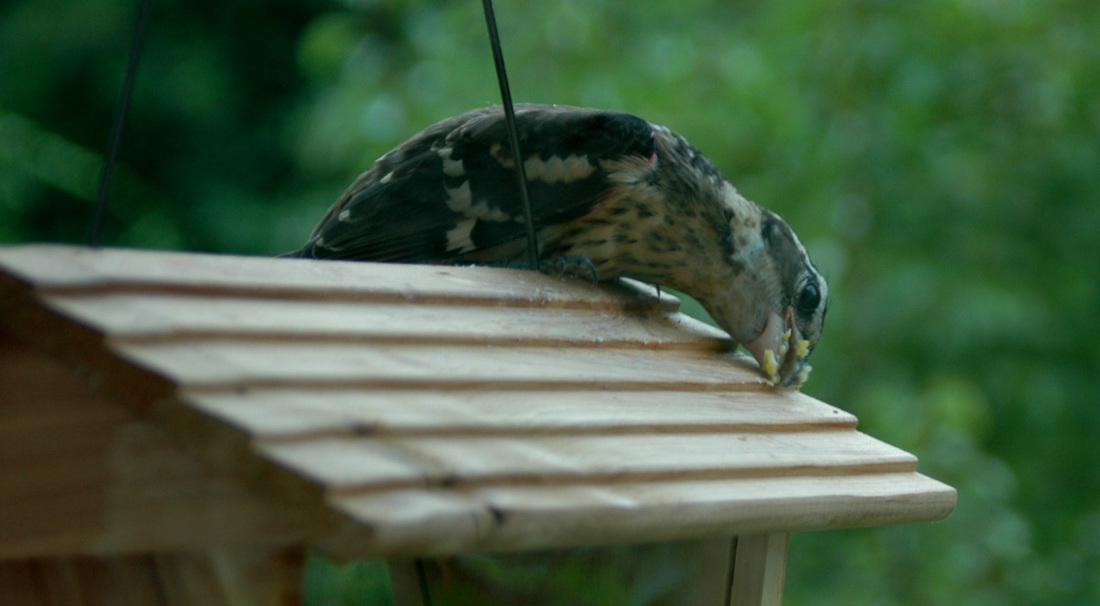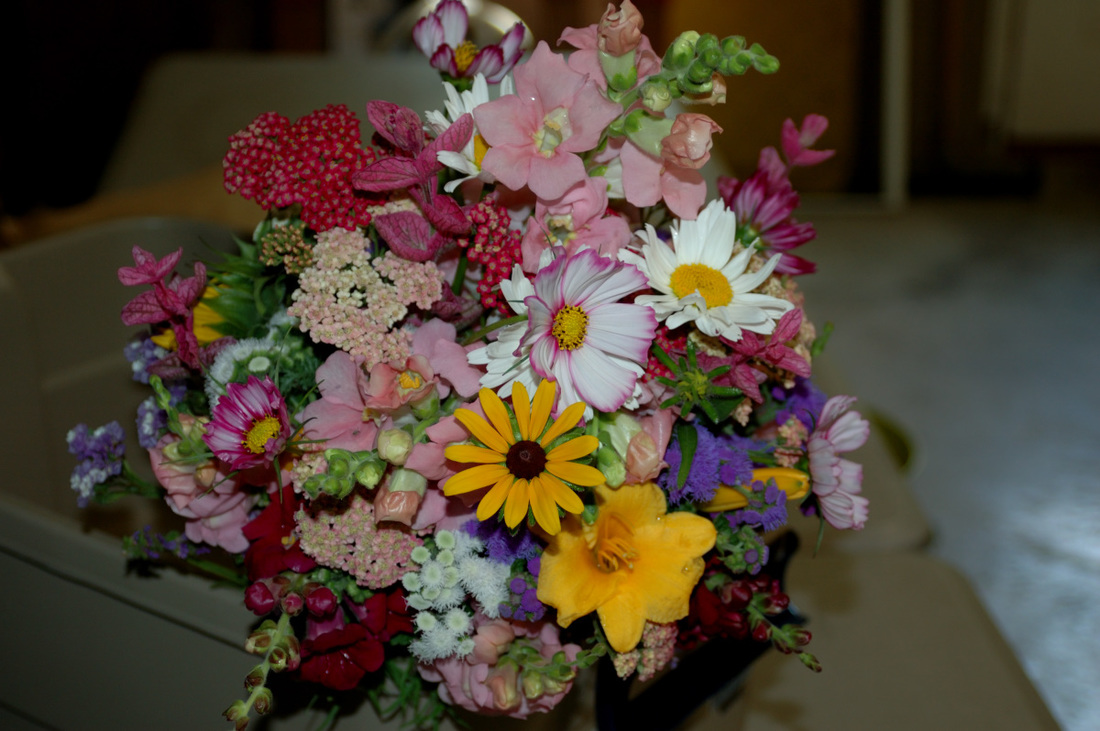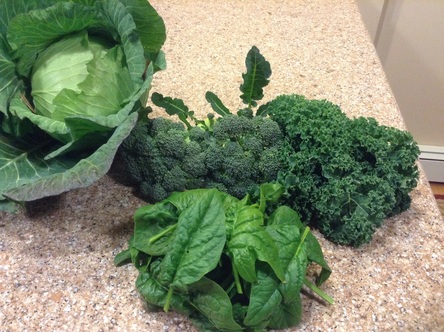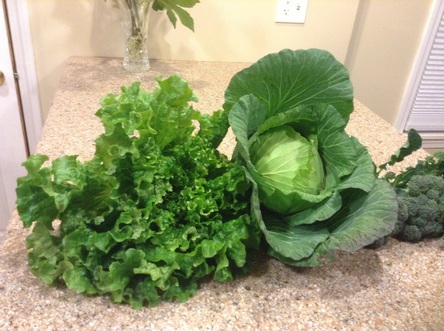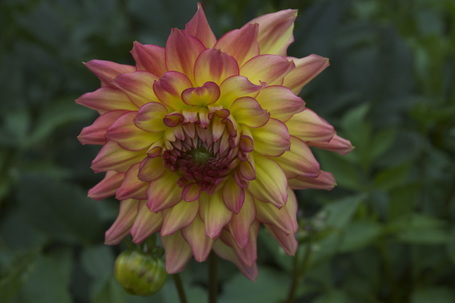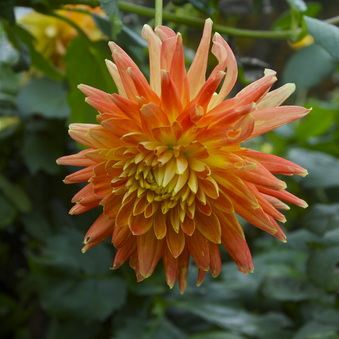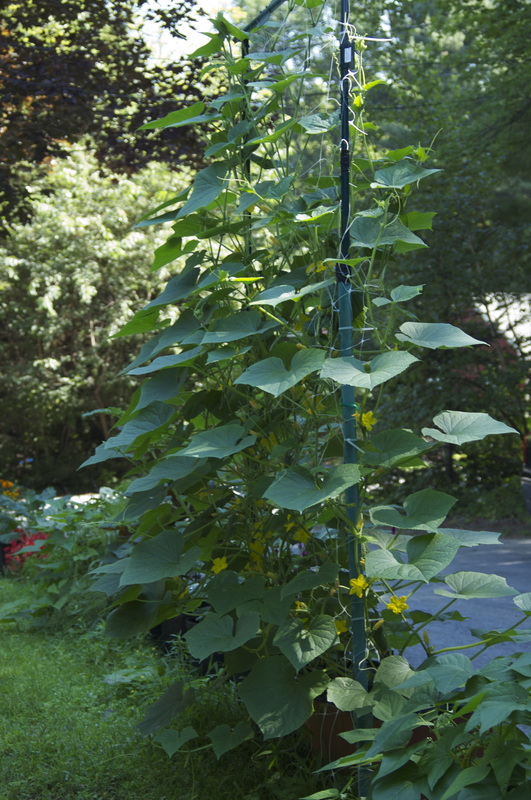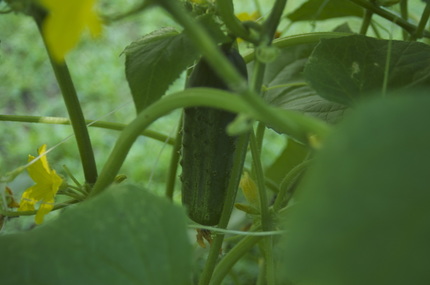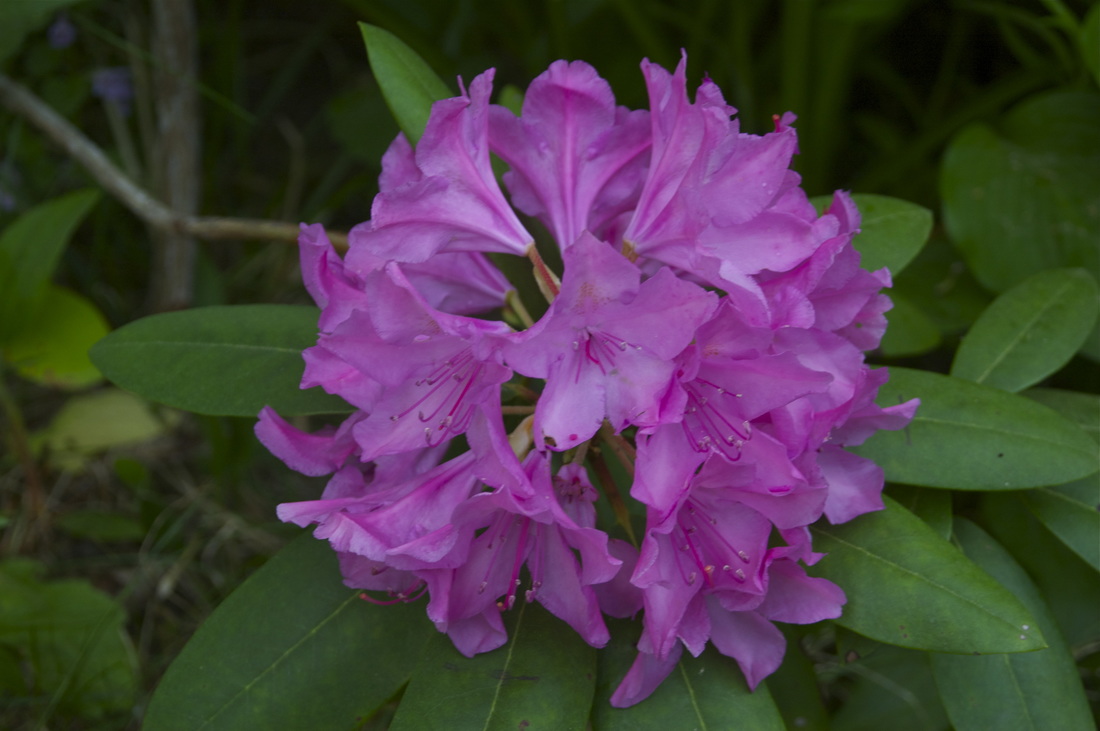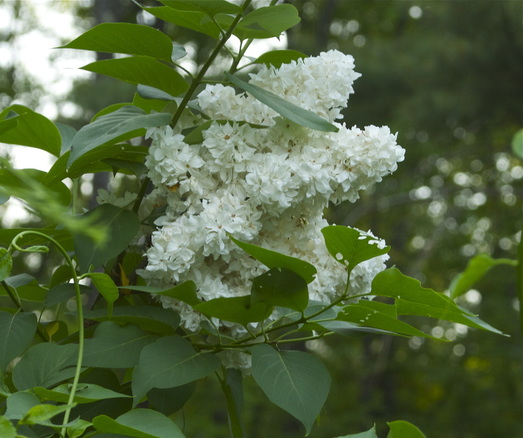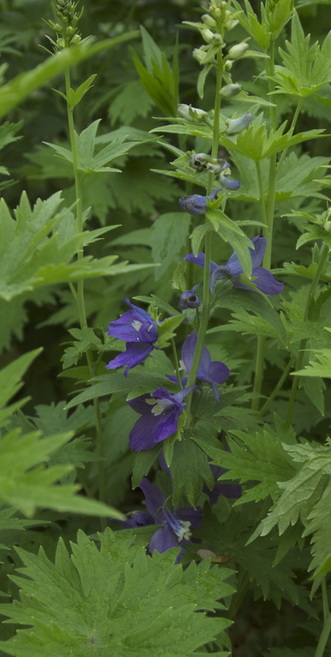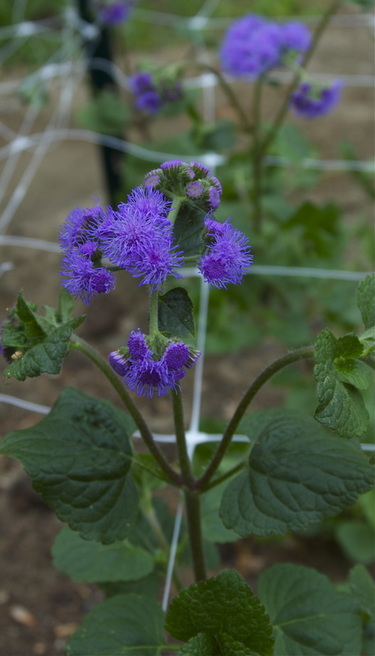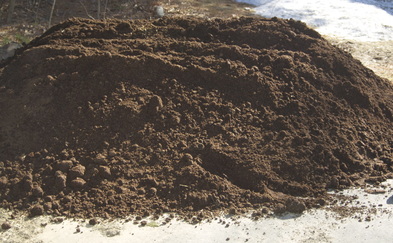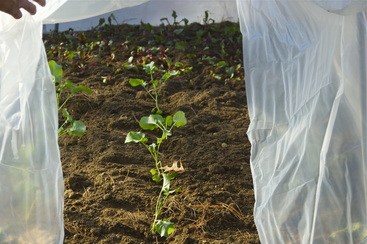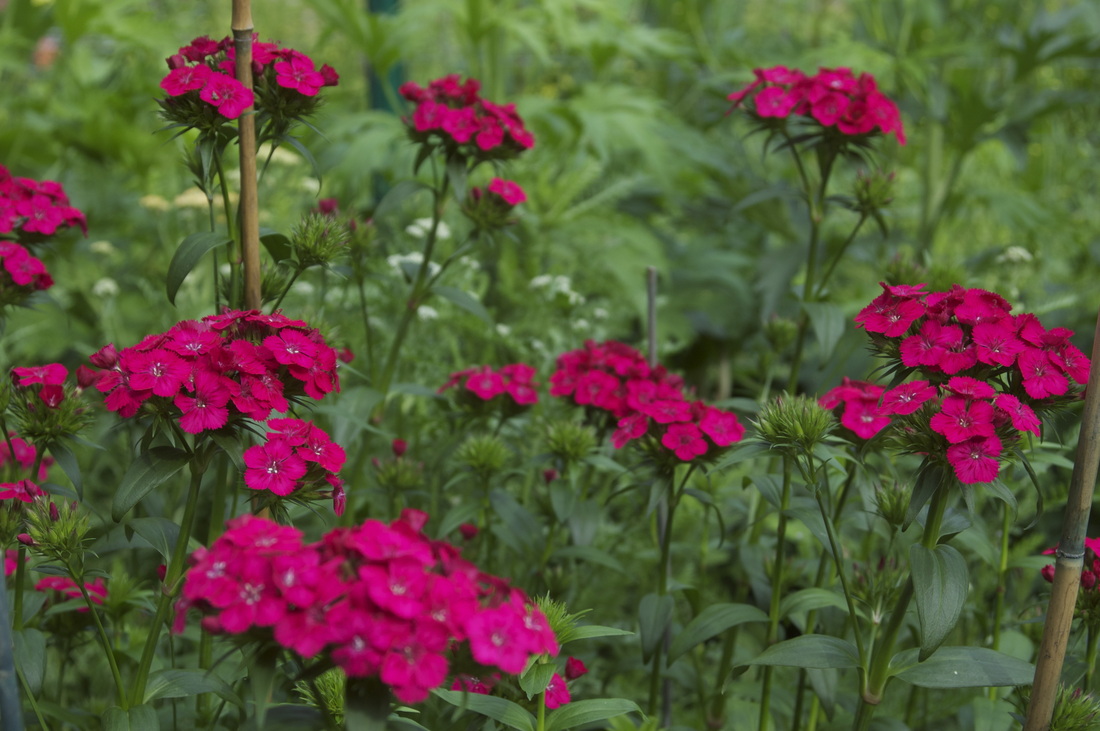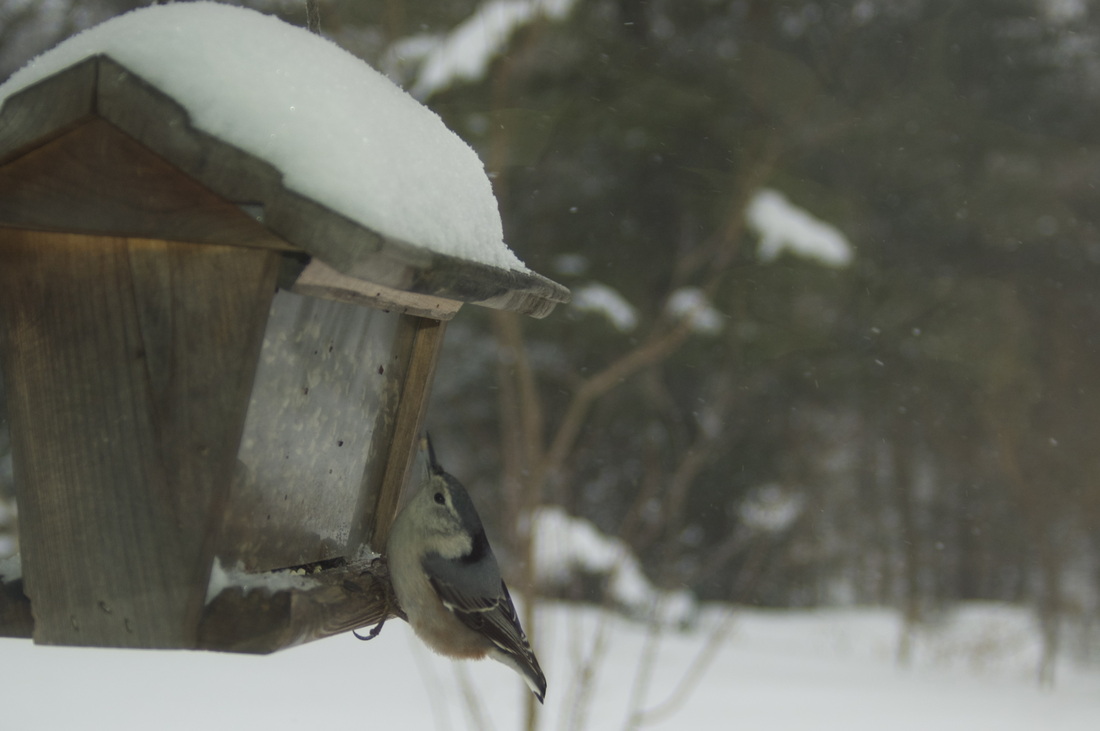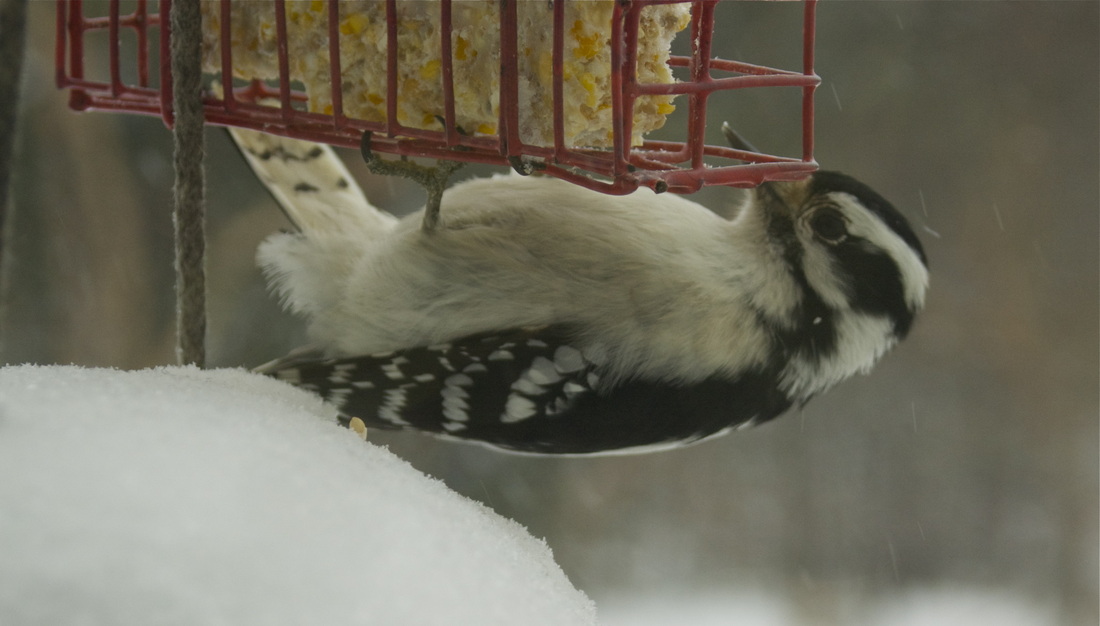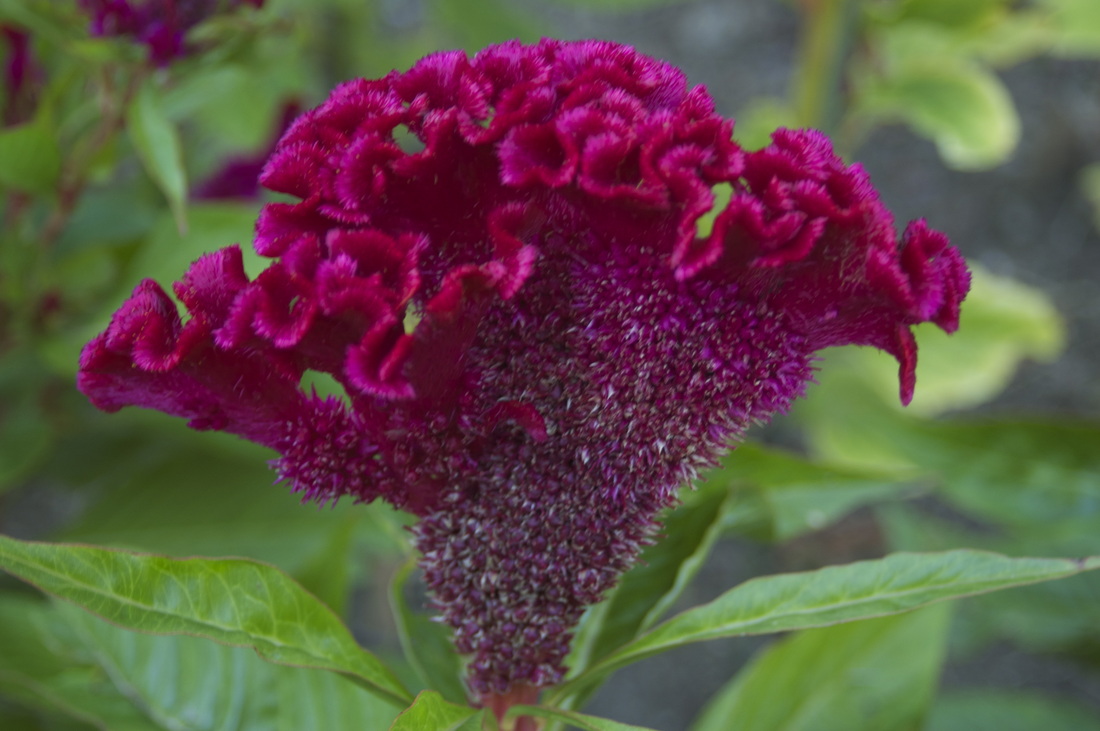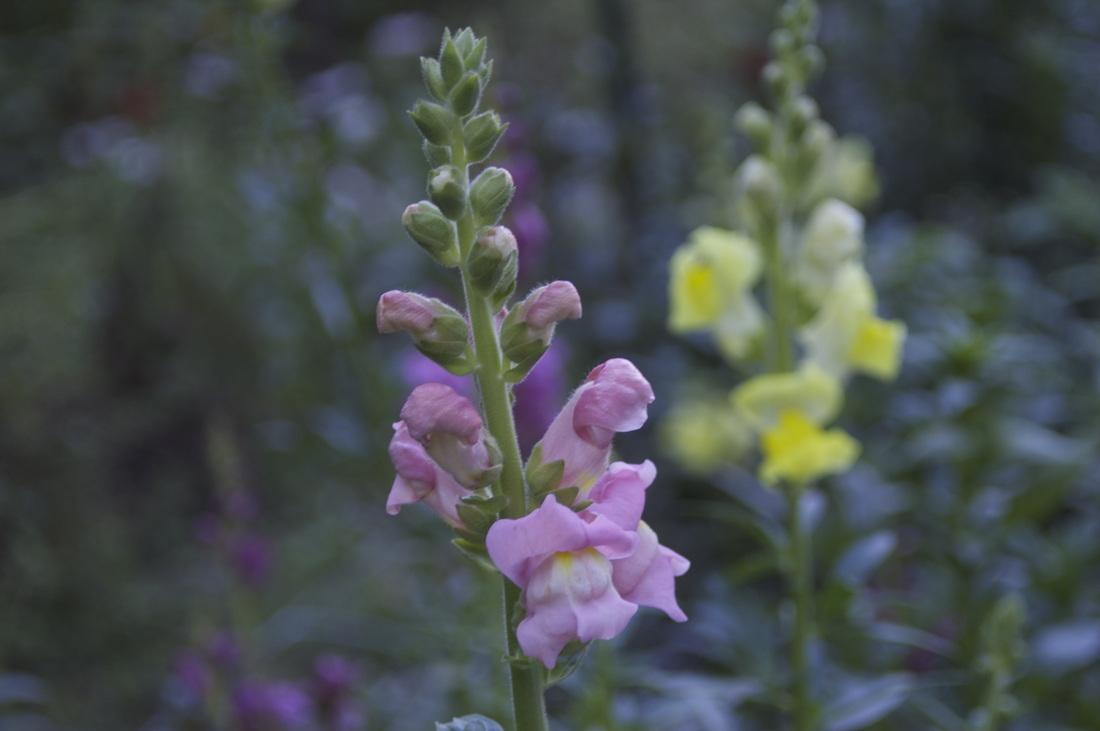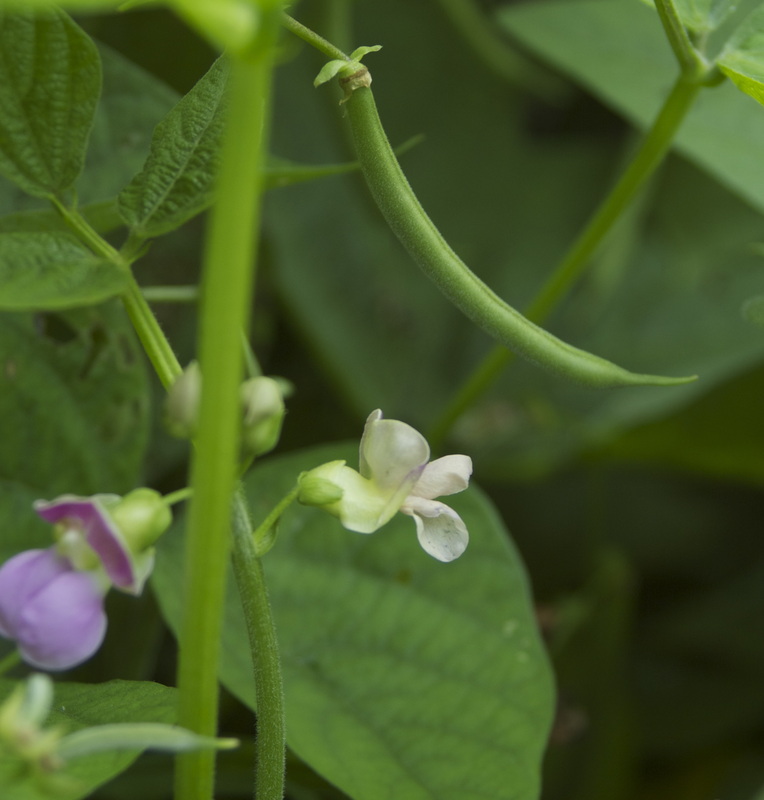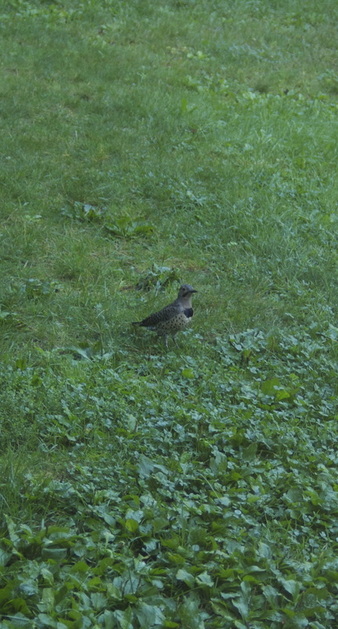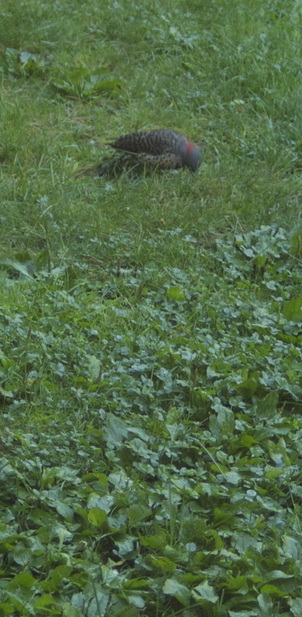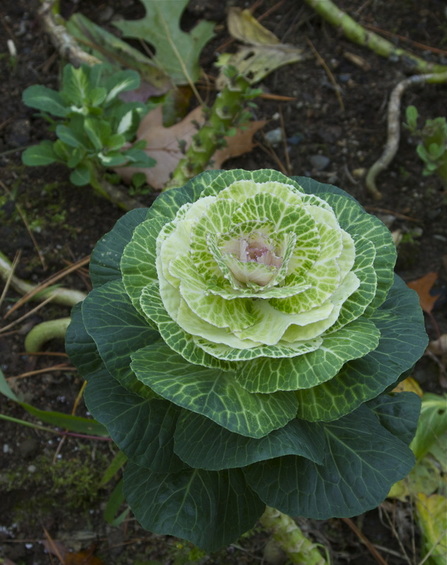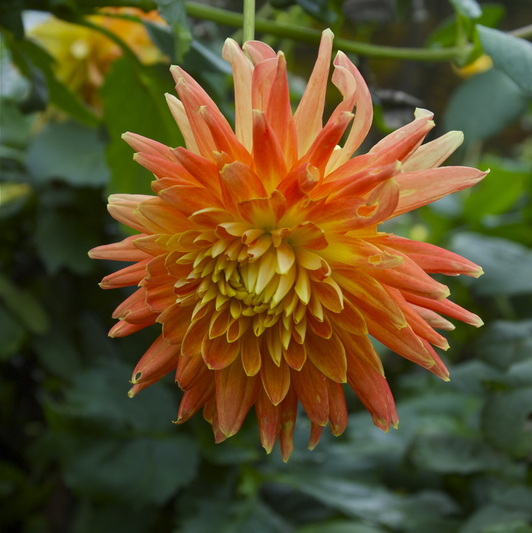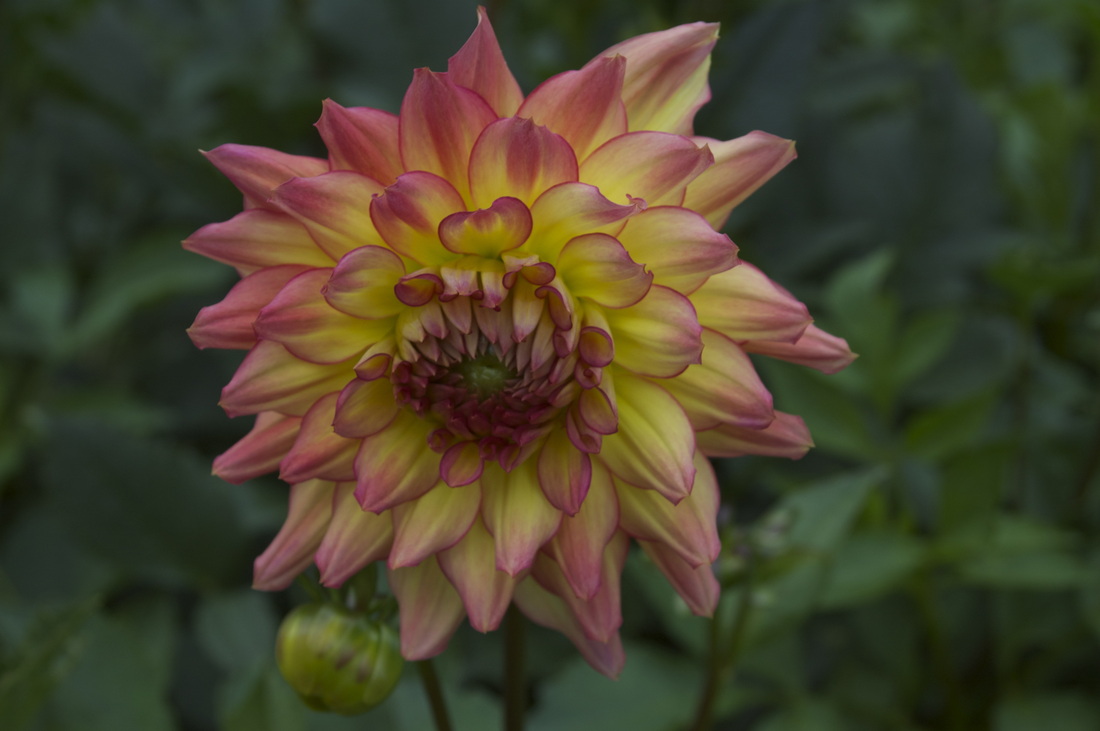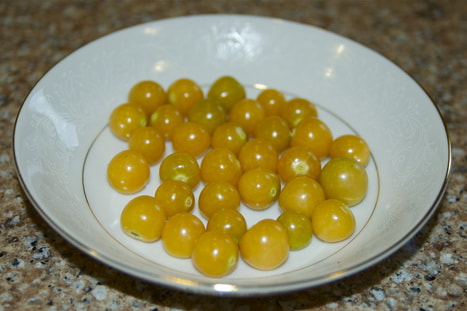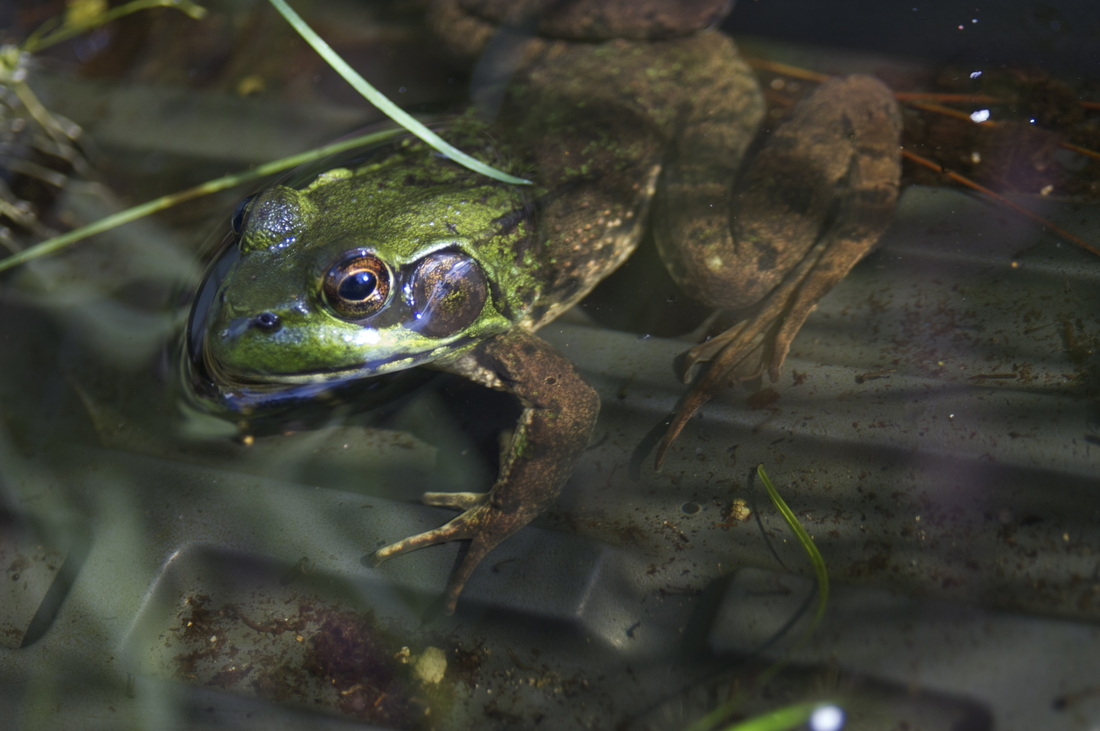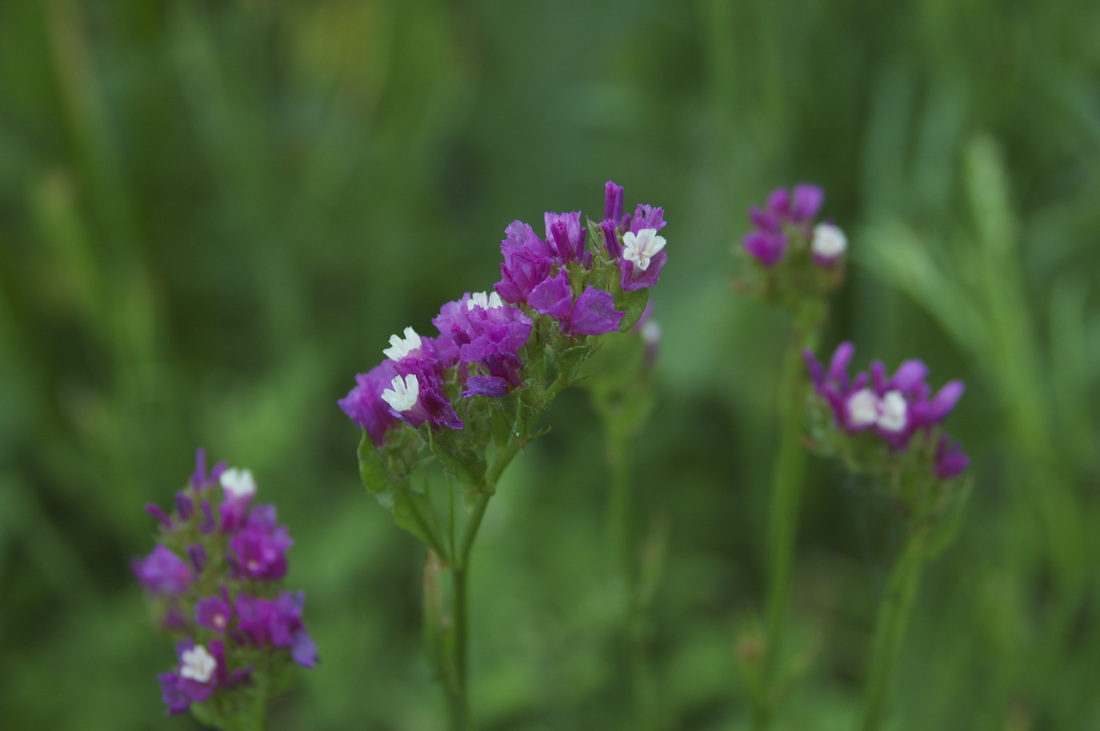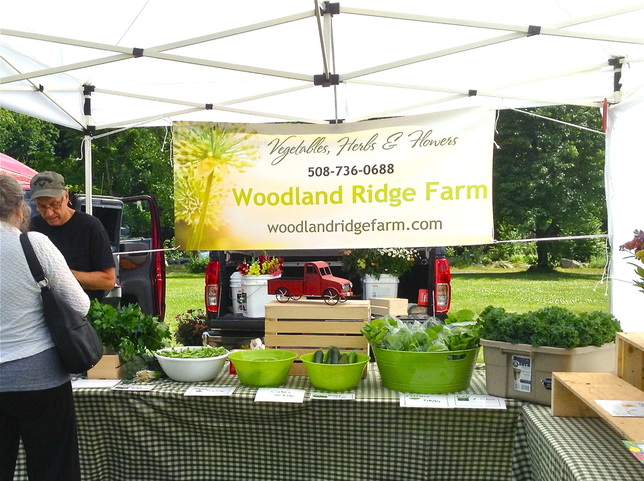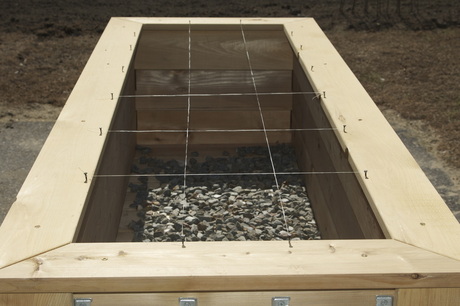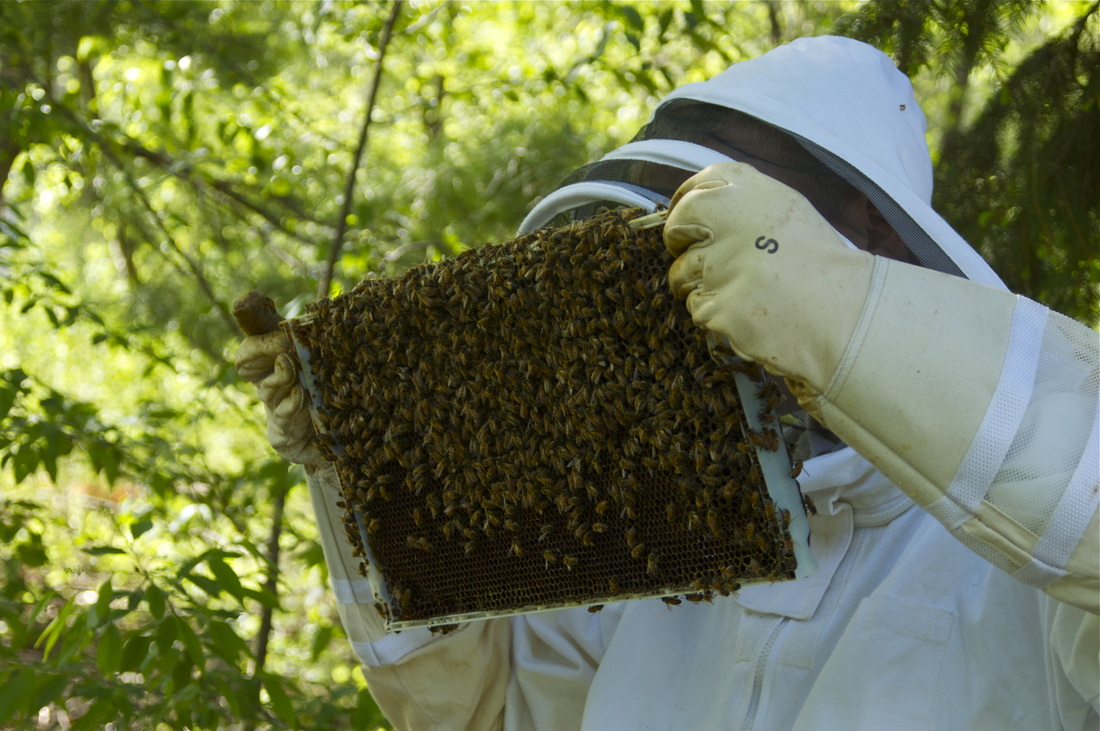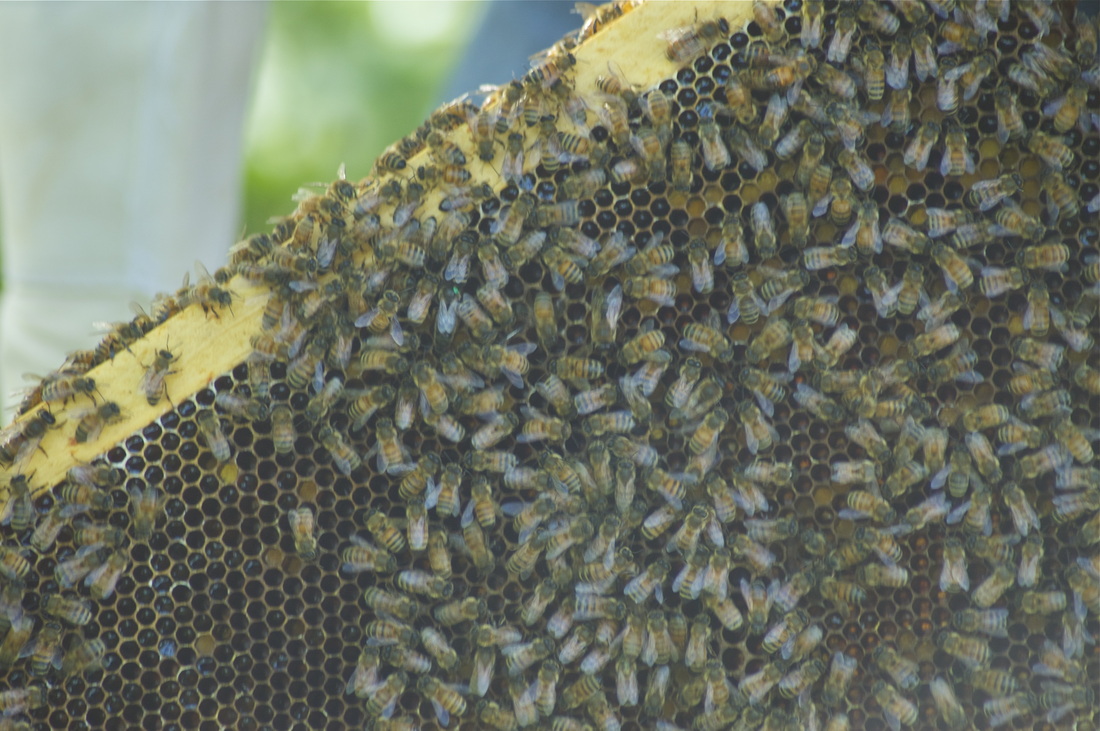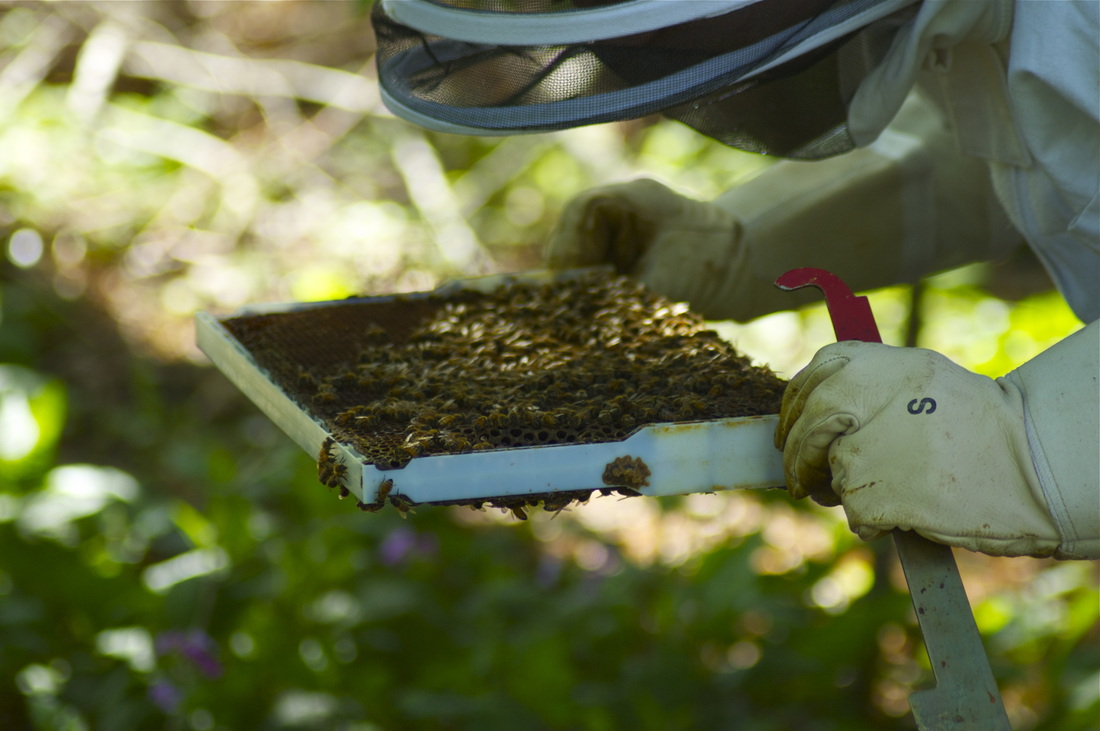Madison's Tips
Our dog Madison is an energetic veggie and fruit lover. She waits quietly for her share of the kale when we make smoothies. Friday morning is her favorite time because Phil gives her the kale and Swiss chard stem ends when he bunches and trims them. She HAS TO spend part of every day retrieving and loves to meet and greet new friends. She will offer new tips throughout the year. Check back often to see new ideas!!!
* * * *
Why Attract Birds To Your Garden?
Birds are a huge asset to the gardener. We plant shrubs and flowers that attract them, offer water and provide food during lean months of the year to keep our birds a happy part of our farming "family". A few of our favorites are:
Black-capped Chickadees
We enjoy the company of these birds all through the snowy days of winter. They eat the seeds at our feeder that augments their diet until they switch to their almost 90% insect summer diet. Once the female sits on the nest and during the two-plus weeks that the young are in the nest - the male will make 200 - 300 trips to the nest daily, bringing them larvae, insects and insect eggs. He even checks under leaves for hiding eggs. This continues after the young are on their own while they are learning to find their own food.
Phoebes
We are thrilled each year when the Phoebes return and build their nest under the overhang of our back roof. They are great allies and consume many insects and pests including both 12-spotted and striped cucumber beetles, leaf miners, caterpillars and ticks (which Madison especially appreciates). Their diet is almost entirely insects. I enjoy watching their erratic tail bobbing as they perch between catching flights.
Baltimore Orioles
These beautiful birds eat insects during the summer, and especially enjoy caterpillar larvae. They switch to dark-colored fruit in the fall and prefer the native fruits that we plant (to encourage them to continue to build their incredible silky hanging baskets high in the trees). We have recently added serviceberries ( shadbush) to the chokecherries and wild concord grapes that grow in our area.
Barn Swallows
It doesn't take long for the barn swallows to hear the hum of a tiller. They will arrive in short order to swoop over newly tilled soil to scoop up flying insects that have been disturbed. (I'm not sure who arrives faster - the swallows in the fields or Madison when she hears the click of a knife on our kitchen cutting board.) The swallows' voracious appetites are appreciated while they display their beautiful aerial acrobatics. The flashes of iridescent blue and their deeply forked tails make them even more exciting to watch.
Our bug picking team has reassembled at the farm!
* * * *
We enjoy the company of these birds all through the snowy days of winter. They eat the seeds at our feeder that augments their diet until they switch to their almost 90% insect summer diet. Once the female sits on the nest and during the two-plus weeks that the young are in the nest - the male will make 200 - 300 trips to the nest daily, bringing them larvae, insects and insect eggs. He even checks under leaves for hiding eggs. This continues after the young are on their own while they are learning to find their own food.
Phoebes
We are thrilled each year when the Phoebes return and build their nest under the overhang of our back roof. They are great allies and consume many insects and pests including both 12-spotted and striped cucumber beetles, leaf miners, caterpillars and ticks (which Madison especially appreciates). Their diet is almost entirely insects. I enjoy watching their erratic tail bobbing as they perch between catching flights.
Baltimore Orioles
These beautiful birds eat insects during the summer, and especially enjoy caterpillar larvae. They switch to dark-colored fruit in the fall and prefer the native fruits that we plant (to encourage them to continue to build their incredible silky hanging baskets high in the trees). We have recently added serviceberries ( shadbush) to the chokecherries and wild concord grapes that grow in our area.
Barn Swallows
It doesn't take long for the barn swallows to hear the hum of a tiller. They will arrive in short order to swoop over newly tilled soil to scoop up flying insects that have been disturbed. (I'm not sure who arrives faster - the swallows in the fields or Madison when she hears the click of a knife on our kitchen cutting board.) The swallows' voracious appetites are appreciated while they display their beautiful aerial acrobatics. The flashes of iridescent blue and their deeply forked tails make them even more exciting to watch.
Our bug picking team has reassembled at the farm!
* * * *
Extend the Vase Life of Your Flowers
Several days to over a week can be added to the life of a flower arrangement by following a few simple tips:
1. Start with a clean vase. (use a dishwasher or hand wash with soap and a drop of bleach)
2. Properly prepare the flowers:
a. Remove any packaging and rubber bands.
b. Freshly re-cut flowers (on the diagonal).
c. Use sharp garden shears or a knife to avoid crushing the stems.
d. Remove all foliage that would fall below the water line.
3. Use warm water (110 degrees is best).
4. Add conditioner to the water - following the proportions listed on the packet.
5. Place the flowers in a cold dark place for a minimum of several hours to allow them to draw up water. (overnight is best)
6. Display your flowers properly:
a. Not in direct sunlight or drafts . . .
b. Not on a heat source, such as a radiator . . .
7. Remember to replace water as the flowers drink from the vase.
8. Always remove plant material that falls into the water and change the water if it becomes cloudy.
9. Never store fruit (especially apples) and flowers together.
10. For an extra boost - move your flowers to a cooler, darker place at night or when you are not around to see them.
1. Start with a clean vase. (use a dishwasher or hand wash with soap and a drop of bleach)
2. Properly prepare the flowers:
a. Remove any packaging and rubber bands.
b. Freshly re-cut flowers (on the diagonal).
c. Use sharp garden shears or a knife to avoid crushing the stems.
d. Remove all foliage that would fall below the water line.
3. Use warm water (110 degrees is best).
4. Add conditioner to the water - following the proportions listed on the packet.
5. Place the flowers in a cold dark place for a minimum of several hours to allow them to draw up water. (overnight is best)
6. Display your flowers properly:
a. Not in direct sunlight or drafts . . .
b. Not on a heat source, such as a radiator . . .
7. Remember to replace water as the flowers drink from the vase.
8. Always remove plant material that falls into the water and change the water if it becomes cloudy.
9. Never store fruit (especially apples) and flowers together.
10. For an extra boost - move your flowers to a cooler, darker place at night or when you are not around to see them.
* * * *
Remember To Eat Your Kale!
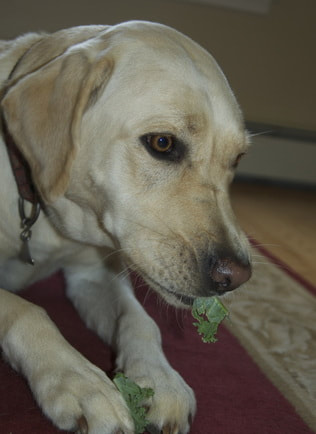
Kale is nutrient-rich, may help lower your cholesterol, protect you from cancer and contribute to your eye health. Madison doesn't let us have any unless we
share some with her.
Dr. Kathleen M. Zelman, MPH, RD, LD, in her WebMD Expert Column says: "One
cup of chopped kale contains 33 calories and 9% of the daily value of calcium, 206%
of vitamin A, 134% of vitamin C, and a whopping 684% of vitamin K. It is also a good
source of minerals copper, potassium, iron, manganese, and phosphorus."
(The Truth About Kale)
Alison Lewis in "Top Ten Health Benefits of Eating Kale" (Mind, Body, Green ) says that
it also ". . . is a great anti-inflammatory food" and has more calcium than milk per calorie.
Madison says, "It is GREAT!"
share some with her.
Dr. Kathleen M. Zelman, MPH, RD, LD, in her WebMD Expert Column says: "One
cup of chopped kale contains 33 calories and 9% of the daily value of calcium, 206%
of vitamin A, 134% of vitamin C, and a whopping 684% of vitamin K. It is also a good
source of minerals copper, potassium, iron, manganese, and phosphorus."
(The Truth About Kale)
Alison Lewis in "Top Ten Health Benefits of Eating Kale" (Mind, Body, Green ) says that
it also ". . . is a great anti-inflammatory food" and has more calcium than milk per calorie.
Madison says, "It is GREAT!"
* * * *
New Flowers Every Week
Each week new flowers are beginning to bloom. The recent rain in Boylston helped a lot.
Virgo Matricaria The first Dahlia of the season.
Guinevere Delphiniums
* * * *
The Plants Are Happily Growing!
We've reached the longest day of the year. Summer and zucchini squash are now focused on producing! The cucumbers in the cucumber house are on their way up to the peak. Three kinds of Matricaria are blooming at the same time.
* * * *
Shoots Are a Healthy Choice For Greens
What are shoots, and why would you want to eat them?
They are young seedlings of edible vegetables and herbs that are nutrient dense powerhouses. They are full of the vitamins, minerals, and antioxidants needed to support the growth of these plants.These wonderful greens are an excellent source of “super food” and protein. Both the leaves and the stems are edible.
A University of Maryland and USDA study confirmed, “The micro-greens were four to forty-fold more concentrated with nutrients like vitamins C, E, and K, lutein, and beta-carotene than their mature counterparts,” according to a University researcher. They contain nutrients that are important for eyes, skin, bones, healthy digestion, reducing inflammation, preventing cardiovascular disease, fighting cancer, and strengthening the immune system.
Julia M writes in Back to the Roots that they "are positively packed with vitamins". Martin's Gardens at Coleman Farm says they are ". . .nothing short of awesome in sandwiches, soups, salads, scrambled eggs, and wraps."
They are young seedlings of edible vegetables and herbs that are nutrient dense powerhouses. They are full of the vitamins, minerals, and antioxidants needed to support the growth of these plants.These wonderful greens are an excellent source of “super food” and protein. Both the leaves and the stems are edible.
A University of Maryland and USDA study confirmed, “The micro-greens were four to forty-fold more concentrated with nutrients like vitamins C, E, and K, lutein, and beta-carotene than their mature counterparts,” according to a University researcher. They contain nutrients that are important for eyes, skin, bones, healthy digestion, reducing inflammation, preventing cardiovascular disease, fighting cancer, and strengthening the immune system.
Julia M writes in Back to the Roots that they "are positively packed with vitamins". Martin's Gardens at Coleman Farm says they are ". . .nothing short of awesome in sandwiches, soups, salads, scrambled eggs, and wraps."
Pea shoots Sunflower shoots
Flavor: Some say they taste fresh ( just like peas) Flavor: They have a nutty taste
Nutrients: Vitamins A, B, C and E, calcium, chlorophyll, Nutrients: High in protein, zinc, omega fatty acids, B vitamins, folate,
iron, magnesium, niacin, phosphorus, potassium & amino acids and LIVING enzymes.
Pea shoots contain 20-25% protein. They are low in fat and calories.
We think they are delicious!
Flavor: Some say they taste fresh ( just like peas) Flavor: They have a nutty taste
Nutrients: Vitamins A, B, C and E, calcium, chlorophyll, Nutrients: High in protein, zinc, omega fatty acids, B vitamins, folate,
iron, magnesium, niacin, phosphorus, potassium & amino acids and LIVING enzymes.
Pea shoots contain 20-25% protein. They are low in fat and calories.
We think they are delicious!
* * * *
Hydroponics - An Indoor Hobby?
What a difference a few days can make. This cucumber has grown a lot between April 21st and April 25th. The vines have reached the ceiling and are happily blooming and producing cukes. However, they are not growing in soil. They are growing in a hydroponic solution (nutrients mixed into water). The vines are growing in front of a sliding glass door with additional lights mounted beside them on a 6-foot step ladder.
We have grown lettuce hydroponically for years, but this winter we decided to experiment with growing them in our house. Would it be possible to grow vegetables indoors- without using any soil?
First we planted lettuce and discovered that it is quite easy to grow in a hydroponic solution. A little over two months is about all you need to turn a lettuce seed into a beautiful, full head of lettuce.
Then we decided to try something a little more complicated. Could cucumbers be grown inside as well? We started them in oasis cubes. Once they germinated we moved the cubes to net cups that were set into holes in the top of a covered bin. The roots reached the water solution with space above for air circulation. The vines quickly climbed strings hung from the curtain rod above our sliding glass door. Blossoms and tiny cucumbers appeared.
For the slightly less adventurous - two heads of lettuce can be grown in a food-grade plastic shoe box.
First we planted lettuce and discovered that it is quite easy to grow in a hydroponic solution. A little over two months is about all you need to turn a lettuce seed into a beautiful, full head of lettuce.
Then we decided to try something a little more complicated. Could cucumbers be grown inside as well? We started them in oasis cubes. Once they germinated we moved the cubes to net cups that were set into holes in the top of a covered bin. The roots reached the water solution with space above for air circulation. The vines quickly climbed strings hung from the curtain rod above our sliding glass door. Blossoms and tiny cucumbers appeared.
For the slightly less adventurous - two heads of lettuce can be grown in a food-grade plastic shoe box.
* * * *
Camouflage
Did you ever wonder how critters like insects protect themselves? One of the ways is by using camouflage. Listen while Marissa reads a book on camouflage, and see if you can find the hidden creatures.Double click on this link: https://www.youtube.com/watch?v=0wVyX3pZE0A
April 21, 2020
April 21, 2020
* * * *
How Do Seeds Grow?
Special Gardening Activities While Staying-At-Home
For our younger gardeners: Did you ever wonder how plants "eat"? Where do they get the energy to grow? This is a white -board story explanation from "Kids Want To Know". https://www.youtube.com/watch?v=lGCZXx_Pczo
Experiment: Try planting a bean seed about 1 - 2 inches deep in soil in a pot in the house. See if by watering it and keeping it in the sun it will germinate so you can see its cotyledons.
Fiesti Kids presents Parts of a Plant: click here:
Try drawing or painting a picture that shows the six different parts of a plant. Draw a line or glue a piece of yarn or string onto your painting, once it is dry, to connect each plant part to the name of that part that you have printed around the edges of your picture.
Watch what happens when Peep plants a seed in Peep and the Big Wide World. https://www.youtube.com/watch?v=Yxs7P7LWzDg
Activity: Do you think you are patient enough to grow your own sunflower plant? Try planting a sunflower seed in a small pot. Water it and put it in a sunny window. Mark off the days on a calendar until it germinates. It should be warm enough to plant it outside by the middle of May. How tall will it get? How many days will it take to blossom?
We'd love to see pictures of your experiments and art work. Please send them to Woodlandridgefarm.com and let us know if we have your permission to post them on our website. Have fun exploring plants and happy growing! April 6, 2020
Experiment: Try planting a bean seed about 1 - 2 inches deep in soil in a pot in the house. See if by watering it and keeping it in the sun it will germinate so you can see its cotyledons.
Fiesti Kids presents Parts of a Plant: click here:
Try drawing or painting a picture that shows the six different parts of a plant. Draw a line or glue a piece of yarn or string onto your painting, once it is dry, to connect each plant part to the name of that part that you have printed around the edges of your picture.
Watch what happens when Peep plants a seed in Peep and the Big Wide World. https://www.youtube.com/watch?v=Yxs7P7LWzDg
Activity: Do you think you are patient enough to grow your own sunflower plant? Try planting a sunflower seed in a small pot. Water it and put it in a sunny window. Mark off the days on a calendar until it germinates. It should be warm enough to plant it outside by the middle of May. How tall will it get? How many days will it take to blossom?
We'd love to see pictures of your experiments and art work. Please send them to Woodlandridgefarm.com and let us know if we have your permission to post them on our website. Have fun exploring plants and happy growing! April 6, 2020
* * * *
What's A Vernal Pool?
If you live in Central Massachusetts, chances are that you live near a vernal pool. Yes, we have them in Boylston. What is a vernal pool? How can you tell if there is one near you? Late March into April is a good time to go exploring. Here are a few links to help you find out more about them:
https://blog.nwf.org/2014/03/big-night-teaching-kids-about-vernal-pools/
www.youtube.com/watch?v=zN8QN-g7kjY
pbskids.org/video/plum-landing/2365187356
www.vernalpools.me/portfolio-items/egg-mass-identification/
http://www.reptilesalive.com/fun-with-kids-nature-vernal-pools/
3/26/2020
https://blog.nwf.org/2014/03/big-night-teaching-kids-about-vernal-pools/
www.youtube.com/watch?v=zN8QN-g7kjY
pbskids.org/video/plum-landing/2365187356
www.vernalpools.me/portfolio-items/egg-mass-identification/
http://www.reptilesalive.com/fun-with-kids-nature-vernal-pools/
3/26/2020
* * * *
Happy Spring!
Spring is on its way even if we are having a snowstorm tonight!! March 23, 2020
* * * *
Small Parent - Large Baby??
As part of our sustainable, organic practices, we encourage birds to help us control our insect pests. During nesting season feeding can get very busy. Yesterday we noticed a typically chubby fledgling furiously flapping its wings with its mouth wide open. To our surprise an adult, barely half its size, flew over and placed a treat in the fledgling's mouth. This went on for quite a while. It appears that Momma cowbird has successfully coerced another family into foster parenting!!
August 2019
* * * *
Why Eat Blueberries?
|
According to Hrefna Palsdottir, MS - February 20, 2019 in Healthline, blueberries may decrease your risk of heart disease, boost brain health, lower blood sugar levels, and improve insulin sensitivity. What's in them that makes them so healthy?
Besides being a good source of manganese, vitamins C and K1; they are also "rich in antioxidants and beneficial plant compounds, including:
|
We think they are delicious and fun to eat! July 2019
* * * *
A Fragrance Like No Other!!
Sweet Peas Perfume the Breeze July 2019
* * * *
Tip For A Beautiful Walk (We May Have To Wait Until 2021 To See It Again!)
April 24, 2019
* * * *
Spring Has Arrived!
The ice has finally left the ponds and a few brave "singers" are attempting to stake claim to the title of ""most attractive vocalist". Double click on the link below to hear their music.
https://www.youtube.com/watch?v=MnGE4e_ZC7gwww.youtube.com/watch?v=MnGE4e_ZC7g
April 3, 2019
https://www.youtube.com/watch?v=MnGE4e_ZC7gwww.youtube.com/watch?v=MnGE4e_ZC7g
April 3, 2019
* * * *
Accessible Gardening For Everyone
Dr. Leonard Perry, Horticulture Professor at the University of Vermont cautions us to not "give up gardening if you have physical limitations, just change how you do it, and perhaps the tools you use and the space you garden." in his recent summer news article in the Green Mountain Gardener.
* * * *
Why Attract Birds To Your Garden And Keep Bees?
One of our goals is to create a healthy, sustainable growing environment. Encouraging birds to join us helps with pest management and provides beauty that we enjoy all year. Bees are key pollinators that use sophisticated teamwork.
August 5, 2018
August 5, 2018
* * * *
How To Handle Fresh Native Berries
Fresh, sun-ripened, berries are delicious and packed with healthful antioxidants. According to Franziska Spritzler, in her article 11 Reasons Why Berries Are Among the Healthiest Foods on Earth, they may help improve your blood sugar and insulin response, they are high in fiber, their antioxidants help fight inflammation and protect against cancer, they may help lower cholesterol levels, they may help keep your arteries healthy, they are nutrient rich and may be good for your skin.
Fresh, unsprayed berries may not last as long as store-bought berries and they need special handling. They should first be sorted to remove any berries with signs of mold or leakage. They then need to be chilled quickly and should not be stored wet.
Megan Gordon of the Kitchn recommends the following 5 tips to help your fresh berries last longer.
1. Timing is everything: Only rinse berries right before you use them. Water increases the liklihood they'll start to mold.
2. Don't soak: Place them in a colander and rinse water over them instead of fully submerging them.
3. Give them a quick chill: You know how sun-ripened, warm berries have that delightful soft messiness to them? Well, that is what makes them taste just like summer, but it's also what makes them incredibly delicate and difficult to wash. So a good tip is to refrigerate them for an hour or so when you bring them home from the market. They're easier to rinse when they've had a chance to firm up just a bit.
4. Storage is key: After washing berries, let them rest in a colander in the refrigerator and another vessel that has some air circulation. This will help them dry out more considerably than if just placed in a bowl.
5. Avoid the crisper: Many people believe that berries will go bad more quickly if kept in the crisper because the air has a higher humidity and doesn't circulate as much as throughout the rest of the refrigerator. In a very unscientific sampling, I find this to be true and follow this myself.
Anajali Prasertong of the KITCHN recommends a different approach. Check out her video by double clicking below and then single clicking on the link.
www.thekitchn.com/smart-tip-keep-berries-fresh-longer-with-this-washing-method-172141
Whatever techniques you find that work for you - they are worth it so that you can enjoy these gems of summer!!
July 17, 2018
Fresh, unsprayed berries may not last as long as store-bought berries and they need special handling. They should first be sorted to remove any berries with signs of mold or leakage. They then need to be chilled quickly and should not be stored wet.
Megan Gordon of the Kitchn recommends the following 5 tips to help your fresh berries last longer.
1. Timing is everything: Only rinse berries right before you use them. Water increases the liklihood they'll start to mold.
2. Don't soak: Place them in a colander and rinse water over them instead of fully submerging them.
3. Give them a quick chill: You know how sun-ripened, warm berries have that delightful soft messiness to them? Well, that is what makes them taste just like summer, but it's also what makes them incredibly delicate and difficult to wash. So a good tip is to refrigerate them for an hour or so when you bring them home from the market. They're easier to rinse when they've had a chance to firm up just a bit.
4. Storage is key: After washing berries, let them rest in a colander in the refrigerator and another vessel that has some air circulation. This will help them dry out more considerably than if just placed in a bowl.
5. Avoid the crisper: Many people believe that berries will go bad more quickly if kept in the crisper because the air has a higher humidity and doesn't circulate as much as throughout the rest of the refrigerator. In a very unscientific sampling, I find this to be true and follow this myself.
Anajali Prasertong of the KITCHN recommends a different approach. Check out her video by double clicking below and then single clicking on the link.
www.thekitchn.com/smart-tip-keep-berries-fresh-longer-with-this-washing-method-172141
Whatever techniques you find that work for you - they are worth it so that you can enjoy these gems of summer!!
July 17, 2018
* * * *
Vitamin-Rich Foods To Boost Your Health
|
Sylvie Tremblay of Healthy Eating shares that while Snap Peas are low in calories (41 calories per cup), they have lots of nutritional value - including
IRON that "helps you produce energy, activates enzymes your immune system needs to fight off infections, and nourishes your red blood cells to fight energy-zapping anemia." VITAMIN C "known for its antioxidant benefits, which helps reverse and prevent cell damage caused by toxins called free radicals. It's also important for making collagen, which means the vitamin C in sugar snap peas also benefits your skin, bones, cartilage and hair. VITAMIN A to support your vision, immune system and healthy cell development. Swiss Chard is an excellent source of vitamins K, A, and C, as well as a good source of magnesium,potassium, iron, and dietary fiber Kale is the "vitamin king". According to the Web MD at just 33 calories, one cup of raw kale has:
|
June 12, 2018
* * * *
Nutritious And Delicious!
* * * *
All The Fruit Trees Have Caught Up
Despite erratic spring weather slowing down some of our trees - our apricot, peach, cherry and apple trees have all managed to bloom. May 8, 2018
* * * *
Spring Has Sprung!
What a little sun will do!
April 29, 2018
* * * *
Happy Spring!
March 21, 2018
* * * *
Raised Bed Gardening
Why garden in a raised bed? There are many reasons that make them an excellent place to grow vegetables, herbs and flowers. Here's an excerpt from Eartheasy - Solutions For Sustainable Living that list some of the benefits of raised bed gardening. "Raised garden beds, also called garden boxes, are great for growing small plots of veggies and flowers. They keep pathway weeds from your garden soil, prevent soil compaction, provide good drainage and serve as a barrier to pests such as slugs and snails. The sides of the beds keep your valuable garden soil from being eroded or washed away during heavy rains. In many regions, gardeners are able to plant earlier in the season because the soil is warmer and better drained when it is above ground level. "
Raised beds can help people with back or knee problems be able to garden. The ground is not as "far away" in a raised bed, and depending on the design, the bed can be a convenient height for sitting on the edge or small seats in the corners.
Raised beds are often open on the bottom so the plants can grow deep roots. However, they can be installed on top of tar or concrete. They can be bought in a variety of different materials, but are easily constructed.
Below are links to some resources to help you see if this approach is right for you and to get you started.
www.vegetable-gardening-online.com/raised-bed-vegetable-garden.html
Rodale's Organic Life video:
www.rodalesorganiclife.com/garden/how-to-build-a-simple-raised-bed
Seeds of Solidarity offers the following information:
seedsofsolidarity.files.wordpress.com/2014/11/creating-raised-bed-gardens.pdf
Have fun - it's a great way to try out gardening! Feel free to contact us with any questions, and we will try to help.
March 18, 2018
* * * *
How Many Days Until Spring?
Not to worry. Things are growing despite the snow! March 14, 2018
* * * *
In Memory Of Two Of My Favorite Gardening Inspirations
Feb 27, 2018
* * * *
Kids' Corner
Join a sing-along on HIBERNATION!
www.youtube.com/watch?v=BstmnCYwAE8
www.youtube.com/watch?v=BstmnCYwAE8
Watch a book being read - Why Do Animals Hibernate? by David Martin.
www.youtube.com/watch?v=AHclJXhj6DQ
www.youtube.com/watch?v=AHclJXhj6DQ
Here's a science video on getting ready for hibernation. Enjoy!
www.youtube.comwatch?v=OhrhcsICrE8 January 30, 2018
www.youtube.comwatch?v=OhrhcsICrE8 January 30, 2018
Blizzard of 2018!
* * * *
Our Fall Crops Are Busy Growing
Schools are opening and the evenings are cooler. Fall crops are quietly growing.
Waltham butternut squash takes 105 days to arrive at your table.
Acorn squash needs 75 days.
Swiss chard, scallions and tomatillos will continue well into fall. August 29, 2017
* * * *
Peak of the Harvest
Now is the time to enjoy all the wonderful flavors of produce grown within a few miles of your table. Experiment with a vegetable or herb that you've never tasted or "revisit" one you think you don't like. Be amazed at the difference between canned and really fresh beans or beets. There's a lot of exciting eating and power-packed nutrition between now and when the snow flies!
August 13, 2017
* * * *
A Good Time To Make Pickles!
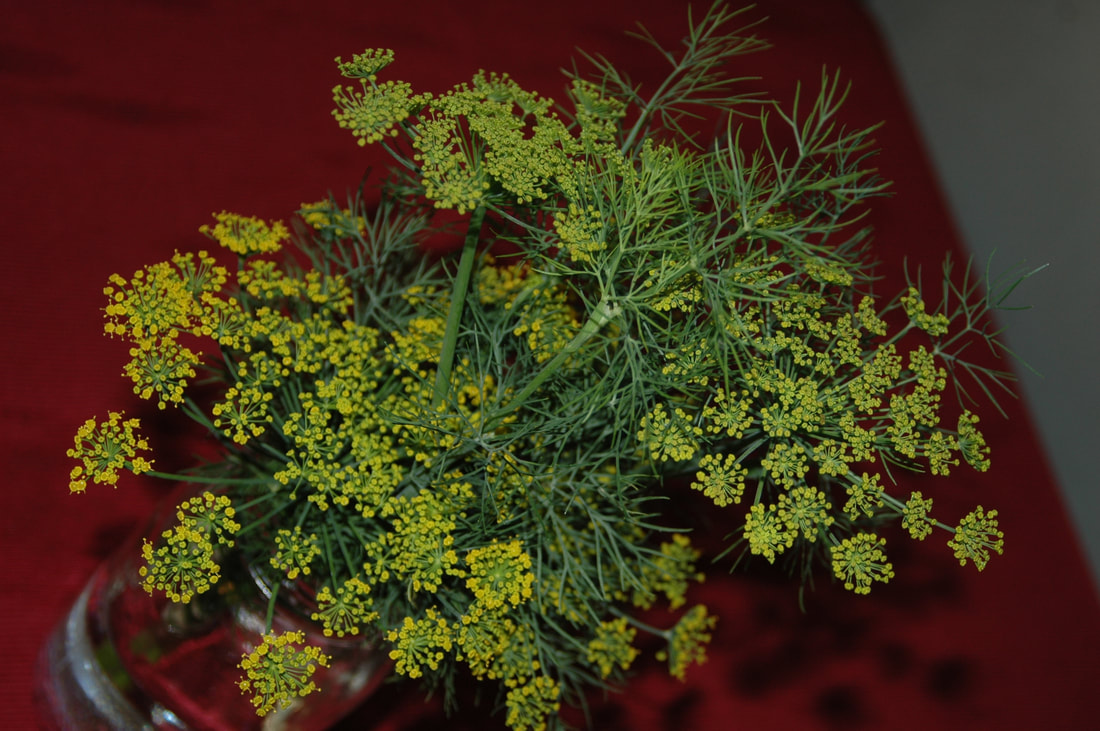
It is a good time to make dill pickles. Fresh dill is ready and pickling cukes are producing well. Freezer pickles are a good option if it's too hot for you to can. Enjoy - it's August! Aug. 5, 2017
* * * *
Bees Are Hard At Work!
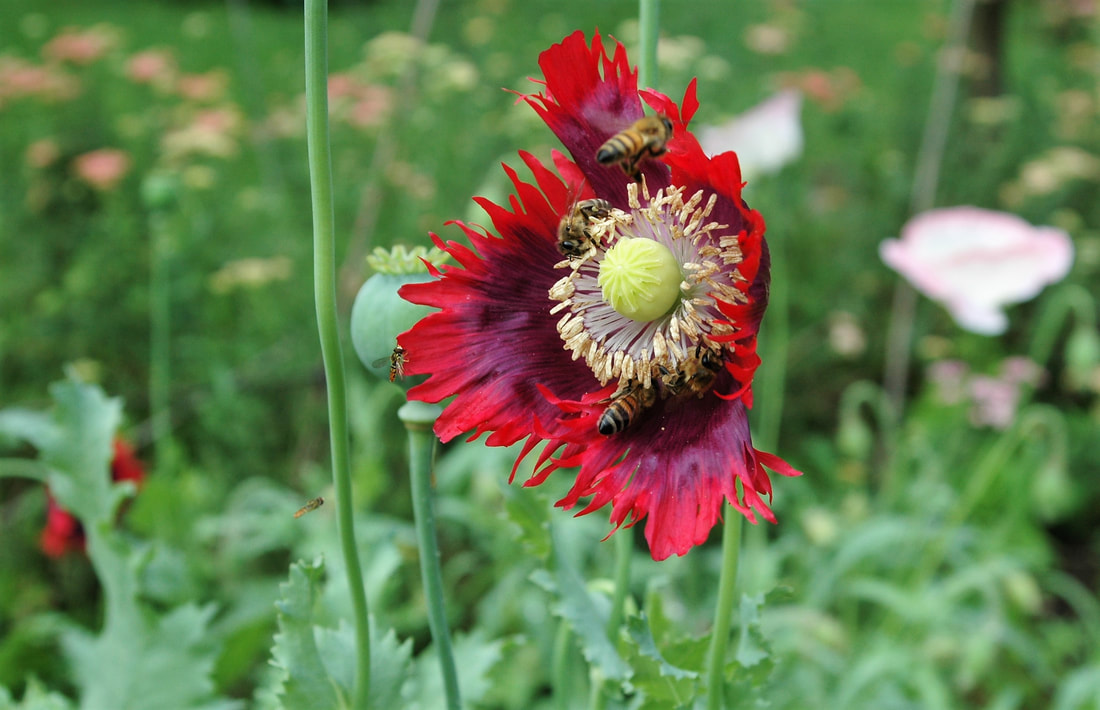
Our bees are enjoying the flowers. Some flowers cause lots of excitement. Poppies are definitely on the list of favorites!
7/10/17
7/10/17
* * * *
Add Flavor, Texture, Aroma and Loads of Nutrients To Your Meals!!
Add flavor, texture, aroma and a powerhouse of vitamins and minerals to your salads, wraps, sandwiches, omelettes and more with pea and sunflower shoots. Come pick some up this Friday from 3:00 - 6:00 at the Westminster Farmers' Market. June 30, 2017
* * * *
Plants Welcome The Warm Weather & Sunshine!
* * * *
Raised Beds Can Bring Gardening To Your Door
If you find it difficult to walk all the way out to the garden, bend down to plant or harvest, or prepare your garden for planting due to a temporary or permanent physical challenge - Madison recommends trying a raised bed.
|
You can have one built as high as you need, to make it easy to reach, or you can purchase one that has been professionally made. Check out some options for building your own by looking at these videos at: www.youtube.com/watch?v=hFGE3plxSSE and www.youtube.com/watch?v=0-d8WcogQ70 HAPPY GARDENING! June 5, 2017 |
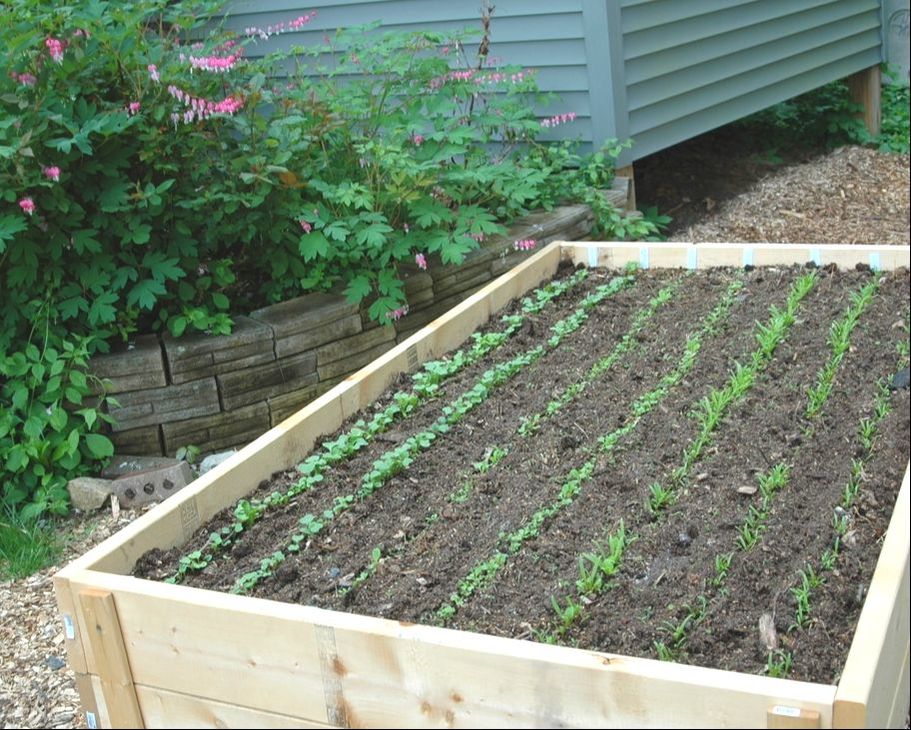
|
* * * *
Cool Weather Crops Enjoyed May's Crisp Weather
* * * *
Benefits of Eating Pea and Sunflower Shoots
How healthy are pea and sunflower shoots? Do they have any special health benefits?
HealthDiaries.com. states that pea shoots provide “exceptional nutritional value”. They list six of their health benefits as:
1. Cancer prevention - great source of three chemoprotective agents: folate, antioxidants and carotene
2. High in antioxidants - One cup of pea shoots provides about 35% of the daily value of vitamin C, 15% of vitamin A and 66%of vitamin K.
3. Anti-inflammatory dense - with the needed antioxidants and phytonutrients
4. Supportive of people with Diabetes - by helping keep blood sugar levels low, providing essential antioxidant support
5. Heart health “ the support these leaf greens provide the inflammation system and immune system of the body, as well as the high levels of antioxidants and phytonutrients they offer indicate that pea shoots may lend a wide range of cardiovascular benefits."
6. Weight loss ” Pea shoots have an outstanding nutrient to calorie ratio and offer a good amount of dietary fiber, which helps control body weight and regulate the metabolism. “
Christina Sarich writes for Natural Society. In her article 11 Reasons To Grow and Eat Sunflower Greens
Give them a try. They are both nutritious and delicious! See us in Westminster on Fridays to check out our shoot recipe book and pick up a recipe or two.
May 19, 2017
HealthDiaries.com. states that pea shoots provide “exceptional nutritional value”. They list six of their health benefits as:
1. Cancer prevention - great source of three chemoprotective agents: folate, antioxidants and carotene
2. High in antioxidants - One cup of pea shoots provides about 35% of the daily value of vitamin C, 15% of vitamin A and 66%of vitamin K.
3. Anti-inflammatory dense - with the needed antioxidants and phytonutrients
4. Supportive of people with Diabetes - by helping keep blood sugar levels low, providing essential antioxidant support
5. Heart health “ the support these leaf greens provide the inflammation system and immune system of the body, as well as the high levels of antioxidants and phytonutrients they offer indicate that pea shoots may lend a wide range of cardiovascular benefits."
6. Weight loss ” Pea shoots have an outstanding nutrient to calorie ratio and offer a good amount of dietary fiber, which helps control body weight and regulate the metabolism. “
Christina Sarich writes for Natural Society. In her article 11 Reasons To Grow and Eat Sunflower Greens
- 1. Sunflower shoots are “ . . .one of the most balanced forms of a complete plant protein.”
- 2. “Sprouted sunflower greens . . . contain up to 100 times the enzymes of regular, full-grown greens. This means your body can more easily assimilate important phytonutrients, vitamins and minerals.”
- 3. Sunflower greens are full of folate (folic acid), and B complex, vital nutrients for pregnant women and a developing baby..
- 4. High levels of antioxidants in sunflower greens can aid in heart health, slow aging, and support cellular recovery. High levels of vitamins C, E, and selenium can even reduce high blood pressure and improve arterial health.
- 5. Sunflower greens are packed with nutrition and have very low calories, so they are a perfect food for those who want to lose weight.
- 6. Sunflower greens contain lecithin which help to break down fatty acids in the body.
- 7. They also contain vitamins A, D, and E and important minerals including calcium, copper, iron, phosphorous, magnesium and potassium.
- 8. Eating sunflower seeds or greens helps boost your reproductive health by providing the body with ample zinc.
- 9. Sunflower greens are incredible for boosting immunity.
- 10. Sunflower sprouts are full of essential fatty acids.
- 11, All sprouts, including sunflower sprouts are full of chlorophyll. which helps keep our blood healthy, reduce inflammation, calm the nervous system, revitalize tissues, and balance pH levels in the body.
Give them a try. They are both nutritious and delicious! See us in Westminster on Fridays to check out our shoot recipe book and pick up a recipe or two.
May 19, 2017
* * * *
Spring Crops Are Busy Growing
Peas Beets
* * * *
Gardening - For Stress Reduction
As we sit inside - staring out at the results of our most recent "blizzard", many of us think longingly of the warm spring days when we can begin planting flowers and vegetables. Is there a reason why so many people enjoy gardening - even after putting in a hard day at work? Besides the obvious benefits of picking fresh produce and seeing beautiful flowers right outside your door, many people find gardening a tremendous stress reducer.
Dr. Mercola, in his article, A Simple Way to Reduce Stress, recommends gardening for its many benefits - including stress reduction. To see more of his article see the link here: articles.mercola.com/sites/articles/archive/2016/04/21/gardening-helps-relieve-stress.aspx
Besides restoring positive mood, Dr. Mercola also feels that gardening helps those with attention overload. The benefits of our marvelous technology come at a price - attention fatigue. Try resting in this garden: youtu.be/EqioPRY1C-Q or this one www.youtube.com/watch?v=TuoBdLn6JtM Meagan Francis mentions the additional benefits of decreasing depression and calorie burning: www.hgtv.com/outdoors/gardens/get-growing-and-get-happy
Can this be enjoyed by those dealing with physical challenges? Read this article by Larson, Hancheck and Vollmar to see some of the considerations that need to be made when setting up an accessible garden. www.extension.umn.edu/garden/yard-garden/landscaping/accessible-gardening-for-therapeutic-horticulture/
Dr. Mercola, in his article, A Simple Way to Reduce Stress, recommends gardening for its many benefits - including stress reduction. To see more of his article see the link here: articles.mercola.com/sites/articles/archive/2016/04/21/gardening-helps-relieve-stress.aspx
Besides restoring positive mood, Dr. Mercola also feels that gardening helps those with attention overload. The benefits of our marvelous technology come at a price - attention fatigue. Try resting in this garden: youtu.be/EqioPRY1C-Q or this one www.youtube.com/watch?v=TuoBdLn6JtM Meagan Francis mentions the additional benefits of decreasing depression and calorie burning: www.hgtv.com/outdoors/gardens/get-growing-and-get-happy
Can this be enjoyed by those dealing with physical challenges? Read this article by Larson, Hancheck and Vollmar to see some of the considerations that need to be made when setting up an accessible garden. www.extension.umn.edu/garden/yard-garden/landscaping/accessible-gardening-for-therapeutic-horticulture/
A Slate Colored Junco Hunkered Down in An Apricot Tree A Monarch Preparing For Migration By Visiting Our Zinnias March 15 & 19, 2017
* * * *
Planning Your Garden
It's that time of year again when avid gardeners spread all the seed catalogs on the table, pull out graph paper and begin to plan for the new year's garden. We enjoy comparing what the many different companies provide to support those of us who love to grow plants. This year we are nominating our favorites in several areas and invite you to join the discussion by contacting us via our "Contact" tab above.
Best art work: FEDCO, John Scheepers Kitchen Garden Seeds, and R. H. Shumway's.
Best photography: Harris & Burpee
Most economical for trying a wide variety of new seeds & ability to purchase a small quantity of seeds: Pinetree
Speed of Shipping: Johnny's Selected Seeds
Most Cultural Information: Johnny's Selected Seeds & Stokes Seeds
Best Source of Heirloom Seeds: Baker Creek Heirloom Seeds
Best Source of Organic, non-GMO seeds: High Mowing Organic Seeds
Widest Variety of Herbs: Richters
Please share your favorites with us. We'd love to hear from you! February 16, 2017
Best art work: FEDCO, John Scheepers Kitchen Garden Seeds, and R. H. Shumway's.
Best photography: Harris & Burpee
Most economical for trying a wide variety of new seeds & ability to purchase a small quantity of seeds: Pinetree
Speed of Shipping: Johnny's Selected Seeds
Most Cultural Information: Johnny's Selected Seeds & Stokes Seeds
Best Source of Heirloom Seeds: Baker Creek Heirloom Seeds
Best Source of Organic, non-GMO seeds: High Mowing Organic Seeds
Widest Variety of Herbs: Richters
Please share your favorites with us. We'd love to hear from you! February 16, 2017
* * * *
Winter Challenges - Part II - Birds
As we run to the store to stock up for a winter storm, what do our friends the birds do to prepare? We can build a fire in the fire place, put on an extra layer of clothing or just turn up the thermostat on a cold night. Can you imagine spending the night in a tree in your yard? Many birds do migrate to warmer places, but what about those that choose to stay here all winter?
Birds have many built-in features that help them through those cold days and nights. They have a down undercoat that can be fluffed up as the temperature drops. When preening, they distribute oil to keep their feathers water-proof. Their feet are covered with scales and are mostly composed of bone and tendons. When the temperature really drops, they squat down and cover their feet with their down, and often alternate standing on one foot and then the other while warming the drawn-up one close to their bodies. Just as our friends, the bees, shiver to generate heat; Greg Laden states in his blog, that birds shiver to ,"get added heat from circulation and muscle movement." Some kinds of birds have a unique circulatory exchange system that allows warmer blood from their core to circulate through their exposed feet.
Birds also adopt protective behaviors in the winter. They save energy by minimizing singing and not reproducing. They move around to adjust their perch into the most sheltered side of trees and bushes, and attempt to sit in the sun when possible. Some, like chickadees, huddle together in groups. Danish Scientist, Olav Hogstad, from the Norwegian University of Science and Technology, writes in Science Daily, that they have to build up their fat reserves to carry them through each night. He also states that they try to stay in the upper branches and gather into flocks to protect themselves from predators.
Click on the blue link below to see a video that shares some of these ideas - and makes us be more appreciative of the warm comforter that we can snuggle up under tonight!!! youtu.be/wUohmDU_tLI February 8, 2017
* * * *
* * * *
Many Grasses Are Beautiful!
* * * *
Summer Growing Project For Kids
This is the time of year when we see beautiful avocados in the store. They taste good and are healthy for you.
Have you ever wondered what kind of plant they grow on? It is easy to find out. You can grow one on your windowsill. All you need is a glass of water and 3 toothpicks to get started.
Check this link for complete instructions.
lancaster.unl.edu/hort/youth/avocado.shtml August 18, 2016
Have you ever wondered what kind of plant they grow on? It is easy to find out. You can grow one on your windowsill. All you need is a glass of water and 3 toothpicks to get started.
Check this link for complete instructions.
lancaster.unl.edu/hort/youth/avocado.shtml August 18, 2016
* * * *
The Challenge Is On!
Some of you who have been following us for a while may remember that we grew cucumbers in a self-watering container last year - 50 of them! That's not bad production from one container. This year we decided to dedicate four containers to cucumbers. The count so far is 271!
You don't have to walk way out to the "garden" to grow food! Share your container gardening successes with us on our "Contact Us" form. (Hover over "More" above.) August 11, 2016
You don't have to walk way out to the "garden" to grow food! Share your container gardening successes with us on our "Contact Us" form. (Hover over "More" above.) August 11, 2016
* * * *
* * * *
A Chicken Picnic?
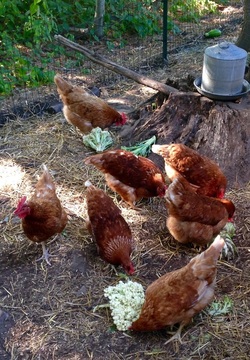
Who knew that cauliflower and broccoli would cause such excitement!
July 26, 2016
July 26, 2016
* * * *
How To Get Peanut Butter Off The Roof Of Your Mouth
Have you heard the old joke about the three ways to get peanut butter off the roof of your mouth? This rose-breasted grosbeak fledgling needs to hear it for some suggestions on how to get suet off your beak.
* * * *
Are Carrots Really a Healthy Food?
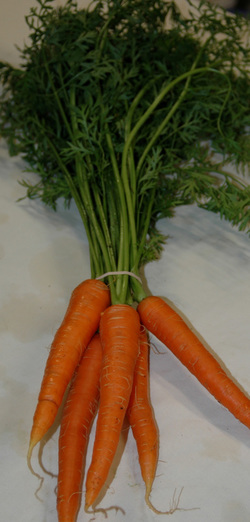
Our first carrots of the season are ready, so we thought we would explore the possible health benefits of including them in your menu.
According the Cancer Project (www.CancerProject.org) carrots contain beta-carotene: which supports the immune system and acts as a powerful antioxidant. Brenda Davis, RD and Vesanto Melina, MS, RD, in their book Becoming Raw - The Essential Guide to Raw Vegan Diets, have listed the following vitamins as occurring in 1 cup of chopped raw carrot:
A, RAE - 771 mcg
C - 8 mg
E - 0.8 mg
K - 17 mcg
Thiamine - 0.08 mg
Riboflavin - 0.07 mg
Niacin - 1.5 mg
B6 - 0.18 mg
Folate - 24 mcg
Pantothenic Acid 0.3 mg
Biotin - 6 mcg
Margaret Boyle sums up their benefits by saying they give you "more than a day's worth of Vitamin A", provide fiber, are low in calories and "carry a low glycemic load", contain several carotenoids that "may protect eye and cardiovascular health and reduce the risk of certain cancers", may reduce tumor activity and are a great "wash, grab, and go" snack! (Carrots: Health Benefits, the Old Farmers' Almanac Website)
ENJOY!! July 13, 2016
- * * * *
Flower Shares Have Begun
* * * *
Grosbeaks Enjoy Lunch
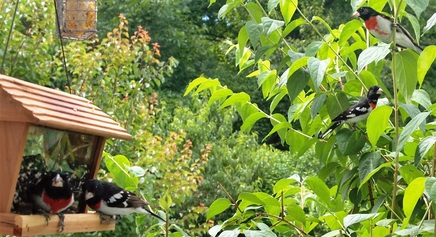
Four grosbeaks share lunch at our feeder.
July 4, 2016
July 4, 2016
* * * *
Spring Fragrance
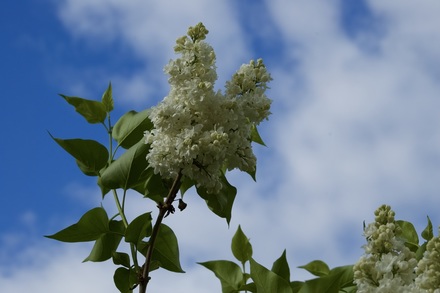
There's nothing quite like white lilacs in spring! How many flowers could you identify with your eyes shut?
May 22, 2016
May 22, 2016
* * * *
Double Vision
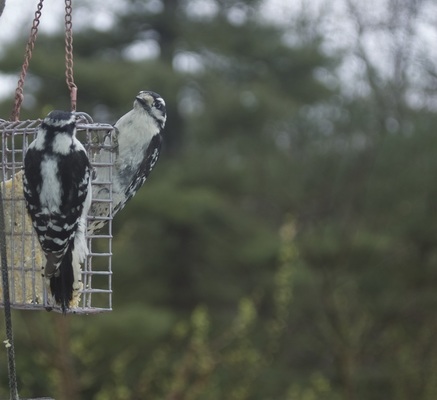
No, you are not seeing double. These two were both eating at the same time until they both stopped and touched beaks.
May 18, 2016
May 18, 2016
* * * *
The Newest Member of Our Insect Eating Team
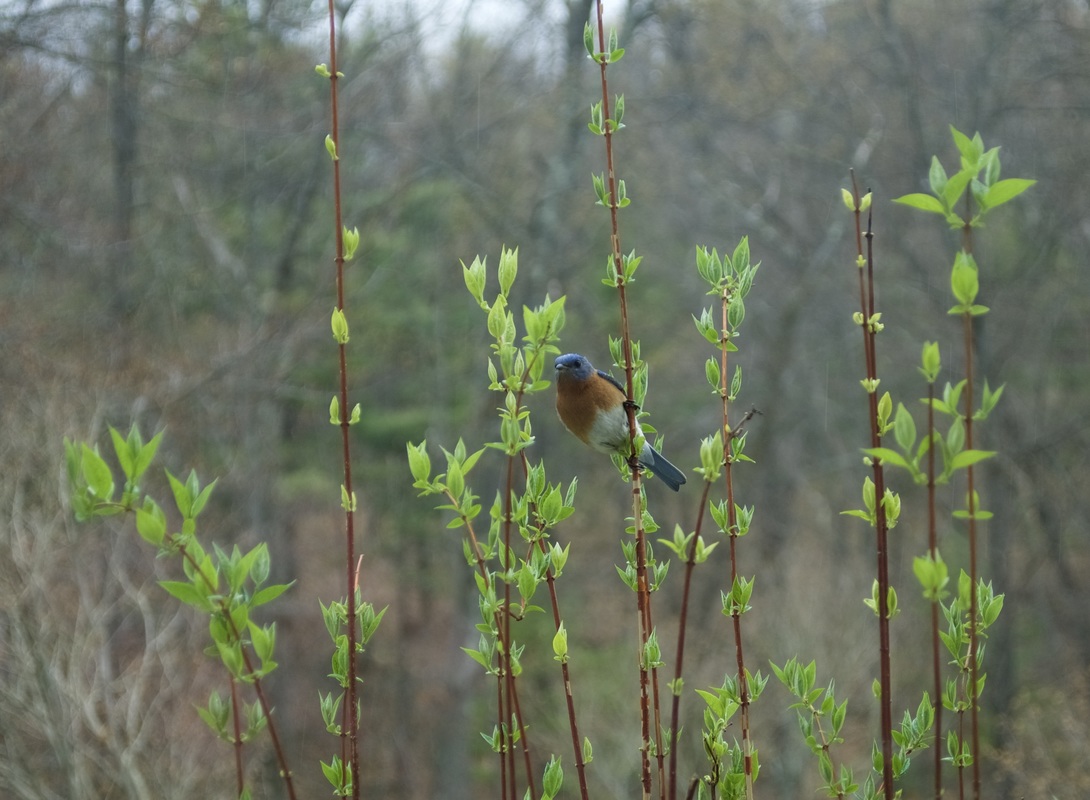
We are thrilled this spring to welcome bluebirds to our property. Because we prefer organic growing practices, we do not spray chemical insecticides on our plants. We encourage a variety of birds that find would-be garden pests quite delicious. Kathy LaLiberte, in her article How To Attract Bug-Eating Birds written for the Gardener's Supply Company, has created the following list of birds worth inviting to your yard:
May 2, 2016
- Bluebirds: grasshoppers, crickets, beetles, larvae, moths
- Cardinals: beetles, grasshoppers, leafhoppers, stinkbugs, snails
- Chickadees: aphids, whitefly, scale, caterpillars, ants, earwigs
- Grosbeaks: larvae, caterpillars, beetles
- Nuthatches: tree and shrub insects such as borers, caterpillars, ants and earwigs
- Orioles: caterpillars, larvae, beetles, grasshoppers
- Sparrows: beetles, caterpillars, cutworms
- Swallows: moths, beetles, grasshoppers
- Titmice: aphids, leafhoppers, caterpillars, beetles
- Warblers: caterpillars, aphids, whitefly
- Woodpeckers: larvae, beetles, weevils, borers
May 2, 2016
* * * *
* * * *
How To Raise A Crop of "Purpose" in Your Garden
What do a free farmer's market and harvesting "purpose" have to do with a nursing home? Many of us will find ourselves facing a period in life when we are always receiving. That's not so bad if you can also do your share of giving. The staff at this nursing home thought about this dilemma and listened to the plea of one of the residents to start a farm so she could continue to go outside and do what she loves. See the amazing transformation that this farm has facilitated for its residents. Many have found a reason to get out of bed and get dressed every morning. Many have reconnected with gardening in their past. All seem to appreciate sharing the produce they have planted, cared for and harvested with others in need - living on a fixed income. Feel free to contact us if you would like more information about horticultural therapy. Enjoy watching the transformation that regaining a purpose in their lives has made: https://www.youtube.com/watch?v=EMLAMajt0Rk Click here for an additional view of what is happening at Arroyo Grande Farm:
April 9, 2016
April 9, 2016
* * * *
Container Gardening
Gardening in containers can range from growing a few herbs for use in your culinary delights to an art form. Here is a short video to help you explore some of the possibilities. https://www.youtube.com/watch?v=KZvaDcSHHgk
The EarthBOX is a handy way to begin because you can buy a kit with everything you need. Earthboxes are self-watering so you don't have to be as vigilant about watering every day. Here are a few videos that they have posted on their website to show you how to get started. https://earthbox.com/videos
Watch an antique dough bowl be turned into a succulent planter here: https://www.youtube.com/watch?v=BbU5cMZoECM
Explore and get inspired. Grow bamboo on your deck or a succulent garden on your table. . .
March 16, 2016
The EarthBOX is a handy way to begin because you can buy a kit with everything you need. Earthboxes are self-watering so you don't have to be as vigilant about watering every day. Here are a few videos that they have posted on their website to show you how to get started. https://earthbox.com/videos
Watch an antique dough bowl be turned into a succulent planter here: https://www.youtube.com/watch?v=BbU5cMZoECM
Explore and get inspired. Grow bamboo on your deck or a succulent garden on your table. . .
March 16, 2016
* * * *
"My Gardening Days Are Over"
Spring is on it's way. Many people are busy ordering seeds and creating garden layout plans. However, every spring some people feel that gardening may no longer be an option. Possibly arthritis has crept in with increased pain and limited mobility; vision has decreased, they are recovering from surgery, or they've been in a serious car accident and now find themselves using a walker or wheelchair.
Madison feels that gardening is for everyone. The challenge is to match the required skills to our current skill set. Gardening can be defined in many different ways. I maintain that if you are in contact with earth / soil and living plants in a way that nurtures and helps those plants grow or nurtures and helps you grow - you are gardening. It is even better if it does both at the same time!
If you find yourself thinking that your gardening days are over, you may be able to have changes made to your current garden that make it possible for you to still enjoy working in it in a safe and productive way. However, if it isn't possible for you to get to the garden, the garden can be brought to you.
Joyce Schillen gives some general guidelines about creating an "Enabled Garden" In Garden Forever: http://www.gardenforever.com/pages/artenabled.htm
We will be posting a series of articles over the next month that will hopefully give you ideas about how to keep your hands (or a friend's hands) in the dirt!
March 7, 2016
Madison feels that gardening is for everyone. The challenge is to match the required skills to our current skill set. Gardening can be defined in many different ways. I maintain that if you are in contact with earth / soil and living plants in a way that nurtures and helps those plants grow or nurtures and helps you grow - you are gardening. It is even better if it does both at the same time!
If you find yourself thinking that your gardening days are over, you may be able to have changes made to your current garden that make it possible for you to still enjoy working in it in a safe and productive way. However, if it isn't possible for you to get to the garden, the garden can be brought to you.
Joyce Schillen gives some general guidelines about creating an "Enabled Garden" In Garden Forever: http://www.gardenforever.com/pages/artenabled.htm
We will be posting a series of articles over the next month that will hopefully give you ideas about how to keep your hands (or a friend's hands) in the dirt!
March 7, 2016
* * * *
Stay Active - Stay Healthy

Madison recommends staying active - as a key to staying healthy. The Mayo Clinic agrees: "Want to feel better, have more energy and perhaps even live longer? Look no further than exercise. The health benefits of regular exercise and physical activity are hard to ignore." Check out their list of 7 benefits of exercising regularly here: http://www.mayoclinic.org/healthy-lifestyle/fitness/in-depth/exercise/art-20048389
January 16, 2016
January 16, 2016
* * * *
December Harvest???
Tell us what you are picking. . . December 14, 2015
* * * *
It's Important To Have Friends!

Don't get too busy to spend time with friends!
December 11, 2015
December 11, 2015
* * * *
Why Do Monarchs Only Lay Eggs On Milkweed?
Watch this short video to find out why. http://education.jlab.org/frost/monarch.html November 29 2015
Watch this short video to find out why. http://education.jlab.org/frost/monarch.html November 29 2015
* * * *
Happy Thanksgiving!!
Wishing you and your family blessings of this Thanksgiving season!
* * * *
Motivation For Proper Dahlia Storage
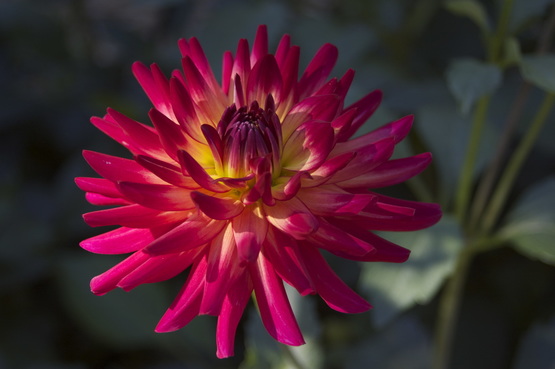
The promise of next year's blooms makes all the storage efforts worthwhile!
October 27, 2015
* * * *
Cucumber Production In a Self-Watering Container
Trouble walking out to the garden? Only a balcony/deck for all your crops? Problems hauling the hose / carrying a watering can? Trying a self-watering container may have crossed your mind, but you can't really grow much in such a small space - can you? The final tally is in. The box of cucumbers pictured below (on August 18th) has finished growing for the season. How many cucumbers would you guess were produced?
The total harvest was 54 cucumbers! Not bad for a rolling box that you can place right outside your door. . .
The total harvest was 54 cucumbers! Not bad for a rolling box that you can place right outside your door. . .
* * * *
Monarch Sightings in Holden and Boylston!
We are thrilled that a monarch was seen nectaring on ageratum in Boylston on two different days and one was also spotted in Holden. Has anyone else seen one?
Email us at Woodlandridgefarm.com or click on the "Contact Us" tab under "More" above and tell us where you were lucky enough to see one. Please share the good news! September 29, 2015
We are thrilled that a monarch was seen nectaring on ageratum in Boylston on two different days and one was also spotted in Holden. Has anyone else seen one?
Email us at Woodlandridgefarm.com or click on the "Contact Us" tab under "More" above and tell us where you were lucky enough to see one. Please share the good news! September 29, 2015
* * * *
Fall Crops Have Rebounded From Hot - Dry Weather
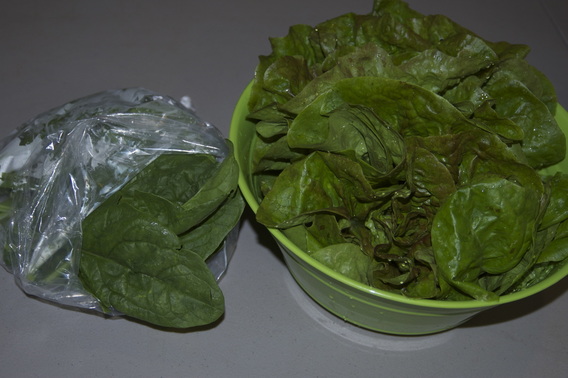
Broccoli, cabbage, spinach, kale, Choi, Swiss chard, brussel sprouts, etc. have begun flourishing after the challenges of heat and dry weather! We are looking forward to bringing them to market this fall!
September 23, 2015
* * * *
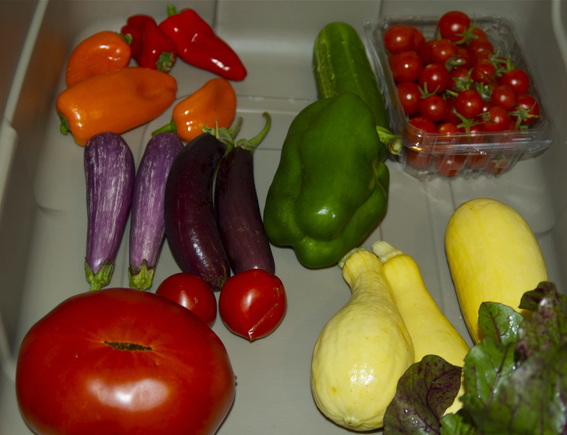
Eat The Rainbow
"The more naturally colorful your meal is, the more likely it is to have an abundance of cancer-fighting nutrients. Pigments that give fruits and vegetables their bright colors represent a variety of protective compounds." Examples Include:
RED Tomatoes - lycopene an antioxidant - cuts prostate cancer risk
Tips From The Cancer Project - www.CancerProject.org
ORANGE Peppers - vitamin A - beta carotene - helps to maintain healthy teeth, skin, bones and eye health; promotes reproduction; and aids in reducing the risk of certain types of cancer - supports immune system
Vitamin C - ascorbic acid, promotes growth and repair of body tissues and may reverse the development of chronic health conditions like cancer, heart disease and arthritis. - Nutrition of Orange Bell Peppers by Kathryn Vera - Livestrong.com
September 13, 2015
PURPLE Eggplant – Expert Free-Radical Scavengers - "Polyphenols in eggplant have been found to exhibit anti-cancer effects. Anthocyanins and chlorogenic acid function as antioxidants and anti-inflammatory compounds. They protect body cells from damage caused by free radicals and in turn prevent tumor growth and invasion and spread of cancer cells. They also stimulate detoxifying enzymes within cells and promote cancer cell death."
Megan Ware RDN LD – Medical News Today
September 14, 2015
YELLOW Summer Squash - Yellow squash serves as a good source of vitamin C . . . an antioxidant that blocks cellular damage from free radicals, helping to slow aging and possibly decreasing your risk of heart disease, arthritis and cancer; folate, also called folic acid, which is a B-vitamin. Not getting enough folate in your diet can result in a form of anemia. However, this vitamin is best known for its role in preventing birth defects; beta carotene - helps ward off certain cancers, as well as heart disease and vision degeneration associated with aging.
Mineral manganese, an essential trace mineral required to manufacture sex hormones, bones and connective tissues.& maintains the normal function of your brain and nerves. The Nutritional Value of Yellow Squash, Livestrong.com By Nicki Wolf September 15, 2015
"The more naturally colorful your meal is, the more likely it is to have an abundance of cancer-fighting nutrients. Pigments that give fruits and vegetables their bright colors represent a variety of protective compounds." Examples Include:
RED Tomatoes - lycopene an antioxidant - cuts prostate cancer risk
Tips From The Cancer Project - www.CancerProject.org
ORANGE Peppers - vitamin A - beta carotene - helps to maintain healthy teeth, skin, bones and eye health; promotes reproduction; and aids in reducing the risk of certain types of cancer - supports immune system
Vitamin C - ascorbic acid, promotes growth and repair of body tissues and may reverse the development of chronic health conditions like cancer, heart disease and arthritis. - Nutrition of Orange Bell Peppers by Kathryn Vera - Livestrong.com
September 13, 2015
PURPLE Eggplant – Expert Free-Radical Scavengers - "Polyphenols in eggplant have been found to exhibit anti-cancer effects. Anthocyanins and chlorogenic acid function as antioxidants and anti-inflammatory compounds. They protect body cells from damage caused by free radicals and in turn prevent tumor growth and invasion and spread of cancer cells. They also stimulate detoxifying enzymes within cells and promote cancer cell death."
Megan Ware RDN LD – Medical News Today
September 14, 2015
YELLOW Summer Squash - Yellow squash serves as a good source of vitamin C . . . an antioxidant that blocks cellular damage from free radicals, helping to slow aging and possibly decreasing your risk of heart disease, arthritis and cancer; folate, also called folic acid, which is a B-vitamin. Not getting enough folate in your diet can result in a form of anemia. However, this vitamin is best known for its role in preventing birth defects; beta carotene - helps ward off certain cancers, as well as heart disease and vision degeneration associated with aging.
Mineral manganese, an essential trace mineral required to manufacture sex hormones, bones and connective tissues.& maintains the normal function of your brain and nerves. The Nutritional Value of Yellow Squash, Livestrong.com By Nicki Wolf September 15, 2015
* * * *
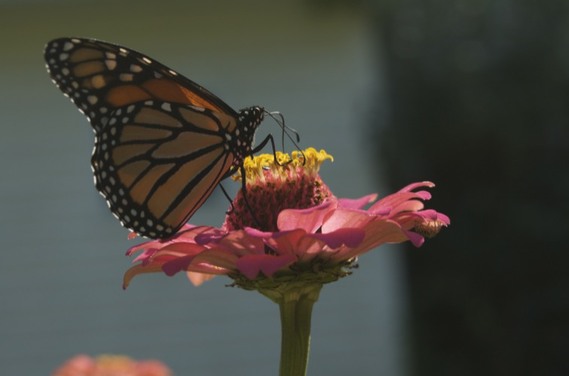
Monarch Sightings??
Have you been lucky enough to spot a Monarch butterfly sipping nectar from your flowers? This beautiful and amazing butterfly is experiencing a significant drop in population. Many people have carefully cleared the borders of their property of the only plant on which a Monarch can lay its eggs - the Milkweed. Even those of us who grow a wide variety of nectaring flowers and milkweed are lucky to have this beautiful visitor. Click on the links below to find out more about Monarchs and why some generations live only two to six weeks while others live eight months.
http://www.xerces.org/monarchs/
http://www.xerces.org/wpcontent/uploads/2014/10/PartnershipsforMonarchs_web.pdf
http://aqua.org/blog/2014/november/monarchs-ultimate-race?gclid=CjwKEAjwmZWvBRCCqrDK_8atgBUSJACnib3l84fAWp6JwSas812-X4Tzz4JGouCAZFzZxyPpgNo7FhoCgPzw_wcB September 1, 2015
Have you been lucky enough to spot a Monarch butterfly sipping nectar from your flowers? This beautiful and amazing butterfly is experiencing a significant drop in population. Many people have carefully cleared the borders of their property of the only plant on which a Monarch can lay its eggs - the Milkweed. Even those of us who grow a wide variety of nectaring flowers and milkweed are lucky to have this beautiful visitor. Click on the links below to find out more about Monarchs and why some generations live only two to six weeks while others live eight months.
http://www.xerces.org/monarchs/
http://www.xerces.org/wpcontent/uploads/2014/10/PartnershipsforMonarchs_web.pdf
http://aqua.org/blog/2014/november/monarchs-ultimate-race?gclid=CjwKEAjwmZWvBRCCqrDK_8atgBUSJACnib3l84fAWp6JwSas812-X4Tzz4JGouCAZFzZxyPpgNo7FhoCgPzw_wcB September 1, 2015
* * * *
Extend Your Growing Season With Fall Plantings
School is open in many towns. Warmer clothes are on display in the stores. August is drawing to a close. Fall can't be far away! As summer plants begin to lose their energy - you don't have to give up garden-to-table eating just yet. There are several things that can be done to extend the growing season. The simplest is to replant. If planted early enough to get a good start, some plants actually enjoy the cooler weather, and others sweeten with the nip of frost. Johnny's Selected Seeds of Albion Maine offers a Fall Harvest Planting Calendar and recommended seed varieties here: http://www.johnnyseeds.com/v-45-recommended-summer-planting-for-fall-harvest.aspx Just enter your your first frost date and the chart will display what should work best in your area.
You can also extend your growing season by hooping beds and covering them with Agribon or greenhouse film. Growing in a container on wheels or one that is relatively light has the added benefit of allowing some movement in and outdoors to avoid the cold, and following the sun's lower path through the sky.
Let us know what works for you! You can reach us at [email protected] or by clicking on "Contact Us" under the "More" tab above.
August 26, 2015
You can also extend your growing season by hooping beds and covering them with Agribon or greenhouse film. Growing in a container on wheels or one that is relatively light has the added benefit of allowing some movement in and outdoors to avoid the cold, and following the sun's lower path through the sky.
Let us know what works for you! You can reach us at [email protected] or by clicking on "Contact Us" under the "More" tab above.
August 26, 2015
* * * *
Cucumbers Rise To New Heights!
* * * *
Why Eat Tomatoes?
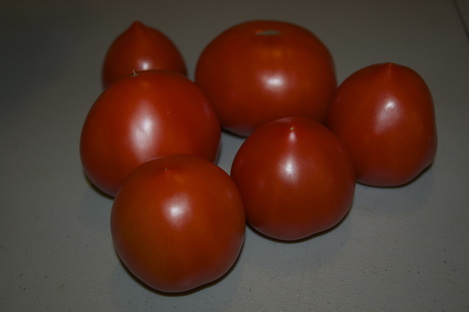
We're at the height of the tomato season and Madison wants everyone to know that there are lots of reasons other than their good looks - for eating tomatoes.
14 Reasons to Eat Tomatoes
They are:
1. low in Sodium
2. very low in Saturated Fat and Cholesterol
3. a good source of Vitamin E (Alpha tocopherol)
They contain:
4. Thiamin, 5. Niacin, 6. Vitamin B6, 7. Folate,
8. Magnesium, Phosphorus and Copper
9. Dietary Fiber
10. Vitamins A, C and K 11. Potassium and Manganese,
12. Lycopene with its antioxidant properties that contribute to bone health and help protect us from cancer.
And:
13. They add color to your salad!
14. They taste good!
August 16, 2015
* * * *
Why Do Tomatillos Have A Sticky Coating?
Once you remove the paper lantern from a tomatillo you may encounter a sticky film or resin on the beautiful shiny fruit inside. This is easily removed by rinsing it under running warm water. Madison says that those of you who prefer eating organically will appreciate both the outer wrapper and the resin. Both layers discourage pests that might want to sample the fruit before you get to eat it.
If you'd like to learn more about this interesting warm-weather crop check out this video: https://www.youtube.com/watch?v=IizJG6CatPc
August 11, 2015
If you'd like to learn more about this interesting warm-weather crop check out this video: https://www.youtube.com/watch?v=IizJG6CatPc
August 11, 2015
* * * *
Tomatillos Are Ready!
Have you ever wondered what those green, "paper-wrapped" fruit are that are displayed near tomatoes, garlic, avocados and basil in your grocery store? They are called tomatillos and are a key ingredient in salsa and cold summer soup. Martha Stewart calls them "tart, refreshing fruits". She says when selecting them to "Choose small, firm, bright-green fruits with green to brownish-green husks that are more or less intact (it’s okay if the husks are split, but they shouldn’t be peeled off)." Linda Stradley in What's Cooking America says that you want them to be firm. Keep them in their paper wrappers until you use them. They can be stored on the counter or in the refrigerator, but not in an air-tight container. They can range from tart to sweet. Linda recommends the following cooking methods:
1. Raw - Raw or uncooked tomatillos are often in Mexican sauces. They add a fresh citrus-like flavor.
2. Blanching - Blanching mellows the flavor. Bring a large pot of water to a boil. Add the whole tomatillos (husks removed and rinsed) and boil for approximately 5 minutes or until soft. Drain and crush or puree as directed in your recipe.
3. Fire Roasting - Roast under the broiler, . . . or on a grill. Make sure the heat is quite hot before roasting . . . or they wil turn mushy before being charred. The charred or slightly blackened skins will enrich your sauces with a smoky flavor.
5. Dry Roasting - This will produce an earthy, nutty flavor. Place the tomatillos in a heavy fry pan (preferably a cast iron pan). Turn heat to low and roast for approximately 20 to 30 minutes, turning occasionally. August 5, 2015
Have you ever wondered what those green, "paper-wrapped" fruit are that are displayed near tomatoes, garlic, avocados and basil in your grocery store? They are called tomatillos and are a key ingredient in salsa and cold summer soup. Martha Stewart calls them "tart, refreshing fruits". She says when selecting them to "Choose small, firm, bright-green fruits with green to brownish-green husks that are more or less intact (it’s okay if the husks are split, but they shouldn’t be peeled off)." Linda Stradley in What's Cooking America says that you want them to be firm. Keep them in their paper wrappers until you use them. They can be stored on the counter or in the refrigerator, but not in an air-tight container. They can range from tart to sweet. Linda recommends the following cooking methods:
1. Raw - Raw or uncooked tomatillos are often in Mexican sauces. They add a fresh citrus-like flavor.
2. Blanching - Blanching mellows the flavor. Bring a large pot of water to a boil. Add the whole tomatillos (husks removed and rinsed) and boil for approximately 5 minutes or until soft. Drain and crush or puree as directed in your recipe.
3. Fire Roasting - Roast under the broiler, . . . or on a grill. Make sure the heat is quite hot before roasting . . . or they wil turn mushy before being charred. The charred or slightly blackened skins will enrich your sauces with a smoky flavor.
5. Dry Roasting - This will produce an earthy, nutty flavor. Place the tomatillos in a heavy fry pan (preferably a cast iron pan). Turn heat to low and roast for approximately 20 to 30 minutes, turning occasionally. August 5, 2015
* * * *
Rosebreasted Grosbeak Surprise
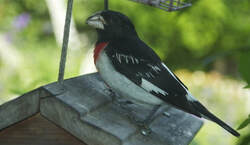
A pleasant visit from this rosebreasted grosbeak became even more interesting. I had searched for it's song on the internet, and was listening to it near an open window by the feeder. After I had stopped taking pictures and several minutes had gone by, I felt as if someone was watching me. When I looked at the feeder - there he was sitting motionless - apparently intently listening to the recording.
July 11, 2015
July 11, 2015
* * * *
Nutritional Focus on Beets
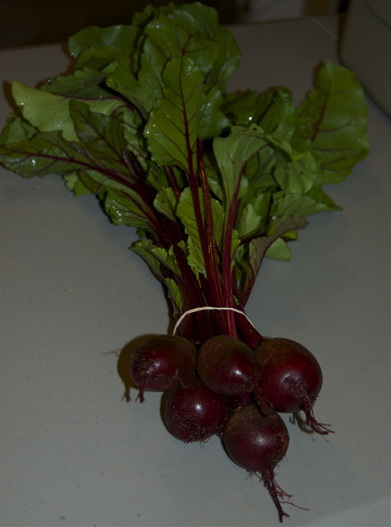
The World's Heathiest Foods website (whfoods.org) states that beets "are a unique source of phytonutrients called betalains. Betanin and vulgaxanthin are the two best-studied betalains from beets, and both have been shown to provide antioxidant, anti-inflammatory, and detoxification support." They recommend ". . . steaming beets for 15 minutes to maximize their nutrition and flavor." Read more here: http://www.whfoods.com/genpage.php?tname=foodspice&dbid=49
July 5, 2015
July 5, 2015
* * * *
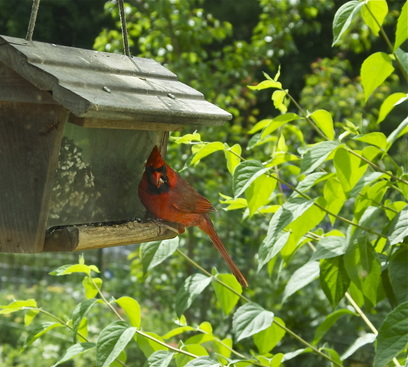
The male cardinal is getting less and less shy as he continues his feeding vigil. He now lands on the house-side of the feeder. Maybe their eggs will hatch early - and he will have a true "Father's Day" celebration tomorrow! However, if he thinks he is busy now - just wait until the female constructs a new nest and starts to sit on those eggs. Dad will then feed her, continue to feed the new fledglings from this first brood, and protect their territory.
6/20/15
6/20/15
* * * *
Container Gardening
Madison's tip of the day for those of you who are growing in non-self-watering containers is to watch your plants' water consumption very carefully. Hopefully your container(s) has (have) drainage holes in the bottom - to help it (them) handle too much water received at one time. Without drainage holes - plants may drown! Your watering goal is to thoroughly wet the entire root ball until a little water drains out the bottom. The challenge with this is that a dried out root ball will have pulled awy from the edges of the container so that all the water drains out the bottom on a first watering. Thus it is important to fill the top of the container, wait while it is absorbed, and then water again. This process may need to be repeated more than once until an adequate amount of water has been absorbed.
It is surprizing how much water needs will increase as the plants grow. For example, a large fruiting tomato plant may need up to 1 gallon of water a day during hot summer days. 6/18/15
It is surprizing how much water needs will increase as the plants grow. For example, a large fruiting tomato plant may need up to 1 gallon of water a day during hot summer days. 6/18/15
* * * *
Cardinal Update
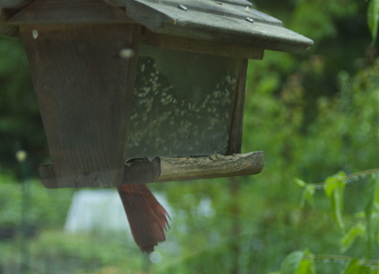
He is still coming to the feeder and mom is nowhere to be seen. Nearly every time he tries to focus on picking up a seed he slips off the perch and needs to flap his wings to recover his balance. Seeds go flying until he resettles long enough to select just the right seeds for her.
6/18/15
6/18/15
* * * *
Busy Cardinal Feeds Mate As She Incubates Eggs
Our male cardinal is a very busy bird these days. He began early again this morning and was still working at 8:30 p.m. He came to our feeder every few minutes and then flew directly to a very large holly bush on the edge of the woods for most of the morning and later afternoon. He also guarded the area. At one point we saw him drop the seed he had gathered at the feeder to chase an intruding bird away from the fence near the holly bush. He finally took a break for a quiet bite of "supper" near dusk.
We believe his mate is sitting on a nest of eggs. If we are correct, and this is day 2, she will be staying in the bush 10 to 11 more days. Then mom and dad will both be busy feeding their young for 9 - 11 days. She may then build a new nest and disappear again to sit on a second brood while dad feeds both the new fledglings and mom.
Click the link to see a male feeding a tasty worm to a female sitting on a nest. https://www.youtube.com/watch?v=cwhVnUANI9U
6/14/15
We believe his mate is sitting on a nest of eggs. If we are correct, and this is day 2, she will be staying in the bush 10 to 11 more days. Then mom and dad will both be busy feeding their young for 9 - 11 days. She may then build a new nest and disappear again to sit on a second brood while dad feeds both the new fledglings and mom.
Click the link to see a male feeding a tasty worm to a female sitting on a nest. https://www.youtube.com/watch?v=cwhVnUANI9U
6/14/15
Helpful Gardening Tools
Have you ever wondered if there was a tool that would make your gardening task more "do-able"? This is a site that lists some helpful sources: http://ssiblegardens.org/sources-for-tools-to-assist-gardeners-2/ . There is a tool here for everyone that can make gardening easier and more fun!
Here is a quick look at Natural Radius grip tools: https://www.youtube.com/watch?v=NKUXqKZhgX8
Explore what's out there. You may be surprised what you find and how much it can help!
6/7/
Here is a quick look at Natural Radius grip tools: https://www.youtube.com/watch?v=NKUXqKZhgX8
Explore what's out there. You may be surprised what you find and how much it can help!
6/7/
* * * *
Spring Is Really Here -
Despite the coldest June 1st on Record!
Despite the coldest June 1st on Record!
The delphiniums have begun! Ageratums are a great blue.
6/5/15
* * * *
Accessible Gardening Resources
This site includes a varied compilation of very helpful resources: http://accessiblegardens.org Be sure to begin with the website tour video, and then enjoy exploring. One of my personal favorites is "Real People - Real Gardens" because it gives insight into gardening from the gardener's perspective.
6/5/15
6/5/15
* * * *
Wish You Could Garden This Year?
Are you wishing you could garden this year, but you feel overwhelmed with physical challenges? Here is a video of Shirley Bovshow with some excellent suggestions for keeping you connected to what you love. http://www.accessiblegardens.com
6/1/15
6/1/15
* * * *
Madison's Transplanting Tips
Growing plants from seed opens up many new and exciting possibilities. It lets you grow varieties that are new on the market or treasured heirlooms that may not be available as plants. Did you ever wonder why the plants that you started indoors didn't do well when you planted them outside? Madison has a list of suggestions to ensure transplanting success.
1. Timing is important. Read carefully - on the seed packet, catalog or on-line to find out when each type of plant can be moved outside in your area.
2. Harden them off. Plants need to adjust to sunshine and wind gradually. It is best to put them in the sun for gradually longer and longer periods of
time each day before actually planting them in the ground.
3. Location, location, location. Choose a location that provides what the plant prefers. Some like full sun while others prefer some shade.
4. Prepare the soil. Loosen it, add soil amendments such as compost and fertilizer. Check the PH of the soil and add lime if necessary.
5. Water before removing. Water transplants deeply before attempting to remove them from their container. Be gentle and squeeze the pot.
6. Cloudy days are best. Try to transplant on a cloudy or misty day.
7. Depth is important. Carefully place the plant at the same depth that it was growing at in the container. Do not cover any leaves or leave roots
exposed. One outstanding exception to this is tomatoes. Bottom leaves should be removed and the plant planted deeply -
especially if it is leggy. It will grow roots on the buried stem.
7. Use a gentle but firm hand. Firm the soil around the plant stem to press out air pockets.
8. Water them in. Make sure to water the plants well after planting them.
9. Enjoy!
5/30/15
1. Timing is important. Read carefully - on the seed packet, catalog or on-line to find out when each type of plant can be moved outside in your area.
2. Harden them off. Plants need to adjust to sunshine and wind gradually. It is best to put them in the sun for gradually longer and longer periods of
time each day before actually planting them in the ground.
3. Location, location, location. Choose a location that provides what the plant prefers. Some like full sun while others prefer some shade.
4. Prepare the soil. Loosen it, add soil amendments such as compost and fertilizer. Check the PH of the soil and add lime if necessary.
5. Water before removing. Water transplants deeply before attempting to remove them from their container. Be gentle and squeeze the pot.
6. Cloudy days are best. Try to transplant on a cloudy or misty day.
7. Depth is important. Carefully place the plant at the same depth that it was growing at in the container. Do not cover any leaves or leave roots
exposed. One outstanding exception to this is tomatoes. Bottom leaves should be removed and the plant planted deeply -
especially if it is leggy. It will grow roots on the buried stem.
7. Use a gentle but firm hand. Firm the soil around the plant stem to press out air pockets.
8. Water them in. Make sure to water the plants well after planting them.
9. Enjoy!
5/30/15
* * * *
What's Growing On The Farm?
Here's a quick peek. . .
Here's a quick peek. . .
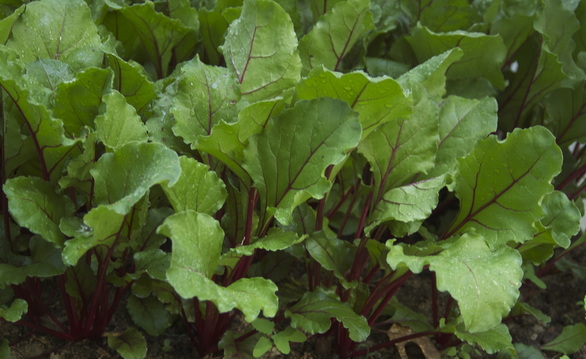
Beets. . .
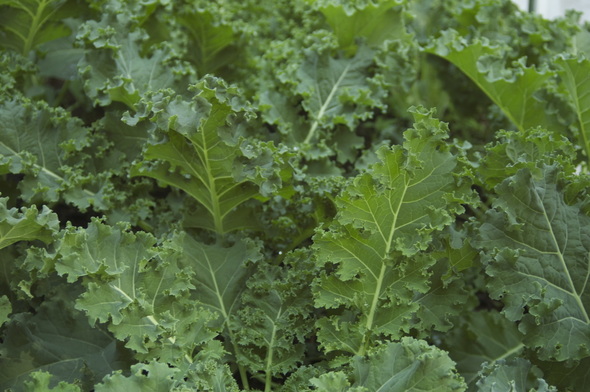
Kale. . .
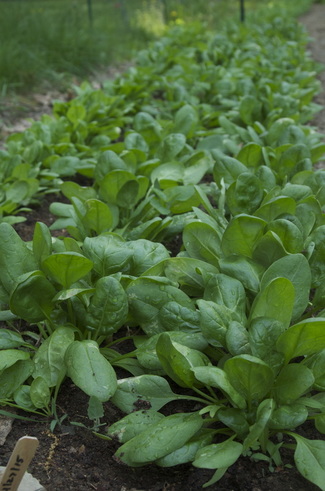
Spinach. . .
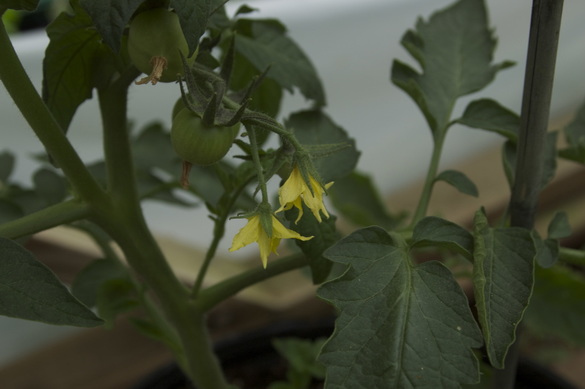
Tomatoes. . .
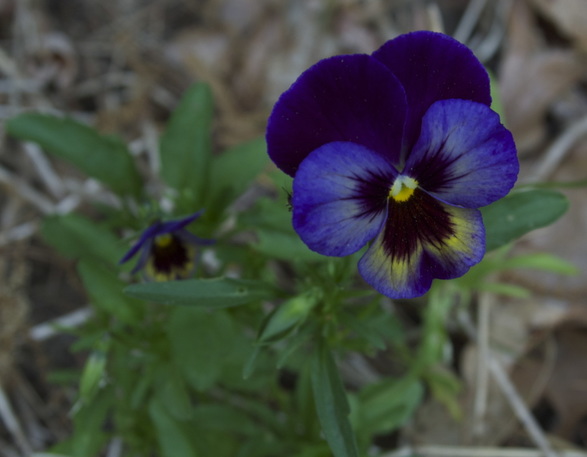
Flowers. . .
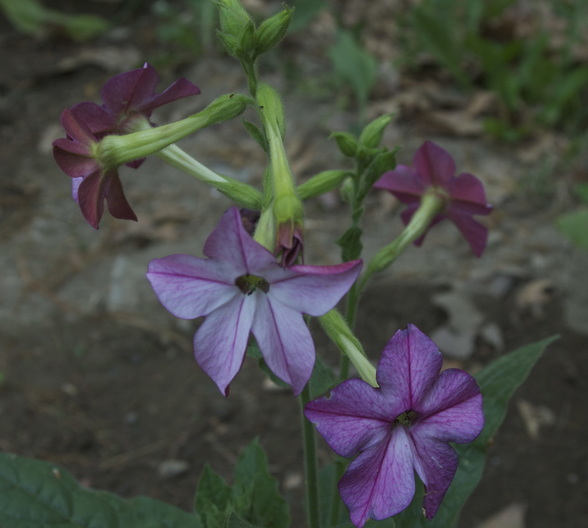
5/26/15
* * * *
Bring a Breath of Spring Indoors
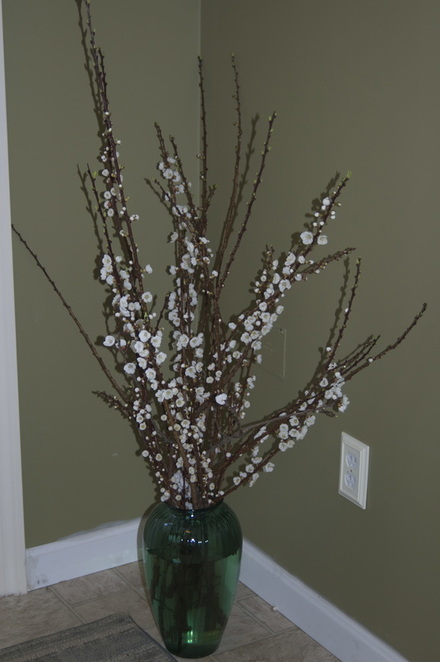
Madison recommends putting branches from trees that will flower outside - as soon as the weather warms - in water and bringing them indoors. They will encourage you as you wait for warmer days, and inspire you with their beauty and delicate fragrance.
Apricot branches . . .
4/29/15
Apricot branches . . .
4/29/15
* * * *
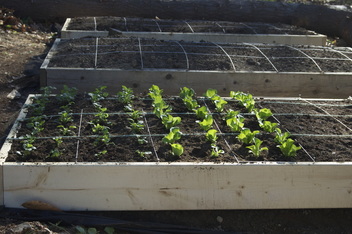
Time To Refurbish Your Raised Beds
Raised beds going into their second (or more) year of service, need a boost before planting them again. Greg Seaman from Eartheasy.com gives many helpful suggestions http://eartheasy.com/blog/2011/03/raised-beds-preparing-your-garden-beds-for-spring/ . John Koehler from GrowingYourGreens.com shows how to evaluate the health of your soil. https://www.youtube.com/watch?v=tiLQfCNkf7w . Valerie Gleaton explains how to build your gardening soil - whether in or out of a raised bed.
http://life.gaiam.com/article/restoring-your-soil
s
Raised beds going into their second (or more) year of service, need a boost before planting them again. Greg Seaman from Eartheasy.com gives many helpful suggestions http://eartheasy.com/blog/2011/03/raised-beds-preparing-your-garden-beds-for-spring/ . John Koehler from GrowingYourGreens.com shows how to evaluate the health of your soil. https://www.youtube.com/watch?v=tiLQfCNkf7w . Valerie Gleaton explains how to build your gardening soil - whether in or out of a raised bed.
http://life.gaiam.com/article/restoring-your-soil
s
A key component is compost. Raised beds can easily be hooped and covered for a jump start on the season.
4/17/15
4/17/15
* * * *
Generous Snowfall Calls For Creative Planting Techniques
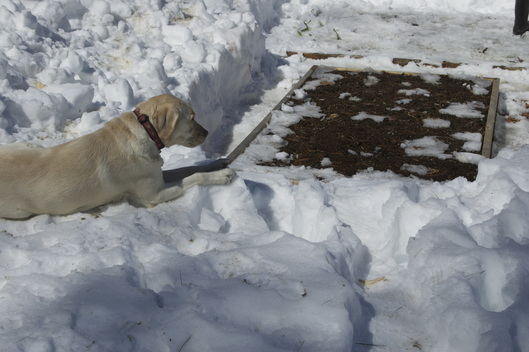
This winter's generous snowfall added new tasks to the normal March workload. Without a new approach, our raised beds in Boylston would not be ready on time for planting. When we began preparations we had over a foot of snow on top of the beds. Clearing them off allowed the sun to begin thawing the soil.
Madison waiting for the snow to melt . . .
4/8/15
Madison waiting for the snow to melt . . .
4/8/15
* * * *
Tips For Starting Seeds Indoors
1. Gather all materials before you start, including:
* Seeds - either purchased through a seed catalog, at a local farm and garden center, or swapped with a friend;
* A container - seed trays, peat pots, used containers - IF they can be cleaned and holes can be punched in the sides near the bottom.
* Growing medium - seed starting mix (like ProMix) is best. A soilless peat/vermiculite/perlite mix will hold water and allow air flow. Do not be tempted
to use potting soil or "used" soil from a plant that has "passed away" or you may be inviting trouble (like the dreaded Damping Off)!
* Plant markers and permanent marking pen to label and date what you have planted.
* A large clean "bucket" for mixing water into the growing medium.
2. Plant your seeds at the correct time and group them according to required germination and growing conditions. Seed packets, catalogs and seed
company websites provide a wealth of this information. To determine the last frost date in your area you can use a website like Burpee's at :
http://www.burpee.com/gygg/growingCalendarNoZipCode.jsp , enter your zip code and see helpful planting guidelines. Other sites to check are
Dave'e garden at: http://davesgarden.com/guides/freeze-frost-dates/#b and The Old Farmer's Almanac at: http://www.almanac.com/content/frost-
chart- united-states/CA. Count backward from your last frost date the number of weeks indicated on the seed packet. Some seeds need darkness
and others light to germinate - so try to start those with similar requirements in the same container.
3. Follow guidelines on the packets regarding chilling / freezing seeds before planting them. Some will require this "vernalization" to trick them into
thinking winter has come and gone - and it's now time to spring to life.
4. Mix your planting mix thoroughly with warm water in the clean bucket. You may be quite surprized by the quantity of water that will be needed to
moisten the mix enough for planting. A scooped up handful should stick together when squeezed in your hand, but should not be dripping water.
5. Spread mix in your clean container to just below the lip. Plant seeds at the depth indicated on the seed packet and mark with a plant label.
6. Place planted container(s) in the temperature and light listed on the seed packet(s). Most seedings will not receive enough natural light from a
window. Growing lights can be as simple as shop lights suspended under a card table on a chain attached with S hooks or bungee cords. Use
5,000K to 6,500K which is closest to natural light. Place the planted trays on the floor under the suspended lights. This simple system allows you to
raise the lights as the plants grow - so that they stay a consistent 2 or 3 inches above the plants.
* Seeds - either purchased through a seed catalog, at a local farm and garden center, or swapped with a friend;
* A container - seed trays, peat pots, used containers - IF they can be cleaned and holes can be punched in the sides near the bottom.
* Growing medium - seed starting mix (like ProMix) is best. A soilless peat/vermiculite/perlite mix will hold water and allow air flow. Do not be tempted
to use potting soil or "used" soil from a plant that has "passed away" or you may be inviting trouble (like the dreaded Damping Off)!
* Plant markers and permanent marking pen to label and date what you have planted.
* A large clean "bucket" for mixing water into the growing medium.
2. Plant your seeds at the correct time and group them according to required germination and growing conditions. Seed packets, catalogs and seed
company websites provide a wealth of this information. To determine the last frost date in your area you can use a website like Burpee's at :
http://www.burpee.com/gygg/growingCalendarNoZipCode.jsp , enter your zip code and see helpful planting guidelines. Other sites to check are
Dave'e garden at: http://davesgarden.com/guides/freeze-frost-dates/#b and The Old Farmer's Almanac at: http://www.almanac.com/content/frost-
chart- united-states/CA. Count backward from your last frost date the number of weeks indicated on the seed packet. Some seeds need darkness
and others light to germinate - so try to start those with similar requirements in the same container.
3. Follow guidelines on the packets regarding chilling / freezing seeds before planting them. Some will require this "vernalization" to trick them into
thinking winter has come and gone - and it's now time to spring to life.
4. Mix your planting mix thoroughly with warm water in the clean bucket. You may be quite surprized by the quantity of water that will be needed to
moisten the mix enough for planting. A scooped up handful should stick together when squeezed in your hand, but should not be dripping water.
5. Spread mix in your clean container to just below the lip. Plant seeds at the depth indicated on the seed packet and mark with a plant label.
6. Place planted container(s) in the temperature and light listed on the seed packet(s). Most seedings will not receive enough natural light from a
window. Growing lights can be as simple as shop lights suspended under a card table on a chain attached with S hooks or bungee cords. Use
5,000K to 6,500K which is closest to natural light. Place the planted trays on the floor under the suspended lights. This simple system allows you to
raise the lights as the plants grow - so that they stay a consistent 2 or 3 inches above the plants.
|
|
7. Water gently and regularly. Don't let the surface of planting medium dry out. It will discourage germination and a "crust" may form that is hard for the new seedlings to break through. 8. Enjoy the excitement of watching your seeds grow! 3/18/15 |
* * * *
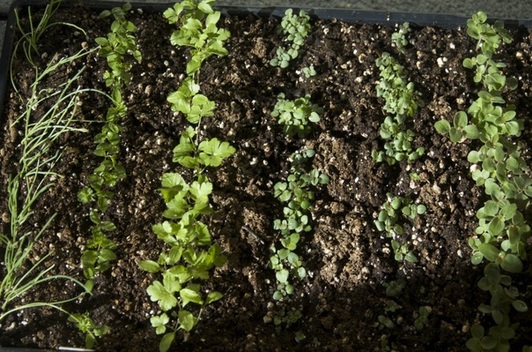
Why Start Plants Indoors From Seeds?
• You need to celebrate that you have just survived a very
challenging winter.
• You have more choice in what you grow.
• It's fun to watch them grow and develop.
• It can save you money.
• It can help you wait for the snow to melt.
• It's fun getting your hands (or paws) dirty!
3/13/15
• You need to celebrate that you have just survived a very
challenging winter.
• You have more choice in what you grow.
• It's fun to watch them grow and develop.
• It can save you money.
• It can help you wait for the snow to melt.
• It's fun getting your hands (or paws) dirty!
3/13/15
* * * *
The Benefits of Pelleted Seeds
Have you ever found it challenging when planting small seeds to:
1. see them 2. pick them up 3. space them evenly?
Pelleted seeds may be helpful. Tiny or irregularly shaped seeds are coated with an inert material.
They are often white or light yellow and usually round. They are much easier to see and handle.
Once seeds are pelleted they will not last as long - so only buy what you will plant this year.
Give them a try! 3/8/15
1. see them 2. pick them up 3. space them evenly?
Pelleted seeds may be helpful. Tiny or irregularly shaped seeds are coated with an inert material.
They are often white or light yellow and usually round. They are much easier to see and handle.
Once seeds are pelleted they will not last as long - so only buy what you will plant this year.
Give them a try! 3/8/15
* * * *
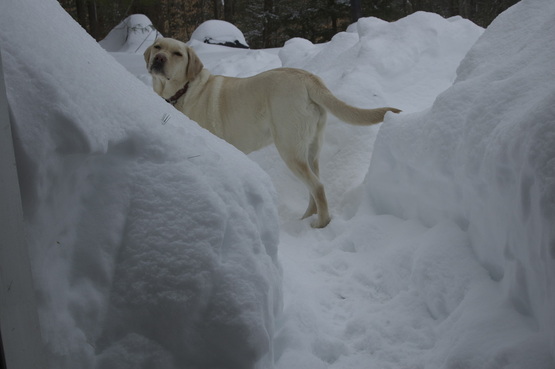
Spring is HOW Many Weeks Away?
All the signs are in place. . . We turn the clocks ahead this Sunday. . . The calendars say that Spring begins Friday, March 20th. . . There have been robin sightings, (but I am told that some chose not to migrate south at all this winter). . .
This should be an amazing few weeks!!!
Check out this hope-inspiring count down calendar: http://days.to/spring/2015 3/3/15
All the signs are in place. . . We turn the clocks ahead this Sunday. . . The calendars say that Spring begins Friday, March 20th. . . There have been robin sightings, (but I am told that some chose not to migrate south at all this winter). . .
This should be an amazing few weeks!!!
Check out this hope-inspiring count down calendar: http://days.to/spring/2015 3/3/15
* * * *
Creating a Monarch-Friendly Habitat
There are many things that we can do to support Monarchs and other pollinators in their struggle to survive. Monarchs need milkweed plants when they are caterpillars because that is the ONLY thing they eat in the larval stage Serveral varieties of milkweed grow in Massachusetts including common, swamp, tropical and butterfly milkweed. Adult Monarchs need a variety of nectar flowers, water and can even consume liquids from some fruits. Nectar flowers will attract a variety of bees, hummingbirds, butterfly moths and butterflies. Last summer our Sweet Williams even attracted a giant swallowtail.
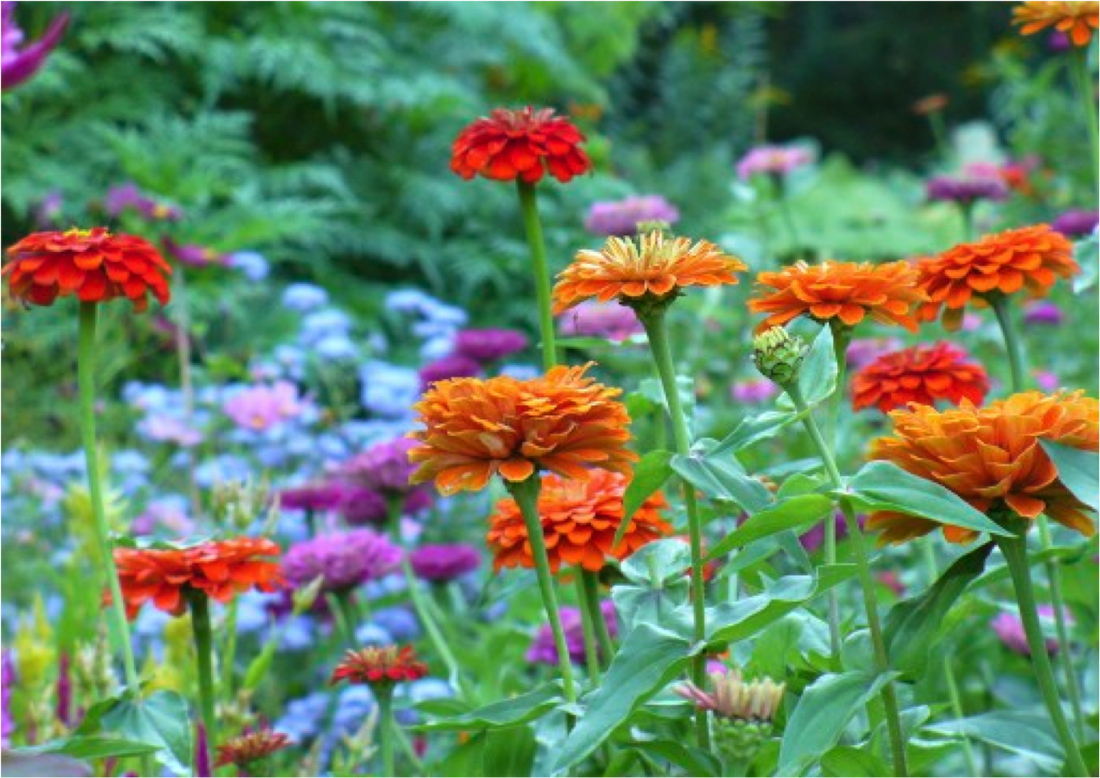
Monarchs are attracted to large, brightly colored blooms like these zinnias. They also enjoy our delicate blue ageratums seen in the background.
Here is a list of other useful plants that you might consider growing: http://monarchwatch.org/garden/plant-list-monarchwatch.pdf 2/20/15
* * * *
Monarchs in Danger
The struggle of the Monarch population is currently highlighted on the Weather Channel. See what they are saying: http://www.weather.com/series/great-outdoors/video/the-monarch-butterfly-massacre
The U.S. Fish and wildlife service describes what they are doing about this crisis and in this article, explains how you can help - Save the Monarch Butterfly: http://www.fws.gov/savethemonarch/
Looking for something new to grow this year? Why not join the effort to save Monarchs while you beautify your yard! Monarch Joint Venture has many helpful suggestions. http://monarchjointventure.org/images/uploads/documents/MilkweedFactSheetFINAL.pdf Let us know if you need additional seed source suggestions.([email protected]).
The U.S. Fish and wildlife service describes what they are doing about this crisis and in this article, explains how you can help - Save the Monarch Butterfly: http://www.fws.gov/savethemonarch/
Looking for something new to grow this year? Why not join the effort to save Monarchs while you beautify your yard! Monarch Joint Venture has many helpful suggestions. http://monarchjointventure.org/images/uploads/documents/MilkweedFactSheetFINAL.pdf Let us know if you need additional seed source suggestions.([email protected]).
* * * *
Vertical Gardening With "Wallygro"
For those who aren't inclined to "make" their vertical gardens, Wallygro & Wooly Pockets offer a wonderful variety of functional options. Check out their website here: http://www.woollypocket.com/vertical-gardens?gclid=CIaR84eRycMCFRIQ7AodI1oA1w
These are easy to hand water and can also be purchased with automatic watering systems. They can be mounted at any height to accommodate seated, kneeling and standing gardening.
For those who aren't inclined to "make" their vertical gardens, Wallygro & Wooly Pockets offer a wonderful variety of functional options. Check out their website here: http://www.woollypocket.com/vertical-gardens?gclid=CIaR84eRycMCFRIQ7AodI1oA1w
These are easy to hand water and can also be purchased with automatic watering systems. They can be mounted at any height to accommodate seated, kneeling and standing gardening.
Don't miss their "Resources" section with very interesting videos and this product comparison: http://www.woollypocket.com/comparing-livingwallplanters
Our next post on vertical gardens will address low cost approaches for the frugally minded!
Our next post on vertical gardens will address low cost approaches for the frugally minded!
* * * *
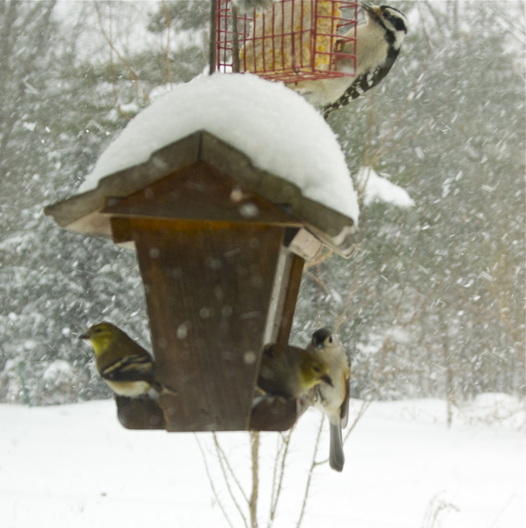
The Blizzard of 2015
Sharing during the storm. . .
Sharing during the storm. . .
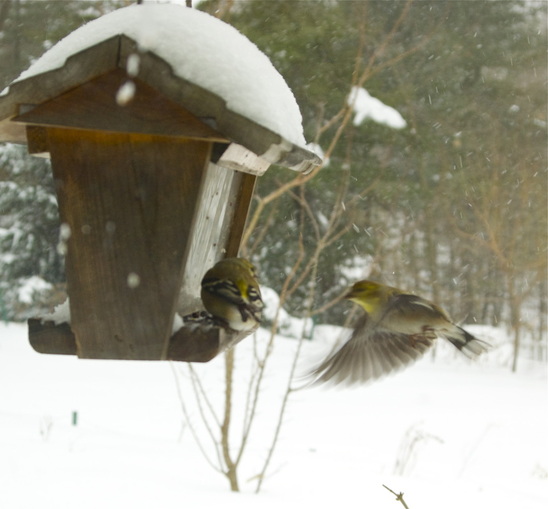
Feeding Birds During the Winter
For those concerned about birds during weeks like this one, the Audubon website says that if their "natural food is buried for a period of time . . . the seed you put out could be life-saving for some birds."
When Should I Start and Stop Feeding Birds?
http://birds.audubon.org/faq#t1441n4756
For those concerned about birds during weeks like this one, the Audubon website says that if their "natural food is buried for a period of time . . . the seed you put out could be life-saving for some birds."
When Should I Start and Stop Feeding Birds?
http://birds.audubon.org/faq#t1441n4756
* * * *
Madison Says That Snow Storms Are a Good Time For Reading
Here is a delightl story, appropriate for this week, that young readers might enjoy. Bear Snores On was written by Karma Wilson and illustrated by Jane Chapman. It is read in this video by the Dyer family. It is best watched full screen. https://www.youtube.com/watch?x-yt-cl=84503534&x-yt-ts=1421914688&v=6hHdhhFpy3Y
Here is a delightl story, appropriate for this week, that young readers might enjoy. Bear Snores On was written by Karma Wilson and illustrated by Jane Chapman. It is read in this video by the Dyer family. It is best watched full screen. https://www.youtube.com/watch?x-yt-cl=84503534&x-yt-ts=1421914688&v=6hHdhhFpy3Y
* * * *
The Many Forms of Vertical Gardens
Vertical gardens eliminate many of the challenges of gardening with mobility issues. Here is a Home Depot DIY video for a fun winter project - if you are not intimidated by light construction. http://howto.homedepot.com/videos/watch/1542969592001/How-to-Create-a-Vertical-GardenDemonstration.html
We will post information on a variety of types to inspire your creativity.
Vertical gardens eliminate many of the challenges of gardening with mobility issues. Here is a Home Depot DIY video for a fun winter project - if you are not intimidated by light construction. http://howto.homedepot.com/videos/watch/1542969592001/How-to-Create-a-Vertical-GardenDemonstration.html
We will post information on a variety of types to inspire your creativity.
* * * *
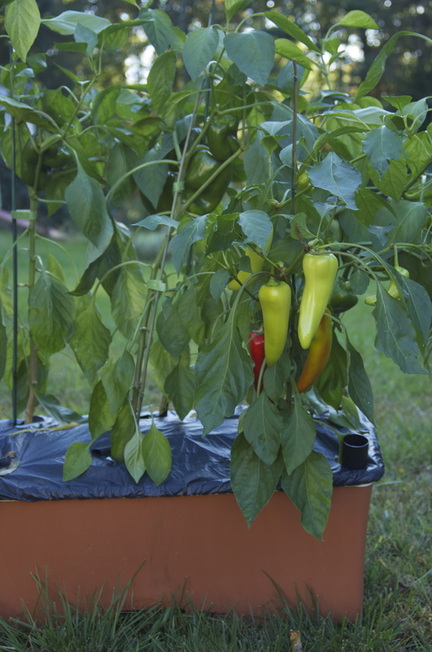
Resources Helpful in Planning An Accessible Garden
Interested in trying a self-watering container? Earthbox has several options that are wonderful for gardening anywhere. You can put them right outside your door, on your deck, or roll them around on your driveway to follow the sun. Click on the link below to see a list of videos that may help you decide if you want to try one.
Interested in trying a self-watering container? Earthbox has several options that are wonderful for gardening anywhere. You can put them right outside your door, on your deck, or roll them around on your driveway to follow the sun. Click on the link below to see a list of videos that may help you decide if you want to try one.
http://earthbox.com/videos
* * * *
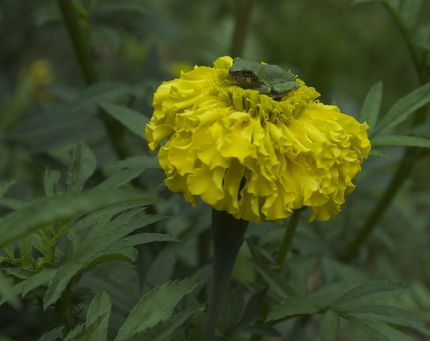
Where Do Gray Tree Frogs Go In The Winter?
The University of Michigan’s BioKids website tells us that Eastern Gray Treefrogs do in fact hibernate under tree roots, logs, soil and leaves.
“About 40% of their body can freeze during the winter. They keep their blood stream from freezing by producing an antifreeze-like fluid called glycerol.”
Find out more at: http://www.biokids.umich.edu/critters/Hyla_versicolor/
The Lee and Rose Warner Nature Center website adds that “Gray treefrogs have a high freeze tolerance, which means they can survive up to 80% of their body freezing during hibernation and then are able to thaw and hop away in the spring. Gray tree frogs are able to do this because of a special chemical that keeps the water in their bodies a frozen mush instead of solid ice, which would permanently damage their organs and other important body parts."
http://www.smm.org/warnernaturecenter/animals/treefrog
I can’t wait to have them all thaw and take their daily sun naps atop our four foot Marigolds! Here’s the link to a song written by David Burba and illustrated by Linda Willis about hibernation that younger gardeners might enjoy.
https://www.youtube.com/watch?v=BstmnCYwAE8
The University of Michigan’s BioKids website tells us that Eastern Gray Treefrogs do in fact hibernate under tree roots, logs, soil and leaves.
“About 40% of their body can freeze during the winter. They keep their blood stream from freezing by producing an antifreeze-like fluid called glycerol.”
Find out more at: http://www.biokids.umich.edu/critters/Hyla_versicolor/
The Lee and Rose Warner Nature Center website adds that “Gray treefrogs have a high freeze tolerance, which means they can survive up to 80% of their body freezing during hibernation and then are able to thaw and hop away in the spring. Gray tree frogs are able to do this because of a special chemical that keeps the water in their bodies a frozen mush instead of solid ice, which would permanently damage their organs and other important body parts."
http://www.smm.org/warnernaturecenter/animals/treefrog
I can’t wait to have them all thaw and take their daily sun naps atop our four foot Marigolds! Here’s the link to a song written by David Burba and illustrated by Linda Willis about hibernation that younger gardeners might enjoy.
https://www.youtube.com/watch?v=BstmnCYwAE8
* * * *
Useful Online Resources
Explore online resources to help you decide what you might want to grow this year and plan how many seeds to buy based on your garden space.
One helpful site is the Gardener's Supply Company's Kitchen Garden Planner. Below is a link to their Vegetable Encyclopedia. There are tabs for vegetables, herbs and fruit. On the left edge of the page there are sections listed for pre-planned gardens and tools to create your own plan. These are based on raised beds and the use of Square Foot Gardening techniques by Mel Bartholomew. This tool enables you to change the size of the bed, figure out how many plants of each type to plant in each square foot, save, print and email your finished product.
Explore online resources to help you decide what you might want to grow this year and plan how many seeds to buy based on your garden space.
One helpful site is the Gardener's Supply Company's Kitchen Garden Planner. Below is a link to their Vegetable Encyclopedia. There are tabs for vegetables, herbs and fruit. On the left edge of the page there are sections listed for pre-planned gardens and tools to create your own plan. These are based on raised beds and the use of Square Foot Gardening techniques by Mel Bartholomew. This tool enables you to change the size of the bed, figure out how many plants of each type to plant in each square foot, save, print and email your finished product.
http://www.gardeners.com/gardening-encyclopedia?asset=7191
Seed Savers Exchange offers an interesting Garden Planner. It is free for the first 30 days. A one-year $25 subscription includes:
Seed Savers Exchange offers an interesting Garden Planner. It is free for the first 30 days. A one-year $25 subscription includes:
- continued access to your garden plans so that you can make changes and updates.
- personalized emails signaling sowing and planting dates for your zone.
- creation of up to five plans per year.
- ability to revisit this year's plans next year - for quicker planning and effective crop rotation.
The Urban Farmer includes a variety of helpful information under the tab "Garden Guide - Tips, Advice & More" - from zone-based planting schedules, to pest management and companion planting.
http://www.ufseeds.com/Garden-Guide.html
Have fun exploring!
http://www.ufseeds.com/Garden-Guide.html
Have fun exploring!
* * * *
Happy New Year!
Wishing you and yours - health, happiness, peace and a good growing season in 2015.
Wishing you and yours - health, happiness, peace and a good growing season in 2015.
* * * *
Madison's Question of the Week
What should you make sure to do at least once for your Dahlia tubers as the temperature drops outside?
What should you make sure to do at least once for your Dahlia tubers as the temperature drops outside?
Check to make sure that the temperature where you are storing the tubers remains between 35 and 50 degrees.
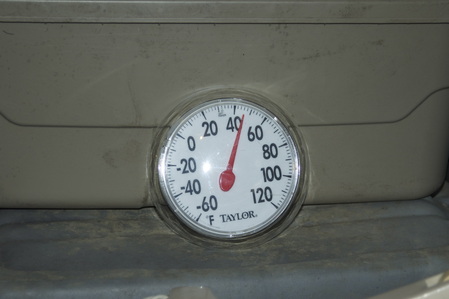
.
* * * *
Have Fun - Volunteer!
Madison recommends getting involved in a worthwhile cause by volunteering. Opportunities that will interest you may be closer that you think. Here's one that we enjoy.
Holiday House - the Boylston Garden Club's annual wreath sale - is a fund raiser that helps provide plantings around town, and both educational programs and awards that foster horticulture. Garden Club members and volunteers enjoy working together to gather and prepare natural decorations, make bows, and decorate wreaths in preparation for this event.
Holiday House - the Boylston Garden Club's annual wreath sale - is a fund raiser that helps provide plantings around town, and both educational programs and awards that foster horticulture. Garden Club members and volunteers enjoy working together to gather and prepare natural decorations, make bows, and decorate wreaths in preparation for this event.
* * * *
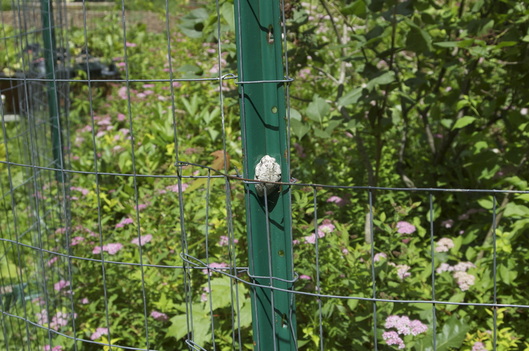
Closer Inspection
A quick glance might not be enough to pick out this fellow.
A quick glance might not be enough to pick out this fellow.
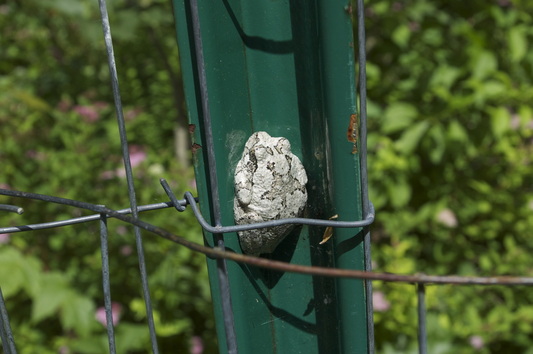
Upon closer inspection . . .
This Eastern Gray Tree Frog visited us on June 22nd. He thought that the indentation in this fence post made a good spot to take a nap.
Copy and paste this address to hear his song:
http://www.in.gov/dnr/fishwild/files/treefrog.WAV
or
click on the address below the picture.
This Eastern Gray Tree Frog visited us on June 22nd. He thought that the indentation in this fence post made a good spot to take a nap.
Copy and paste this address to hear his song:
http://www.in.gov/dnr/fishwild/files/treefrog.WAV
or
click on the address below the picture.
* * * *

A Well-Deserved Rest
Kierra has trouble keeping her eyes open after a busy day hunting for mice and moles.
Northern Flickers Visit
Northern Flicker - These striking birds visited us as they migrated this year. Unlike other woodpeckers, they often feed on the ground - hunting for ants and beetles. They dig with their slightly curved bills, and use their long tongues to "lap up" what they find! Scroll down to "audio" on this page to hear a Northern Flicker: http://animals.nationalgeographic.com/animals/birding/northern-flicker/
* * * *
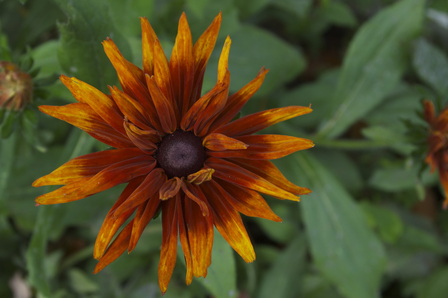
Deepening Shades of Fall
Many of us who grow flowers would agree that the colors deepen in the fall.
Many of us who grow flowers would agree that the colors deepen in the fall.
* * * *
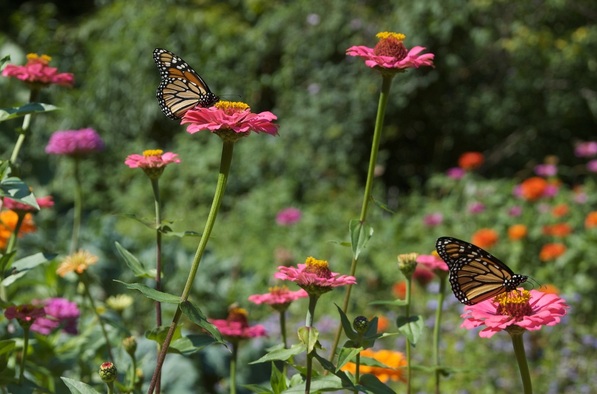
Monarchs Fly South
Our Monarch friends have left! The Audubon Society's website includes an article from the Butterfly Atlas Species Accounts that states:
Several generations of Monarchs occur in Massachusetts each season. Adults of the summer broods are on the wing for approximately three weeks while the final, late summer flight of migratory individuals may survive for up to nine months during which time they migrate to the central Mexican highlands and overwinter at several sites in the Transvolcanic Mountains. In March these same individuals begin the northward migration, normally reaching only the southern regions of North America, where they produce the next generation of Monarchs that will continue the migration northward.
That's a little over 2,250 miles - one way !!!!!!
Our Monarch friends have left! The Audubon Society's website includes an article from the Butterfly Atlas Species Accounts that states:
Several generations of Monarchs occur in Massachusetts each season. Adults of the summer broods are on the wing for approximately three weeks while the final, late summer flight of migratory individuals may survive for up to nine months during which time they migrate to the central Mexican highlands and overwinter at several sites in the Transvolcanic Mountains. In March these same individuals begin the northward migration, normally reaching only the southern regions of North America, where they produce the next generation of Monarchs that will continue the migration northward.
That's a little over 2,250 miles - one way !!!!!!
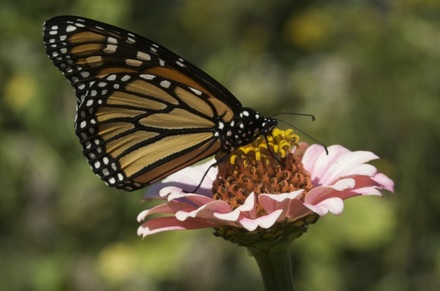
* * * *
* * * *
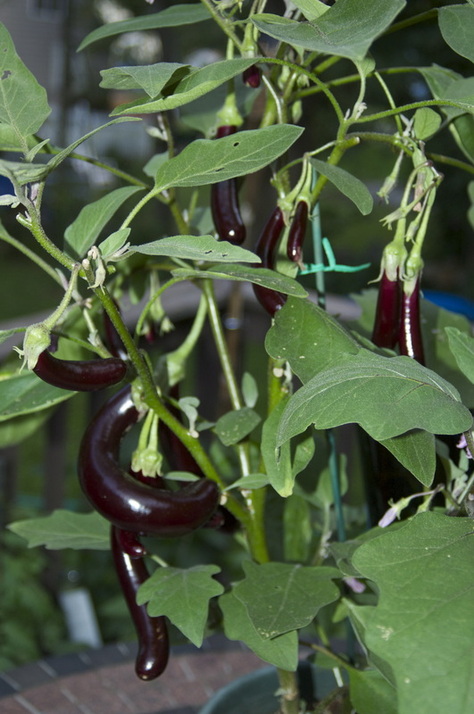
Fifteen Eggplant and Counting!
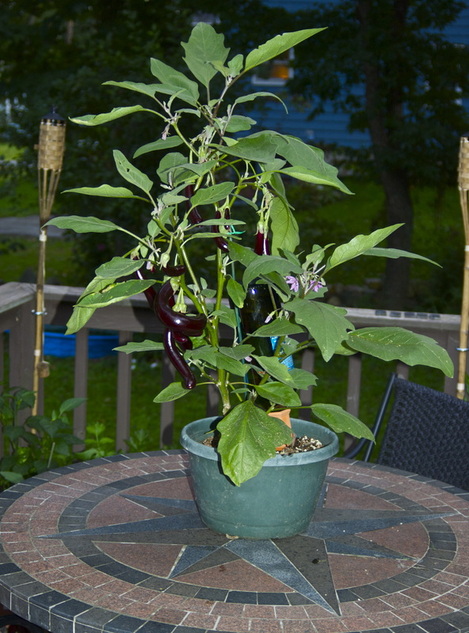
This plant currently has fifteen eggplants growing on it. Living in a container has clearly not impacted its productivity!!
Thank you for sharing, Brittany!
|
|
* * * *
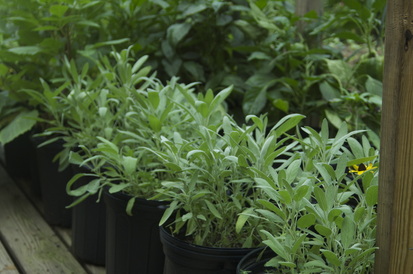
Sage Anyone?
Herbs grow very well in containers. These 3 gallon nursery pots are both economical and a very productive home for sage plants. They do need to be watered regularly - especially in hot weather, but the result of this slightly stressful environment is increased flavor. Bring your garden to your deck!
Herbs grow very well in containers. These 3 gallon nursery pots are both economical and a very productive home for sage plants. They do need to be watered regularly - especially in hot weather, but the result of this slightly stressful environment is increased flavor. Bring your garden to your deck!
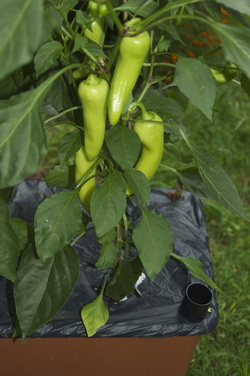
Peppers!
Seven crisp peppers are on this plant, which is one of six plants in this self-watering container. This container is on wheels - so it can be moved to a sunny location or brought closer for picking. A self-watering container needs minimal maintenance. The pipe on the lower right is where water is added to the reservoir in the bottom of the planter. A waterproof elasticized cover keeps rain from washing the fertilizer away, helps heat the soil because it is black and eliminates weeding.
Seven crisp peppers are on this plant, which is one of six plants in this self-watering container. This container is on wheels - so it can be moved to a sunny location or brought closer for picking. A self-watering container needs minimal maintenance. The pipe on the lower right is where water is added to the reservoir in the bottom of the planter. A waterproof elasticized cover keeps rain from washing the fertilizer away, helps heat the soil because it is black and eliminates weeding.
* * * *
What Have You Grown Successfully in Containers?
We would like to know what people have grown successfully in containers. Is it possible to garden even if it is difficult for you to leave your porch or deck?
If you have pictures or ideas please contact us at Woodlandridgefarm.com or just click on the "Contact Us" tab above so we can share them.
We would like to know what people have grown successfully in containers. Is it possible to garden even if it is difficult for you to leave your porch or deck?
If you have pictures or ideas please contact us at Woodlandridgefarm.com or just click on the "Contact Us" tab above so we can share them.
* * * *
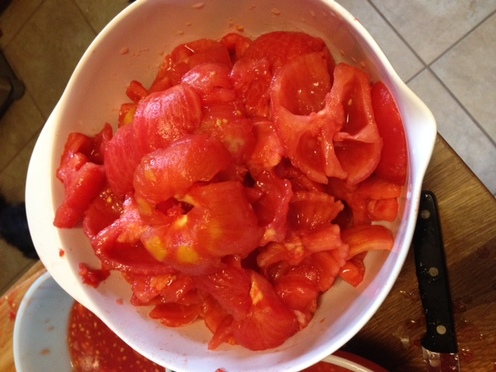
Wonderful, Fresh Tomato Sauce - With Room For Creativity
Fresh Tomato Sauce Yield: About 4 cups of sauce Thank you, Heather!
4 pounds of tomatoes,
1/4 cup olive oil
1 medium onion
2 to 3 small cloves of garlic
1/2 teaspoon salt plus more to taste
3 – 5 fresh basil leaves
Optional:
1/2 medium carrot
1/2 stalk of celery
Any other veggie that you would like to add to be creative
Blanch and peel the tomatoes. If you are new to blanching, simply bring a pot of water to a boil. Cut a small X at the bottom of each tomato. Place the tomatoes in the boiling water for 10 to 30 seconds, drop drained tomatoes into an ice water bath. Peel using a flat bladed paring knife.
Half each tomato and slip the seeds out into a colander. Save the juice. Coarsely chop the tomatoes.
Finely chop the onion, carrot, and celery or other veggies of your choice and mince the garlic.
Heat the olive oil in a large pot over medium heat. Cook onions, carrots, celery and garlic, (whichever you are using) until lightly browned, about 10 minutes. Add the chopped tomatoes and bring to a simmer, lowering the heat to medium-low to keep it at a gentle simmer. Simmer for 30 – 45 minutes - stirring occasionally.
The sauce may be thinned with the reserved tomato juice. Season with 1/2 teaspoon salt / to taste. Scatter with fresh basil leaves cut into thin strips, before serving.
This is a variation of an August 2010 post on Smitten Kitchen
4 pounds of tomatoes,
1/4 cup olive oil
1 medium onion
2 to 3 small cloves of garlic
1/2 teaspoon salt plus more to taste
3 – 5 fresh basil leaves
Optional:
1/2 medium carrot
1/2 stalk of celery
Any other veggie that you would like to add to be creative
Blanch and peel the tomatoes. If you are new to blanching, simply bring a pot of water to a boil. Cut a small X at the bottom of each tomato. Place the tomatoes in the boiling water for 10 to 30 seconds, drop drained tomatoes into an ice water bath. Peel using a flat bladed paring knife.
Half each tomato and slip the seeds out into a colander. Save the juice. Coarsely chop the tomatoes.
Finely chop the onion, carrot, and celery or other veggies of your choice and mince the garlic.
Heat the olive oil in a large pot over medium heat. Cook onions, carrots, celery and garlic, (whichever you are using) until lightly browned, about 10 minutes. Add the chopped tomatoes and bring to a simmer, lowering the heat to medium-low to keep it at a gentle simmer. Simmer for 30 – 45 minutes - stirring occasionally.
The sauce may be thinned with the reserved tomato juice. Season with 1/2 teaspoon salt / to taste. Scatter with fresh basil leaves cut into thin strips, before serving.
This is a variation of an August 2010 post on Smitten Kitchen
* * * *
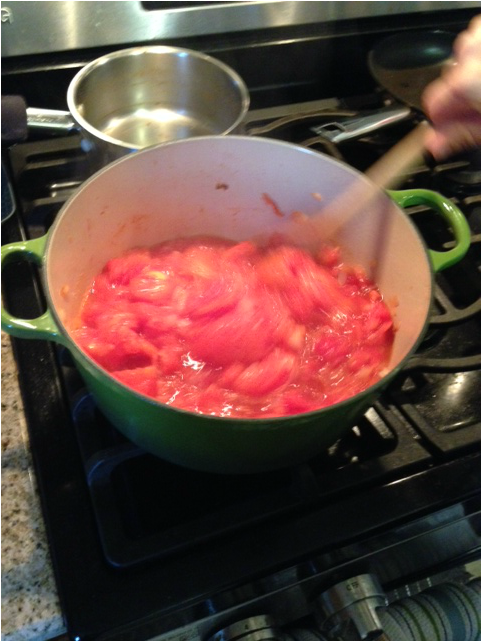
Now Is The Time To Make Fresh Tomato Sauce!!
Have you ever wondered if fresh homemade tomato sauce would be any different than what you find in a jar? Now is the time to experiment with the exciting, rich flavors of sauce made from scratch in your own kitchen.
Send your favorite recipe to us at [email protected]
Have you ever wondered if fresh homemade tomato sauce would be any different than what you find in a jar? Now is the time to experiment with the exciting, rich flavors of sauce made from scratch in your own kitchen.
Send your favorite recipe to us at [email protected]
* * * *
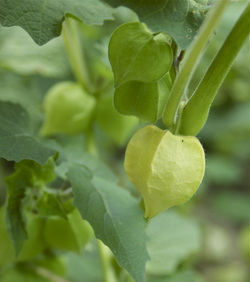
Try Husk Cherries
For a Unique Summer Treat!
Husk Cherries are also called ground cherries or cape gooseberries. They contain lots of vitamin C and fiber. They are wrapped in a "paper" wrapper that looks similar in shape to a Japanese lantern. The marble-sized fruit is ripe when it is a deep yellow/apricot color. They are delicious eaten fresh, but are also made into pies and preserves, frozen, canned or dipped in chocolate with the wrappers left folded back for grasping.
They grow well in containers as long as they are watered daily. Ripe fruit drops to the ground, so having them on your deck or back step helps with gathering. They store very well if left in the wrapper. Enjoy the adventure. . .
For a Unique Summer Treat!
Husk Cherries are also called ground cherries or cape gooseberries. They contain lots of vitamin C and fiber. They are wrapped in a "paper" wrapper that looks similar in shape to a Japanese lantern. The marble-sized fruit is ripe when it is a deep yellow/apricot color. They are delicious eaten fresh, but are also made into pies and preserves, frozen, canned or dipped in chocolate with the wrappers left folded back for grasping.
They grow well in containers as long as they are watered daily. Ripe fruit drops to the ground, so having them on your deck or back step helps with gathering. They store very well if left in the wrapper. Enjoy the adventure. . .
* * * *
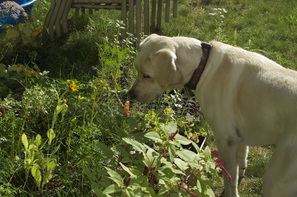
Empty Water Out of Your Seed Trays After Heavy Rains
Most people have their seed trays put away for another year. We are still planting and have some plants that we just can't part with. After the heavy rains of late we have a surprising new resident.
Madison has jumped several times when passing our trays of plants because she "heard" something.
Most people have their seed trays put away for another year. We are still planting and have some plants that we just can't part with. After the heavy rains of late we have a surprising new resident.
Madison has jumped several times when passing our trays of plants because she "heard" something.
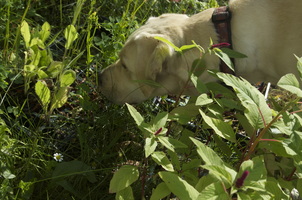
Yesterday she insisted "something" was in there.
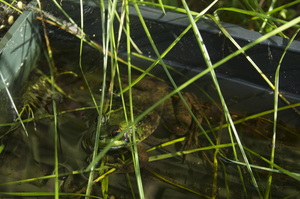
There were ripples in the water!
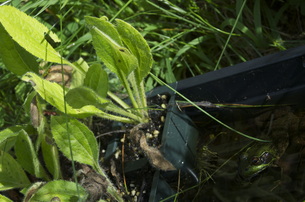
It couldn't be.
* * * *
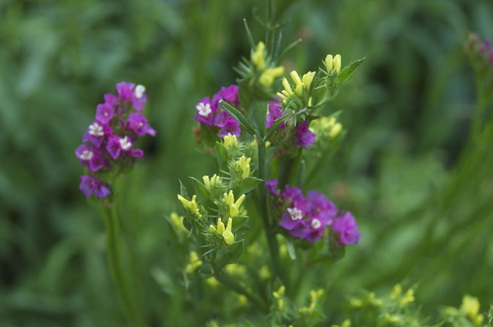
What Color Are These Flowers?
If you answered "yellow" or "purple" - you are close. . . .
This closeup may help. . . .
This closeup may help. . . .
Do you know now? Yes, they are white. The yellow and purple parts are called "bracts". Statice dries well and the bracts , kept out of bright sunlight, will keep their vibrant color for a year or more.
* * * *
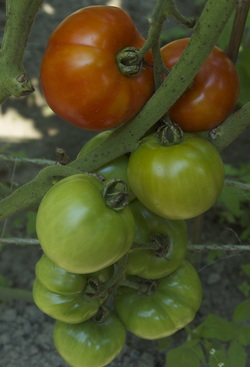
14 Reasons to Eat Tomatoes
They are:
1. low in Sodium
2. very low in Saturated Fat and Cholesterol
3. a good source of Vitamin E (Alpha Tocopherol),
They contain:
4. Thiamin,
5. Niacin,
6. Vitamin B6,
7. Folate,
8. Magnesium,Phosphorus and Copper
9. Dietary Fiber
10. Vitamins A, C and K
11. Potassium and Manganese.
12. Lycopene with its antioxidant properties that contribute to bone health and help protect us from cancer.
And:
13. They add color to your salad!
14. They taste good!
1. low in Sodium
2. very low in Saturated Fat and Cholesterol
3. a good source of Vitamin E (Alpha Tocopherol),
They contain:
4. Thiamin,
5. Niacin,
6. Vitamin B6,
7. Folate,
8. Magnesium,Phosphorus and Copper
9. Dietary Fiber
10. Vitamins A, C and K
11. Potassium and Manganese.
12. Lycopene with its antioxidant properties that contribute to bone health and help protect us from cancer.
And:
13. They add color to your salad!
14. They taste good!
* * * *
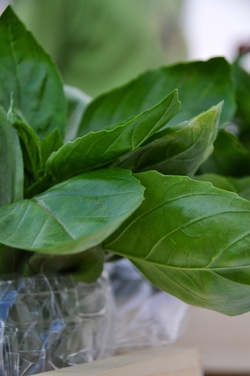
Extend the Life of Your Fresh Herbs
How can you keep your herbs fresh longer? Treat them like a bouquet of flowers. If they aren't already bunched, pick each stem up one at a time and put it with the rest of the stems being careful to line up the ends. Recut the bunch on an angle using sharp clean shears or a knife. Put them in a clean glass of warm water with no leaves touching the water. They can be kept this way on the counter in the kitchen for a week - easily. Some may even grow roots while waiting to spice up your cuisine!
How can you keep your herbs fresh longer? Treat them like a bouquet of flowers. If they aren't already bunched, pick each stem up one at a time and put it with the rest of the stems being careful to line up the ends. Recut the bunch on an angle using sharp clean shears or a knife. Put them in a clean glass of warm water with no leaves touching the water. They can be kept this way on the counter in the kitchen for a week - easily. Some may even grow roots while waiting to spice up your cuisine!
* * * *
What Can You Do With a Wooden Pallet To Enjoy Gardening If You Can't Kneel or Bend Easily?
We'd love to hear your ideas. Click on "Contact Us" above or email us directly at [email protected], and send us your suggestions and photos!
We'd love to hear your ideas. Click on "Contact Us" above or email us directly at [email protected], and send us your suggestions and photos!
* * * *
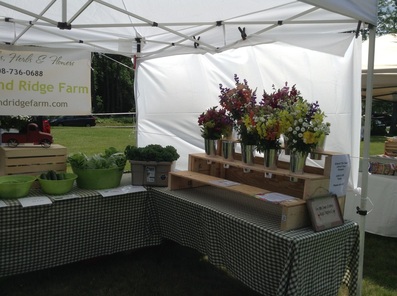
Enjoying the Westminster Farmers' Market!
We are delighted to be part of the Westminster Farmers' Market on Academy Hill.
We are delighted to be part of the Westminster Farmers' Market on Academy Hill.
* * * *
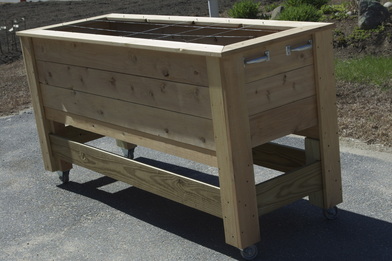
Think Gardening Isn't For You?
Knee Replacement?
Reduced Energy or Stamina?
Use a Wheelchair?
Trouble Kneeling?
Recovering From Surgery?
Think Again!
There are many approaches to gardening that capitalize on your current strengths and abilities. We believe that everyone, including those with limited mobility, can garden and experience its therapeutic benefits!!
If kneeling doesn't work for you - bring the garden up to a comfortable level. One approach is to garden in a raised bed. This is a beautiful one at the Groton Senior Center. It also has the benefit of being on wheels. It has already been set up for Square Foot Gardening (originated by Mel Bartholomew) which allows the gardener to plant things closer together and produce much more than in a similarly sized row garden.
Knee Replacement?
Reduced Energy or Stamina?
Use a Wheelchair?
Trouble Kneeling?
Recovering From Surgery?
Think Again!
There are many approaches to gardening that capitalize on your current strengths and abilities. We believe that everyone, including those with limited mobility, can garden and experience its therapeutic benefits!!
If kneeling doesn't work for you - bring the garden up to a comfortable level. One approach is to garden in a raised bed. This is a beautiful one at the Groton Senior Center. It also has the benefit of being on wheels. It has already been set up for Square Foot Gardening (originated by Mel Bartholomew) which allows the gardener to plant things closer together and produce much more than in a similarly sized row garden.
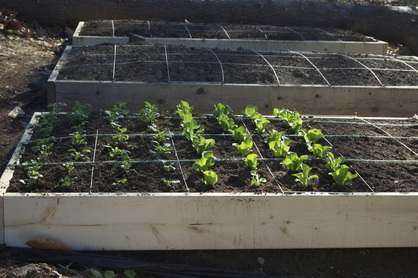
A much simpler (and cheaper) version of a raised bed is built directly on the ground. Its height can vary widely. Some people only need the enriched soft soil of an eight inch tall bed. This takes much less effort to plant in because you never walk on the soil and compress it; nearly eliminates weeding if the soil is a mix of perlite, peat moss and compost; and can be built close to your house.
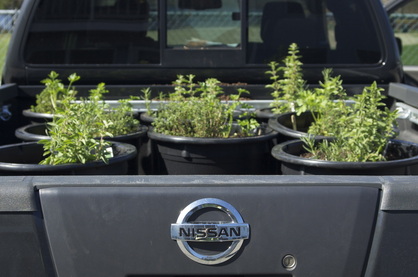
A container garden can be placed on a deck or right beside the back door. There are two basic types of containers - traditional and self-watering. Each has its pros and cons and most plants have a definite preference. An excellent resource for learning about gardening in containers is The Vegetable Gardener's Container Bible by Edward C. Smith. Many herbs grow well in "pots" and some have better flavor when living in the slightly stressful traditional container environment.
Herb gardens in 5 gallon containers being delivered to senior meal preparation sites.
Herb gardens in 5 gallon containers being delivered to senior meal preparation sites.
We will feature other ideas for gardening with limited mobility. Feel free to contact us for more information about accessible gardening.
* * * *
* * * *
Why Keep Bees?
Another group of WORKERS that can help INCREASE your garden production.
Bees are good for your garden. They work very hard and one benefit of that diligence is pollination of flowers and vegetables that can help increase garden yield. Bee keeping is not for everyone, and it is important to have proper training and mentoring when first starting out. Many people in our area join the Worcester County Beekeepers Association and take classes at the University of Massachusetts Medical School in Worcester. WCBA has been holding bee school for the past 72 years. The most recent began March 6th, 2014. After eight Thursday nights in a row, you begin to have a reasonable idea of what it takes to do a proper job enlisting these energetic workers to join your gardening team.
According to the United States Department of Agriculture, “About one mouthful in three in the diet directly or indirectly benefits from honeybee pollination.” http://www.ars.usda.gov/News/docs.htm?docid=15572#public
How to learn more about the art of apiculture: http://worcestercountybeekeepers.com/index.php/bee-school
Another group of WORKERS that can help INCREASE your garden production.
Bees are good for your garden. They work very hard and one benefit of that diligence is pollination of flowers and vegetables that can help increase garden yield. Bee keeping is not for everyone, and it is important to have proper training and mentoring when first starting out. Many people in our area join the Worcester County Beekeepers Association and take classes at the University of Massachusetts Medical School in Worcester. WCBA has been holding bee school for the past 72 years. The most recent began March 6th, 2014. After eight Thursday nights in a row, you begin to have a reasonable idea of what it takes to do a proper job enlisting these energetic workers to join your gardening team.
According to the United States Department of Agriculture, “About one mouthful in three in the diet directly or indirectly benefits from honeybee pollination.” http://www.ars.usda.gov/News/docs.htm?docid=15572#public
How to learn more about the art of apiculture: http://worcestercountybeekeepers.com/index.php/bee-school
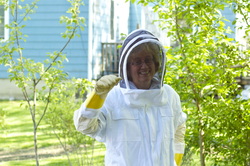
Matt Agrees to Introduce Me To His New Hive Of Bees. We suit up in appropriate attire.
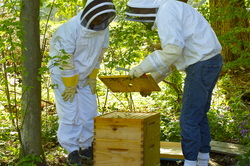
He takes off the cover and carefully removes a frame from the honey super.
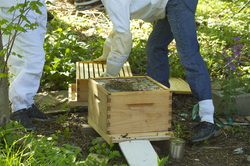
Off comes the super.
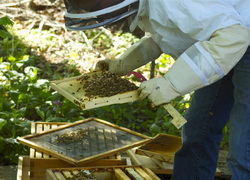
Matt Checks to See if the New Queen is Laying Eggs. Success!!! There are eggs!
Hmmm. . . now where is that QUEEN???
Can you see her in the second picture?
Hmmm. . . now where is that QUEEN???
Can you see her in the second picture?
* * * *
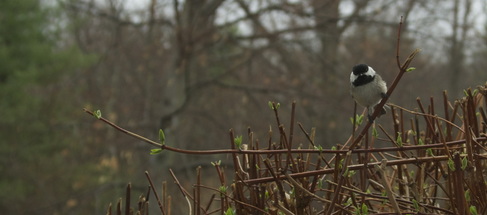
Why Attract Birds To Your Garden?
Birds are a huge asset to the gardener. We plant shrubs and flowers that attract them, offer water and provide food during lean months of the year to keep our birds a happy part of our farming "family". A few of our favorites are:
Black-capped Chickadees
We enjoy the company of these birds all through the snowy days of winter. They eat the seeds at our feeder that augments their diet until they switch to their almost 90% insect summer diet. Once the female sits on the nest and during the two-plus weeks that the young are in the nest - the male will make 200 - 300 trips to the nest daily, bringing them larvae, insects and insect eggs. He even checks under leaves for hiding eggs. This continues after the young are on their own while they are learning to find their own food.
Phoebes
We are thrilled each year when the Phoebes return and build their nest under the overhang of our back roof. They are great allies and consume many insects and pests including both 12-spotted and striped cucumber beetles, leaf miners, caterpillars and ticks (which Madison especially appreciates). Their diet is almost entirely insects. I enjoy watching their erratic tail bobbing as they perch between catching flights.
Baltimore Orioles
These beautiful birds eat insects during the summer, and especially enjoy caterpillar larvae. They switch to dark-colored fruit in the fall and prefer the native fruits that we plant (to encourage them to continue to build their incredible silky hanging baskets high in the trees). We have recently added serviceberries ( shadbush) to the chokecherries and wild concord grapes that grow in our area.
Barn Swallows
It doesn't take long for the barn swallows to hear the hum of a tiller. They will arrive in short order to swoop over newly tilled soil to scoop up flying insects that have been disturbed. (I'm not sure who arrives faster - the swallows in the fields or Madison when she hears the click of a knife on our kitchen cutting board.) The swallows' voracious appetites are appreciated while they display their beautiful aerial acrobatics. The flashes of iridescent blue and their deeply forked tails make them even more exciting to watch.
The bug picking team is reassembling at the farm!
* * * *
Birds are a huge asset to the gardener. We plant shrubs and flowers that attract them, offer water and provide food during lean months of the year to keep our birds a happy part of our farming "family". A few of our favorites are:
Black-capped Chickadees
We enjoy the company of these birds all through the snowy days of winter. They eat the seeds at our feeder that augments their diet until they switch to their almost 90% insect summer diet. Once the female sits on the nest and during the two-plus weeks that the young are in the nest - the male will make 200 - 300 trips to the nest daily, bringing them larvae, insects and insect eggs. He even checks under leaves for hiding eggs. This continues after the young are on their own while they are learning to find their own food.
Phoebes
We are thrilled each year when the Phoebes return and build their nest under the overhang of our back roof. They are great allies and consume many insects and pests including both 12-spotted and striped cucumber beetles, leaf miners, caterpillars and ticks (which Madison especially appreciates). Their diet is almost entirely insects. I enjoy watching their erratic tail bobbing as they perch between catching flights.
Baltimore Orioles
These beautiful birds eat insects during the summer, and especially enjoy caterpillar larvae. They switch to dark-colored fruit in the fall and prefer the native fruits that we plant (to encourage them to continue to build their incredible silky hanging baskets high in the trees). We have recently added serviceberries ( shadbush) to the chokecherries and wild concord grapes that grow in our area.
Barn Swallows
It doesn't take long for the barn swallows to hear the hum of a tiller. They will arrive in short order to swoop over newly tilled soil to scoop up flying insects that have been disturbed. (I'm not sure who arrives faster - the swallows in the fields or Madison when she hears the click of a knife on our kitchen cutting board.) The swallows' voracious appetites are appreciated while they display their beautiful aerial acrobatics. The flashes of iridescent blue and their deeply forked tails make them even more exciting to watch.
The bug picking team is reassembling at the farm!
* * * *
